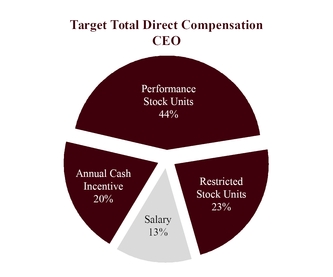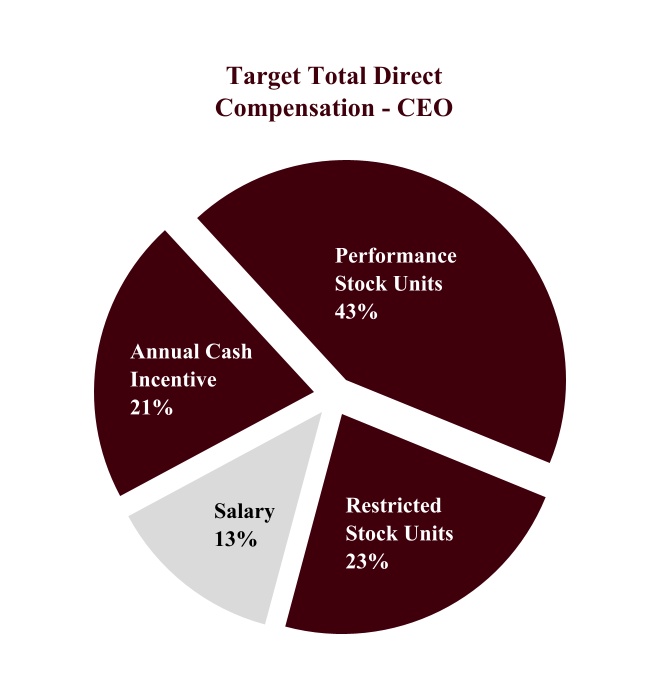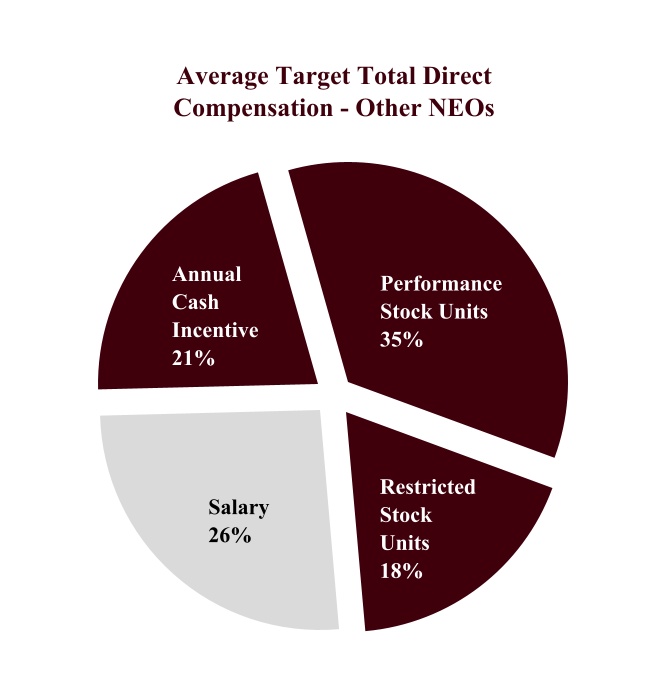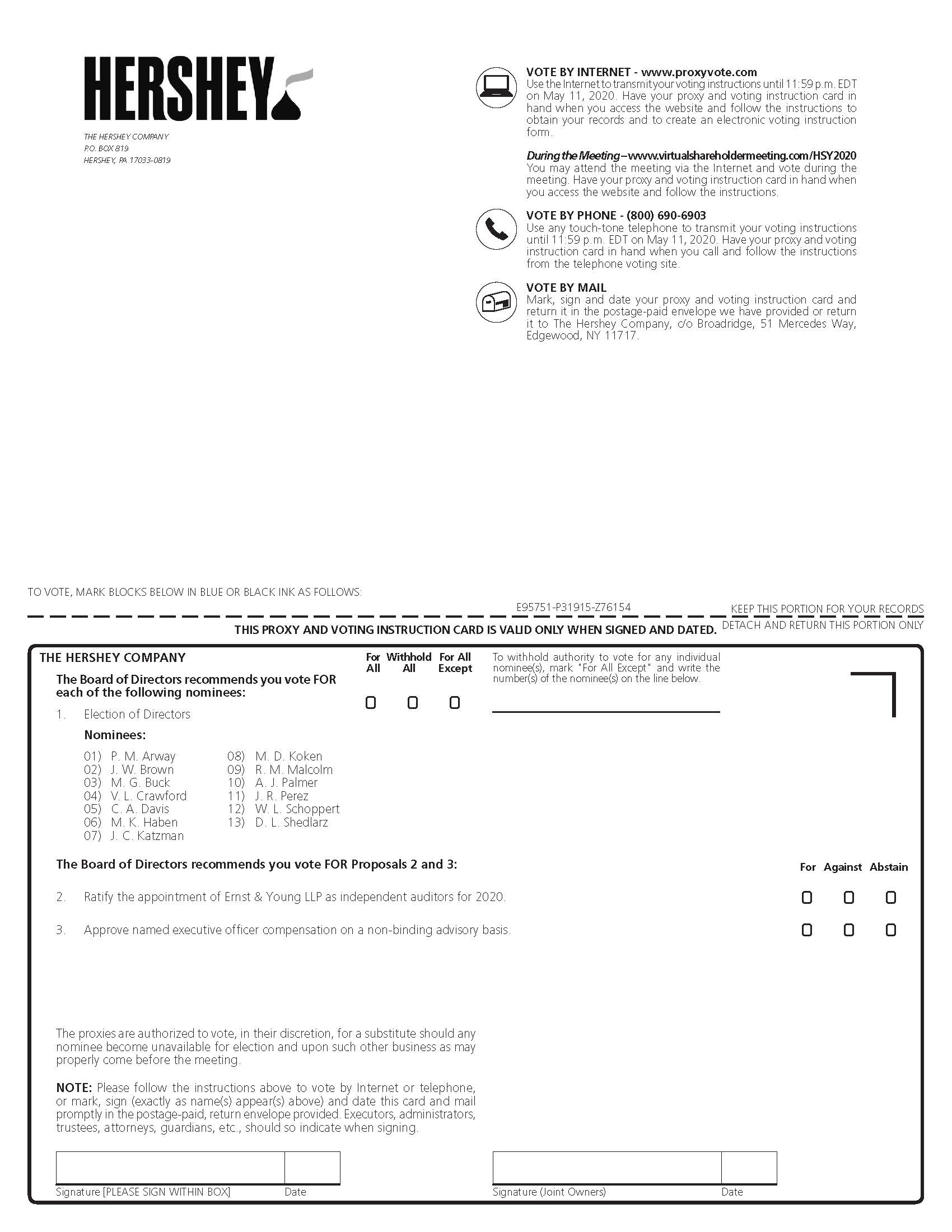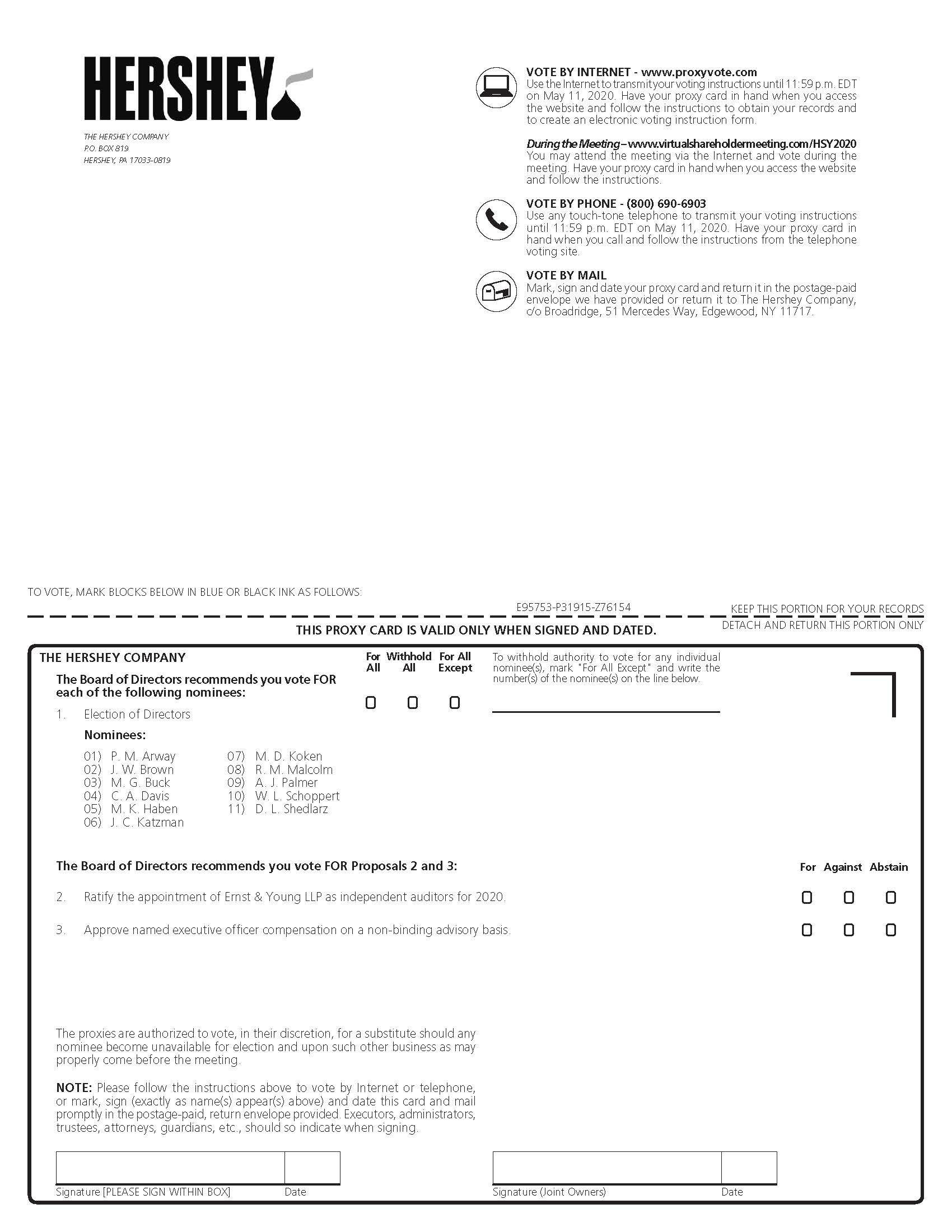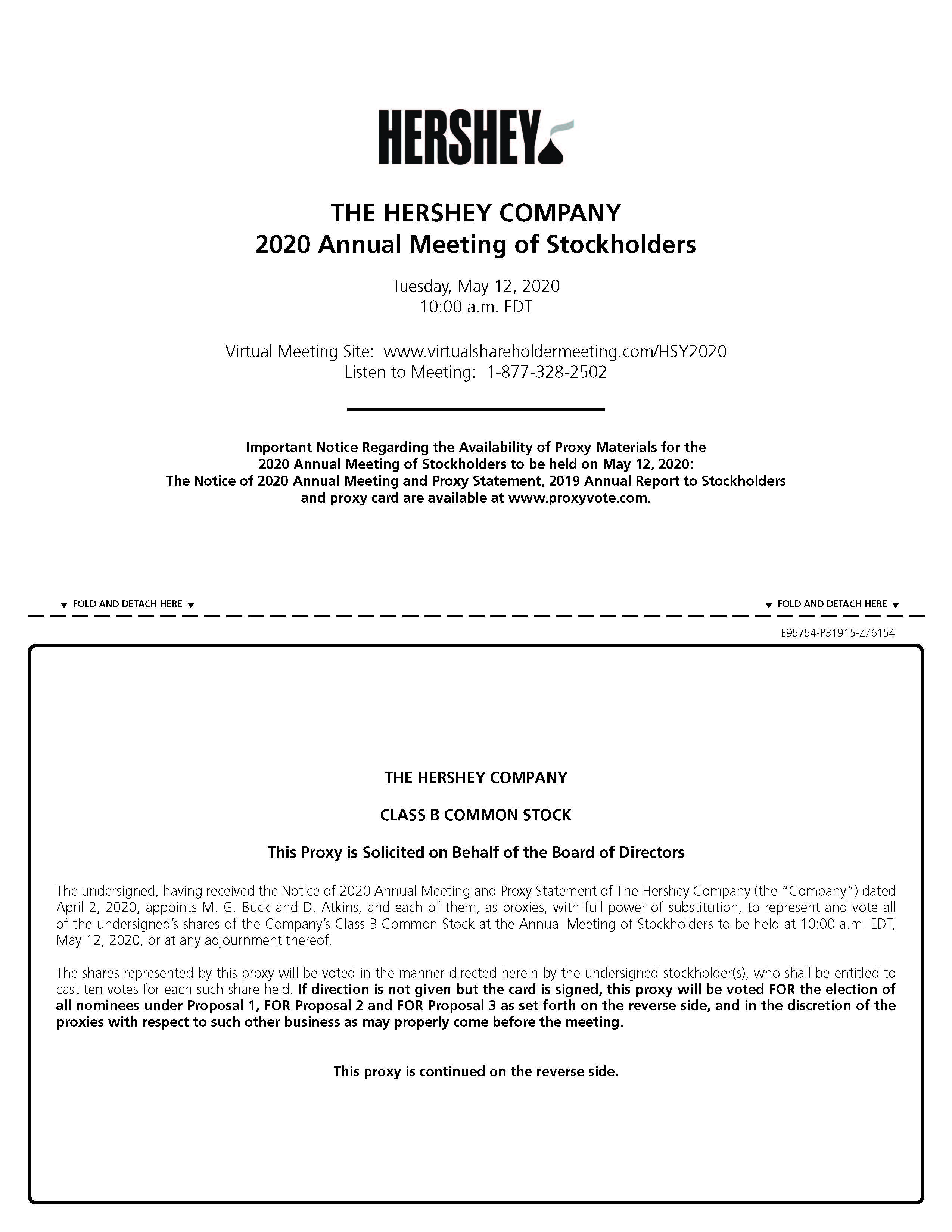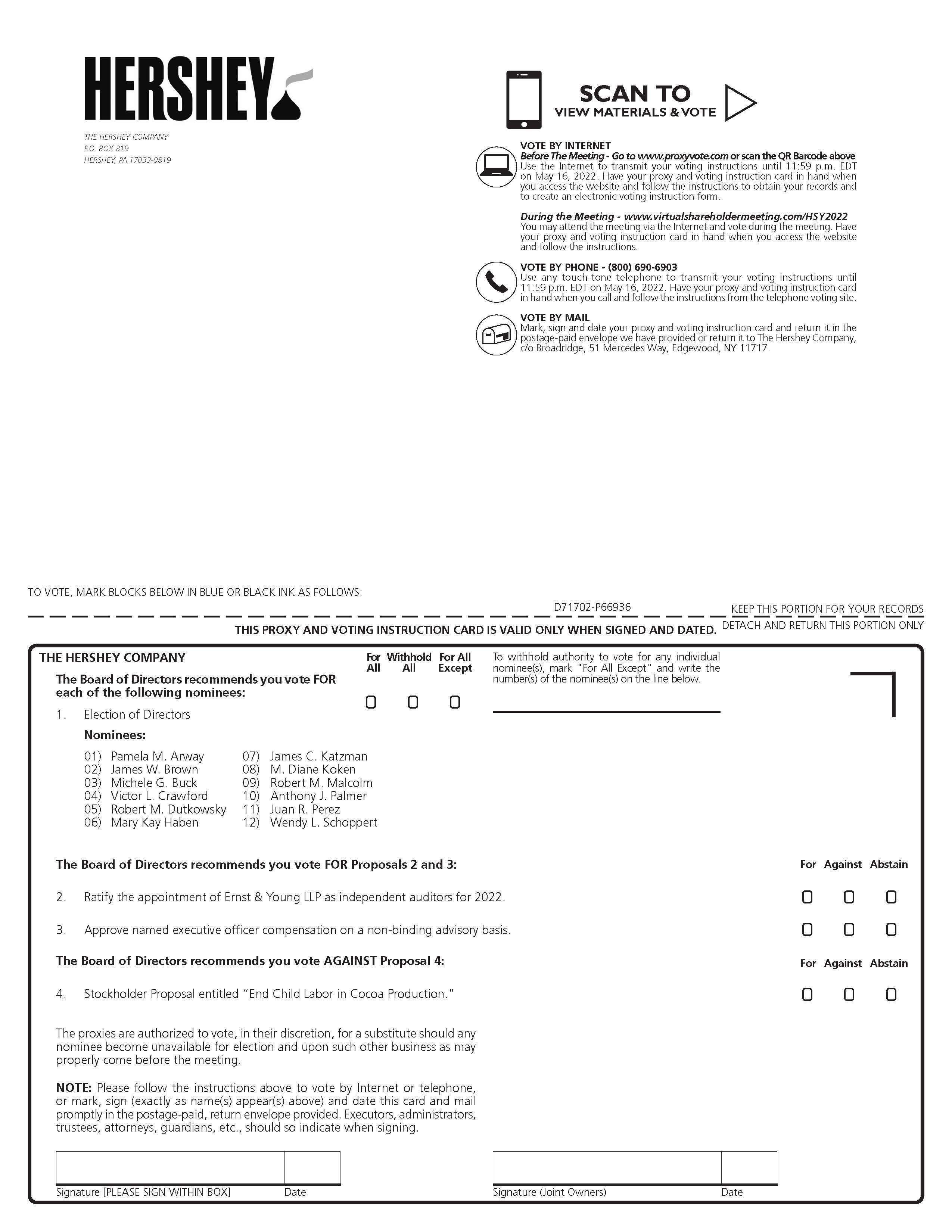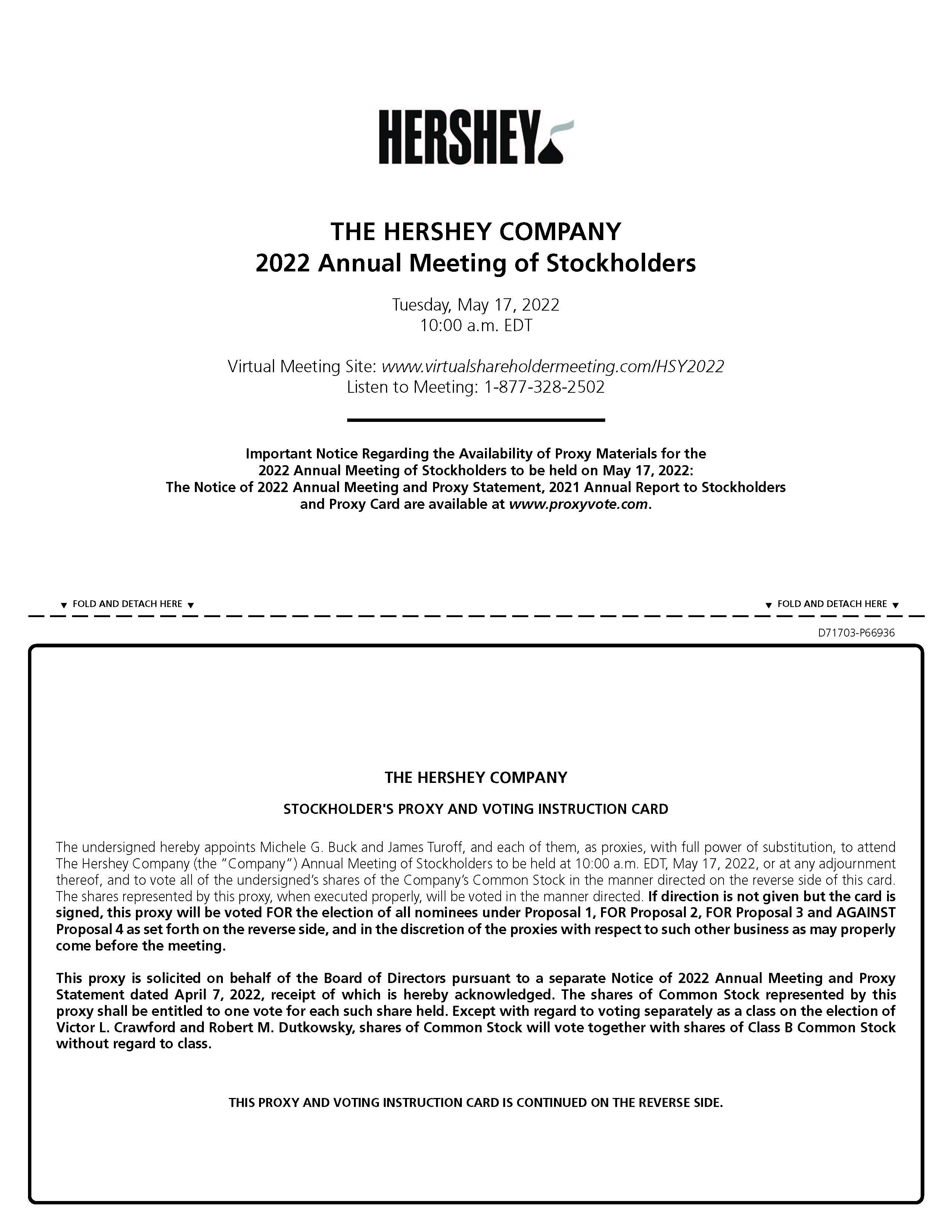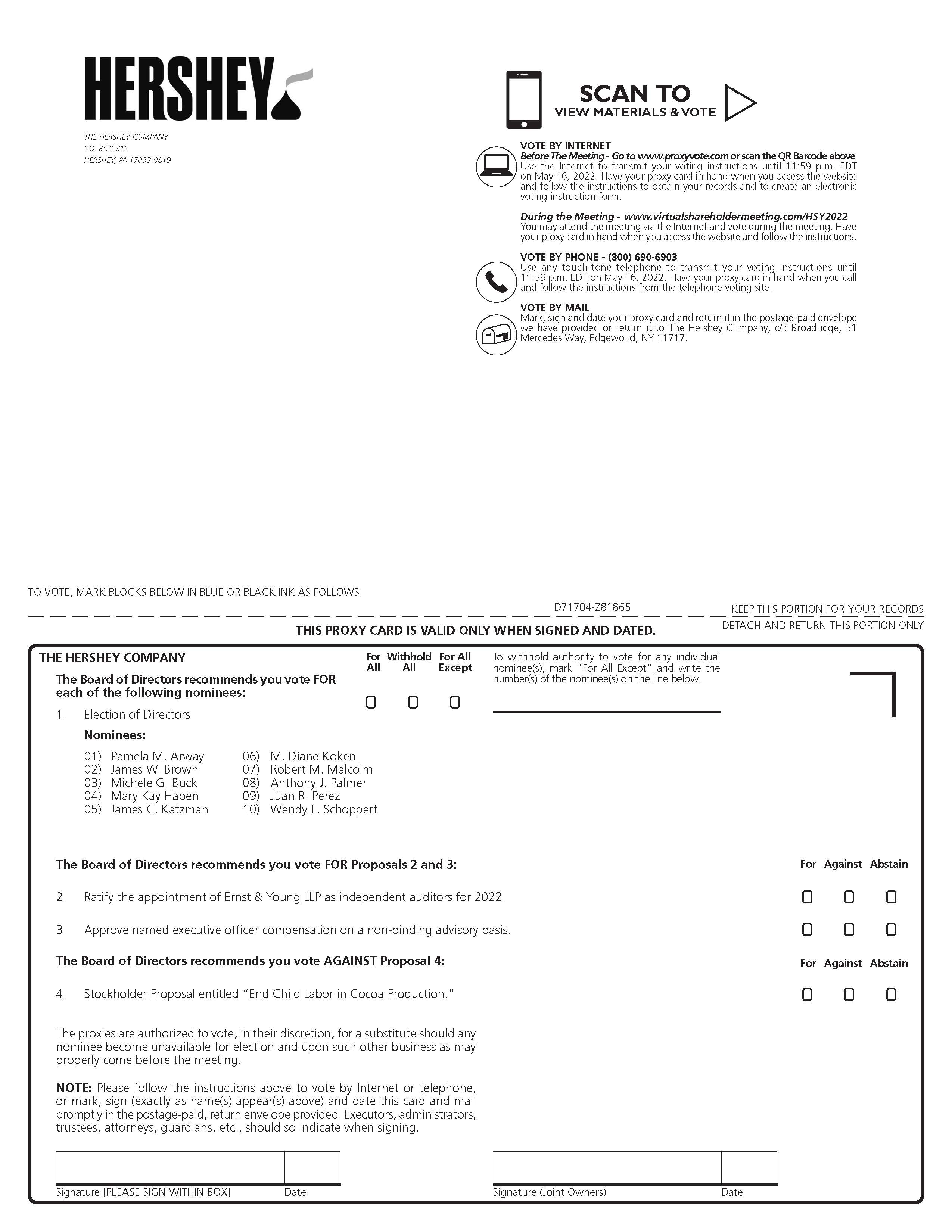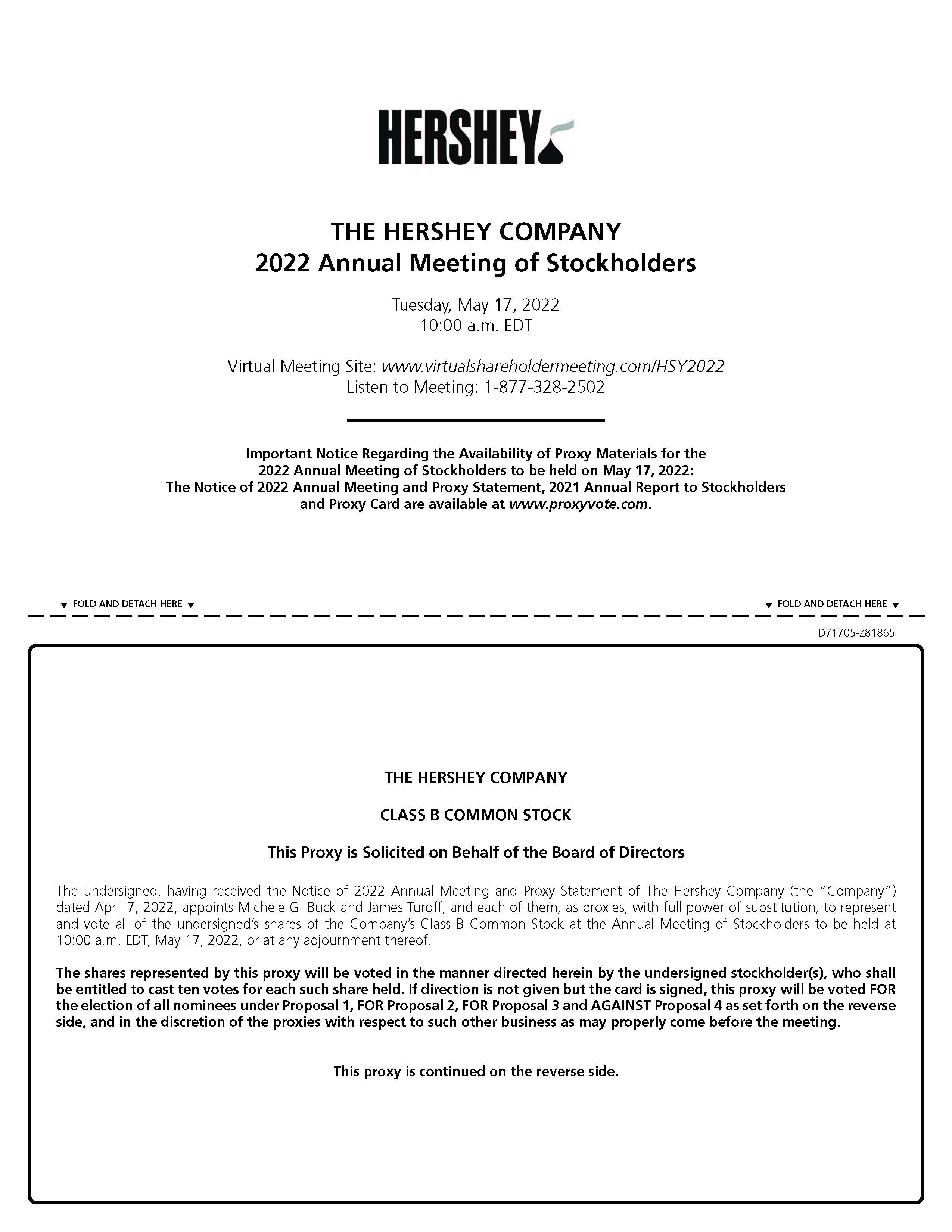UNITED STATES
SECURITIES AND EXCHANGE COMMISSION
Washington, D.C. 20549
SCHEDULE 14A
Proxy Statement Pursuant to Section 14(a) of the
Securities Exchange Act of 1934
(Amendment No. )
Filed by the Registrant X Filed by a Party other than the Registrant ☐
Check the appropriate box:
| ☐ | Preliminary Proxy Statement | ||||
| ☐ | Confidential, for Use of the Commission Only (as permitted by Rule 14a-6(e)(2)) | ||||
| X | Definitive Proxy Statement | ||||
| ☐ | Definitive Additional Materials | ||||
| ☐ | Soliciting Material Pursuant to §240.14a-12 | ||||

The Hershey Company
(Name of Registrant as Specified In Its Charter)
(Name of Person(s) Filing Proxy Statement, if other than the Registrant)
Payment of Filing Fee (Check the appropriate box):
| X | No fee required. | ||||
| ☐ | Fee computed on table below per Exchange Act Rules 14a-6(i)(1) and 0-11. | ||||
(1)Title of each class of securities to which transaction applies:
(2)Aggregate number of securities to which transaction applies:
(3)Per unit price or other underlying value of transaction computed pursuant to Exchange Act Rule 0-11 (set forth the amount on which the filing fee is calculated and state how it was determined):
(4)Proposed maximum aggregate value of transaction:
(5)Total fee paid:
| ☐ | Fee paid previously with preliminary materials. | ||||
| ☐ | Check box if any part of the fee is offset as provided by Exchange Act Rule 0-11(a)(2) and identify the filing for which the offsetting fee was paid previously. Identify the previous filing by registration statement number, or the Form or Schedule and the date of its filing. | ||||
(1)Amount Previously Paid:
(2)Form, Schedule or Registration Statement No.:
(3)Filing Party:
(4)Date Filed:


| Notice of | ||
Tuesday, May 12, 202017, 2022
10:00 a.m., Eastern Daylight Time
The 20202022 Annual Meeting of Stockholders (the “Annual Meeting”) of The Hershey Company (the(“Hershey” or the “Company”) will be held on Tuesday, May 12, 2020,17, 2022, beginning at 10:00 a.m., Eastern Daylight Time. Due to the ongoing public health impact of the novel coronavirus outbreak (COVID-19),pandemic, this year’s Annual Meeting will again be a virtual meeting conducted solely via live webcast. You will be able to attend the Annual Meeting, vote your shares electronically and submit questions during the meeting by visiting www.virtualshareholdermeeting.com/HSY2020HSY2022. You may also listen to the meeting by calling 1-877-328-2502. You will not be able to attend the Annual Meeting in person. Additional information regarding attending the Annual Meeting, voting your shares and submitting questions can be found in the Proxy Statement.
The purposes of the meeting are as follows:
| To elect the | |||||
| 2. | To ratify the appointment of Ernst & Young LLP as the Company’s independent auditors for the fiscal year ending December 31, | ||||
| 3. | To conduct an advisory vote regarding the compensation of the Company’s named executive officers; | ||||
| 4. | To consider the stockholder proposal set forth in the Proxy Statement, if properly presented at the Annual Meeting; and | ||||
| 5. | To discuss and take action on any other business that is properly brought before the Annual Meeting. | ||||
The Proxy Statement accompanying this Notice of 20202022 Annual Meeting of Stockholders describes each of these items in detail. The Proxy Statement contains other important information that you should read and consider before you vote.
The Board of Directors of the Company has established the close of business on March 13, 202018, 2022 as the record date for determining the stockholders who are entitled to notice of, and to vote at, the Annual Meeting and any adjournment or postponement thereof.
The Company is furnishing proxy materials to its stockholders through the Internetinternet as permitted under the rules of the Securities and Exchange Commission. Under these rules, many of the Company’s stockholders will receive a Notice of Internet Availability of Proxy Materials instead of a paper copy of the Notice of 20202022 Annual Meeting of Stockholders and Proxy Statement, our proxy card, and our Annual Report on Form 10-K. We believe this process gives us the opportunity to serve you more efficiently by making the proxy materials available quickly online and reducing costs associated with printing and postage. Stockholders who do not receive a Notice of Internet Availability of Proxy Materials will receive a paper copy of the proxy materials by mail.
By order of the Board of Directors,


Senior Vice President,
General Counsel and Secretary
April 2, 20207, 2022
Your vote is important. Instructions on how to vote are contained in our Proxy Statement and in the Notice of Internet Availability of Proxy Materials. Please cast your vote by telephone or over the Internetinternet as described in those materials. Alternatively, if you requested a copy of the proxy/voting instruction card by mail, you may mark, sign, date and return the proxy/voting instruction card in the envelope provided.
TABLE OF CONTENTS
Page
| NOTICE OF | ||||||
| PROXY STATEMENT SUMMARY | ||||||
| PROXY STATEMENT | ||||||
i
ii

| Proxy Statement Summary | ||
| Date and Time: | Tuesday, May | |||||||
| 10:00 a.m., Eastern Daylight Time | ||||||||
| Meeting Access: | ||||||||
| Record Date: | March | |||||||
VOTING MATTERS AND BOARD RECOMMENDATIONS
Voting Matter | Board Vote Recommendation | Page Number with More Information | |||||||||
Proposal 1: | Election of Directors | FOR each nominee | |||||||||
Proposal 2: | Ratification of Appointment of Independent Auditors | FOR | |||||||||
Proposal 3: | Advise on Named Executive Officer Compensation | FOR | |||||||||
| Proposal 4: | Stockholder Proposal | AGAINST | |||||||||
This Proxy Statement Summary contains highlights of certain information in this Proxy Statement. Because it is only a summary, it does not contain all the information that you should consider prior to voting. Please review the complete Proxy Statement and the Company’s 20192021 Annual Report on Form 10-K that accompanies the Proxy Statement for additional information.
1
OUR DIRECTOR NOMINEES
You have the opportunity to vote on the election of the following 1312 nominees for director. Additional information regarding each director nominee’s experience, skills and qualifications to serve as a member of the Company’s Board of Directors (the “Board”) can be found in the Proxy Statement under Proposal No. 1 – Election of Directors.
Name | Age | Years on Board | Position | Independent | Committee Memberships* | Name | Age | Years on Board | Position | Independent | Committee Memberships* | |||||||||||
| Pamela M. Arway | 66 | 10 | Former President, Japan/Asia Pacific/Australia Region, American Express International, Inc. | Yes | Compensation Finance & Risk | Pamela M. Arway | 68 | 12 | Former President, Japan/Asia Pacific/ Australia Region, American Express International, Inc. | Yes | Compensation+ Executive Finance & Risk | |||||||||||
| James W. Brown | 68 | 3 | Director, Hershey Trust Company; Member, Board of Managers, Milton Hershey School | Yes | Audit Governance | James W. Brown | 70 | 5 | Director, Hershey Trust Company; Member, Board of Managers, Milton Hershey School | Yes | Audit Governance | |||||||||||
| Michele G. Buck** | 58 | 3 | Chairman of the Board, President and Chief Executive Officer, The Hershey Company | No | Executive+ | Michele G. Buck** | 60 | 5 | Chairman of the Board, President and Chief Executive Officer, The Hershey Company | No | Executive+ | |||||||||||
| Victor L. Crawford | 58 | 0 | Chief Executive Officer, Pharmaceutical Segment, Cardinal Health, Inc. | Yes | None | Victor L. Crawford | 60 | 2 | Chief Executive Officer, Pharmaceutical Segment, Cardinal Health, Inc. | Yes | Audit Compensation | |||||||||||
| Charles A. Davis*** | 71 | 13 | Chief Executive Officer, Stone Point Capital LLC | Yes | Audit**** Compensation**** Executive Finance & Risk**** Governance | |||||||||||||||||
| Robert M. Dutkowsky | Robert M. Dutkowsky | 67 | 2 | Former Executive Chairman and Chief Executive Officer, Tech Data Corporation | Yes | Finance & Risk Governance | ||||||||||||||||
| Mary Kay Haben | 63 | 7 | Former President, North America, Wm. Wrigley Jr. Company | Yes | Compensation Executive Governance+ | Mary Kay Haben | 65 | 9 | Former President, North America, Wm. Wrigley Jr. Company | Yes | Compensation Executive Governance+ | |||||||||||
| James C. Katzman | 52 | 2 | Director, Hershey Trust Company; Member, Board of Managers, Milton Hershey School | Yes | Finance & Risk Governance | James C. Katzman | 54 | 4 | Director, Hershey Trust Company; Member, Board of Managers, Milton Hershey School; Senior Vice President, Business Development, General Electric Company | Yes | Finance & Risk Governance | |||||||||||
| M. Diane Koken | 67 | 3 | Director, Hershey Trust Company; Member, Board of Managers, Milton Hershey School | Yes | Audit Compensation | M. Diane Koken | 69 | 5 | Chairman of the Board, Hershey Trust Company and Milton Hershey School | Yes | Audit Compensation | |||||||||||
| Robert M. Malcolm | 67 | 9 | Former President, Global Marketing, Sales & Innovation, Diageo PLC | Yes | Audit Executive Finance & Risk+ | Robert M. Malcolm | 69 | 11 | Former President, Global Marketing, Sales & Innovation, Diageo PLC | Yes | Audit Executive Finance & Risk+ | |||||||||||
| Anthony J. Palmer | 60 | 9 | Chief Executive Officer, TropicSport | Yes | Compensation+ Executive Governance | |||||||||||||||||
| Anthony J. Palmer*** | Anthony J. Palmer*** | 62 | 11 | Chief Executive Officer, TropicSport | Yes | Audit**** Compensation Executive Finance & Risk**** Governance**** | ||||||||||||||||
| Juan R. Perez | 53 | 1 | Chief Information and Engineering Officer, United Parcel Service, Inc. | Yes | Compensation Finance & Risk | Juan R. Perez | 55 | 3 | Executive Vice President and Chief Information Officer, Salesforce.com, Inc. | Yes | Finance & Risk Governance | |||||||||||
| Wendy L. Schoppert | 53 | 3 | Former Executive Vice President and Chief Financial Officer, Sleep Number Corporation | Yes | Audit Finance & Risk | Wendy L. Schoppert | 55 | 5 | Former Executive Vice President and Chief Financial Officer, Sleep Number Corporation | Yes | Audit+ Executive Finance & Risk | |||||||||||
| David L. Shedlarz | 71 | 12 | Former Vice Chairman, Pfizer Inc. | Yes | Audit+ Executive Finance & Risk | |||||||||||||||||
____________________
Over 50% of director nominees are diverse
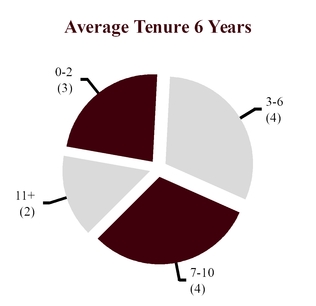



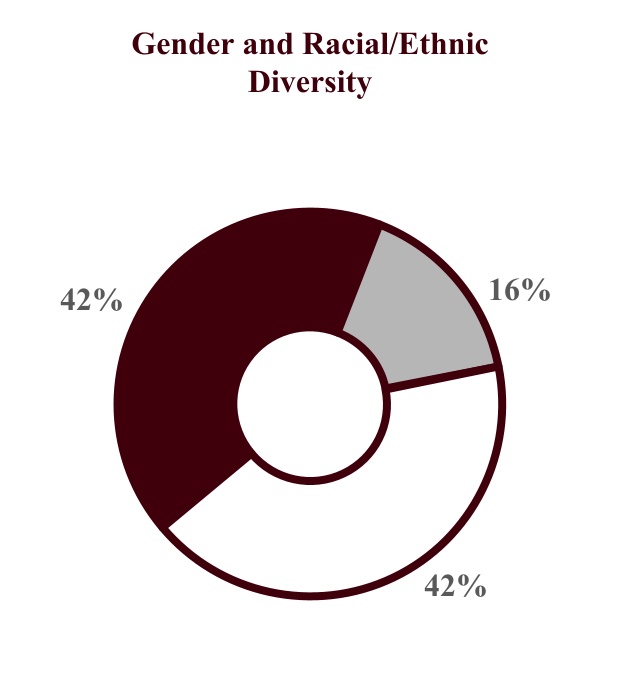
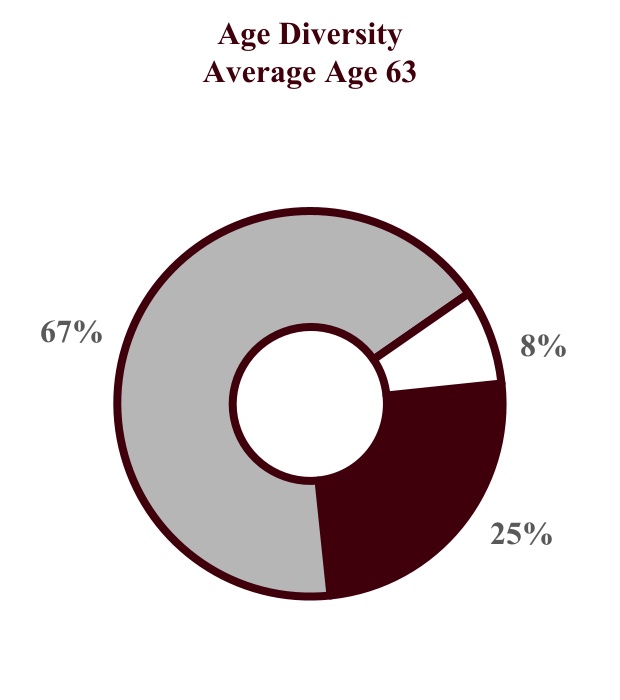
Director nominees have appropriate mix of experiences, skills, qualifications and backgrounds to drive strategy and risk oversight
























































































































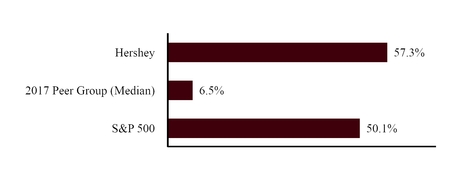

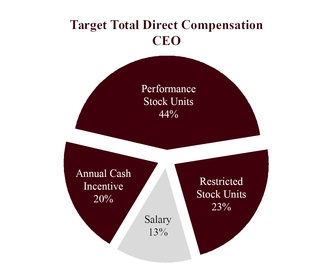
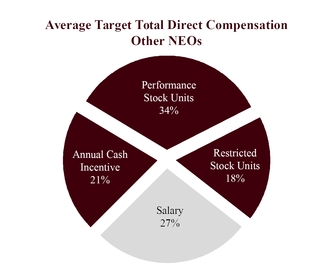
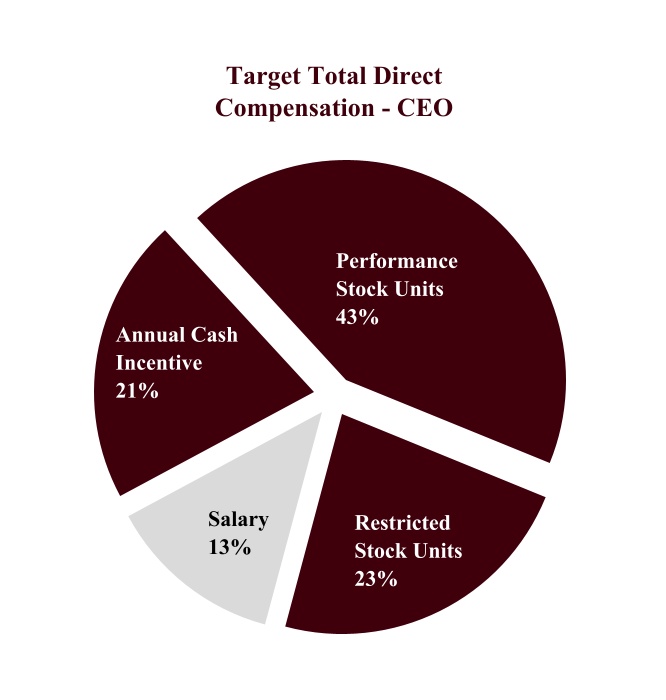
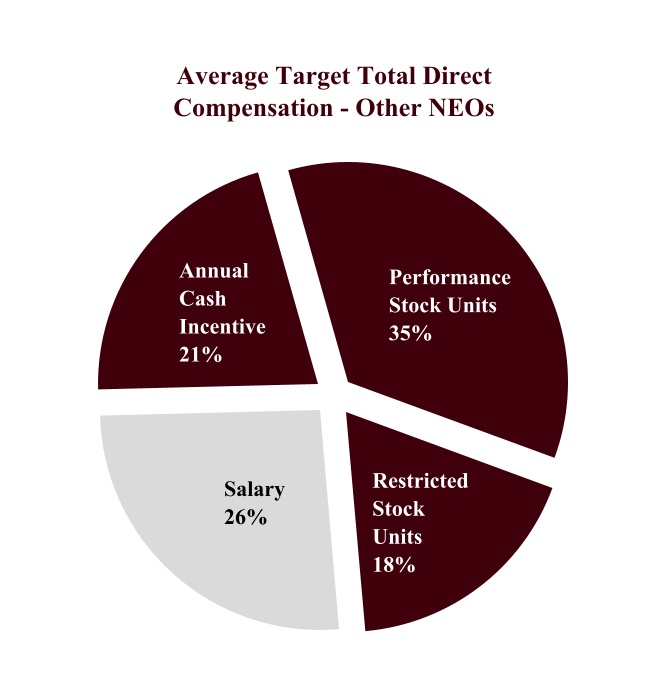
20202022 Annual Meeting of Stockholders to be held on May 12, 202017, 2022
To vote your shares during the Annual Meeting, log into www.virtualshareholdermeeting.com/HSY2022 and follow the voting instructions. You will need the 16-digit control number that is shown on your Notice of Internet Availability of Proxy Materials or on your proxy card. Shares may not be voted after the polls close.
Q: Can I revoke my proxy or change my voting instructions once submitted?
Q: What will happen if I neither submit my proxy nor vote my shares during the Annual Meeting?
If you are a registered stockholder, your shares will not be voted.
Q: What does it mean if I received more than one Notice of Internet Availability of Proxy Materials or proxy card?
You probably have multiple accounts with us and/or brokers, banks or other holders of record. You should vote all of the shares represented by these Notices/proxy cards. Certain brokers, banks and other holders of record have procedures in place to discontinue duplicate mailings upon a stockholder’s request. You should contact your broker, bank or other holder of record for more information. Additionally, Computershare can assist you if you want to consolidate multiple registered accounts existing in your name. To contact Computershare, visit their website at www.computershare.com/investor; or write to P.O. Box 505000, Louisville, KY 40233-5000; or for overnight delivery, to Computershare, 462 South 4th Street, Suite 1600, Louisville, KY 40202; or call:
Q: How many shares must be present to conduct business during the Annual Meeting?
To carry on the business of the Annual Meeting, a minimum number of shares, constituting a quorum, must be present, either electronically or by proxy.
Assuming that a quorum is present:
Q: Are abstentions and broker non-votes counted in the vote totals?
Cocoa For Good, our global responsible cocoa strategy, seeks to create the best outcomes for farmers, their families and communities throughout our supply chain. Key objectives include:
From the moment Milton Hershey founded a school for orphans in 1909, Hershey has continued his legacy of helping children succeed and reach their full potential. Today, we support access to education, nutrition and well-being for children around the world by:
•Equipping children with the social and emotional skills they need to build meaningful connections with one another and their communities;
Code
Environmental, Social and Governance As we continue to grow and broaden our brand portfolio, our business faces a variety of challenges. We use our expertise along with external partners to address these challenges so that we can continue to delight consumers and communities around the world.




SustainabilityThe decision to administer the Board’s oversight responsibilities in this manner has an important effect on the Board’s leadership and Social Impactcommittee structure, described in more detail above. The Board believes that its structure – including a strong Lead Independent Director, 11 of 12 independent directors and key committees comprised entirely of independent directors –helps to ensure that key strategic decisions made by senior management, up to and including the CEO, are reviewed and overseen by independent directors of the Board.
Our Sustainability PrioritiesWhile we focus on sustainability and social impact across our value chain, our key priorities are focused on improvingApplying these categorical standards for independence, as well as the livesindependence requirements set forth in the listing standards of cocoa farmers and cocoa communities, the environmental priorities of climate changeNYSE Rules and the rolerules and regulations of packagingthe Securities and Exchange Commission (“SEC”), the Board determined that all directors recommended for election at the Annual Meeting are independent, except for Ms. Buck, who the Board determined is not independent because she is an executive officer of the Company.Cocoa Farmersthe Company and Cocoa CommunitiesWe support cocoa farmersits subsidiaries, as well as the compensation and their communities through our Cocoa For Good strategy and a commitment to invest $500 million by 2030. This includes sourcing 90% certified cocoa, as part of our commitment to reach 100% certified cocoa by 2020. Our investments are focused on enabling systemic change to improve farmer livelihoods and cocoa communities. We do this through programs that deliver training and financial support to cocoa farmers and their families so they can grow their business, help improve their household income and economically empower women; improve quality education and nutrition at schools for children; work with communities and multiple stakeholders on the ground to eliminate child labor; support youth to become tomorrow’s leaders and work closely with farmers and communities to protect forests, spread more environmentally responsible agricultural practices and promote agroforestry and shade-grown cocoa to eliminate deforestation in cocoa communities.Climate ChangeClimate change is a risk not only to our planet and people but alsoother payments each director received from or made to the sustainability of our business. Hershey has committedCompany and its subsidiaries.
PackagingOur current commitment is to decrease our packaging by 25 million pounds by 2025. As of 2019, we have achieved 94% of that goal, saving 23.6 million pounds of packaging. We are currently looking at the impactmembers of the entire packaging cycle. This analysis includes how much recycled material goes intoboard of directors of Hershey Trust Company and the board of managers (governing body) of Milton Hershey School, as well as certain transactions the Company had or may have with these entities.
Responsible SourcingWe are committed to sustainably sourcing our ingredients and helping to ensure human rights protections across our entire value chain. We source 100% Roundtable on Sustainable Palm Oil and will achieve 100% responsible and sustainable sugarcontrolling stockholder. Hershey Trust Company is in turn owned by the end of 2020. Additionally, we are strengthening our human rights due diligence across our supply chain, launching a revised Tier 1 Supplier program, enrolling 100% of our high-risk suppliers by 2021.Supporting YouthWe are committed to helping children succeed and reach their full potential. Our employees regularly mentor students and volunteer with the Milton Hershey School.School Trust. As such, Hershey Trust Company, Milton Hershey School, the Milton Hershey School Trust and companies owned by the Milton Hershey School Trust are considered affiliates of the Company under SEC rules. During 2021, we had a number of transactions with Hershey Trust Company, Milton Hershey School and companies owned by the Milton Hershey School Trust involving the purchase and sale of goods and services in the ordinary course of business. We also entered into a letter of intent with Hershey Trust Company, as trustee for the Milton Hershey School Trust, with respect to the purchase and sale of certain real and personal property we own in Derry Township, Pennsylvania. We have also forged partnerships that support children’s educationoutlined these transactions in greater detail in the section entitled “Certain Transactions and nutrition, using our expertiseRelationships.” We have provided information about Company stock owned by Hershey Trust Company, as a snacking company to provide nutritious snacks that help childrentrustee for the Milton Hershey School Trust, and by Hershey Trust Company for its own investment purposes in cocoa communities learnthe section entitled “Information Regarding Our Controlling Stockholder.”Sustainability Leadership StructureManaging sustainability at HersheyThere were no changes to the procedures relating to stockholder nominations during 2021, and operating with integrity is one of our most valuable assetsthere have been no changes to such procedures to date in 2022. These procedural requirements are intended to ensure the Governance Committee has sufficient time and a key driver for how we build trustbasis on which to assess potential director candidates and are not intended to discourage or interfere with our consumers. We have a sustainability governance modelappropriate stockholder nominations. The Governance Committee does not believe that includes a multi-level operating structurethese procedural requirements subject any stockholder or proposed nominee to ensure we are aligned onunreasonable burdens. The Governance Committee and the most important issues facing the company and allocatingBoard reserve the right resources to drive progress within our Shared Goodness Promise. Accountability for managing sustainability acrosschange the enterprise sitsprocedural requirements from time to time and/or to waive some or all of the requirements with respect to certain nominees, but any such waiver shall not preclude the Vice PresidentGovernance Committee from insisting upon compliance with any and all of Corporate Communications and Sustainability.the above requirements by any other recommending stockholder or proposed nominees.
Global Sustainability Team and cross-functional working teams. Led by the Senior Director of Global Sustainability and Social Impact, these teams are made up of leaders from across the business who manage the strategy, implementation and reporting of our global sustainability progress. They are in regular communication with external stakeholders who provide valuable perspectives and insights into our program decisions and focus areas.
Sustainability Steering Committee.Led by our Chief Supply Chain Officer and comprised of key business owners who meet monthly throughout the year to review progress, discuss challenges and opportunities and approve key decisions related to our global sustainability progress.Executive Committee. Includes our CEO and her direct reports, conducts biannual reviews of the Shared Goodness Promise sustainability strategy, data and progress against our commitments and targets and emerging sustainability challenges and opportunities.Board of Directors. Oversees our Sustainability progress and reviews the most important emerging sustainability trends, risks and opportunities.Stockholder and Interested Party Communications with Directors
Director Independence The Board, in consultation with the Governance Committee, determines which of our directors are independent. The Board has adopted categorical standards for independence that the Board uses in determining which directors are independent. The Board bases its determination of independence for each director on the more stringent independence standards applicable to Audit Committee members regardless of whether such director serves on the Audit Committee. These standards are contained in the Board’s Corporate Governance Guidelines.Applying these categorical standards for independence, as well as the independence requirements set forth in the listing standards of the New York Stock Exchange (the “NYSE Rules”) and the rules and regulations of the Securities and Exchange Commission (“SEC”), the Board determined that the following directors and director nominees recommended for election at the Annual Meeting are independent: Pamela M. Arway, James W. Brown, Victor L. Crawford, Charles A. Davis, Mary Kay Haben, James C. Katzman, M. Diane Koken, Robert M. Malcolm, Anthony J. Palmer, Juan R. Perez, Wendy L. Schoppert and David L. Shedlarz. The Board determined that Michele G. Buck is not independent because she is an executive officer of the Company.In making its independence determinations, the Board, in consultation with the Governance Committee, reviewed the direct and indirect relationships between each director and the Company and its subsidiaries, as well as the compensation and other payments each director received from or made to the Company and its subsidiaries.In making its independence determinations with respect to Ms. Koken and Messrs. Brown and Katzman, the Board considered their roles as current members of the board of directors of Hershey Trust Company and the board of managers (governing body) of Milton Hershey School, as well as certain transactions the Company had or may have with these entities.Hershey Trust Company, as trustee for the trust established by Milton S. and Catherine S. Hershey that has as its sole beneficiary Milton Hershey School (such trust, the “Milton Hershey School Trust”), is our controlling stockholder. Hershey Trust Company is in turn owned by the Milton Hershey School Trust. As such, Hershey Trust Company, Milton Hershey School, the Milton Hershey School Trust and companies owned by the Milton Hershey School Trust are considered affiliates of the Company under SEC rules. During 2019, we had a number of transactions with Hershey Trust Company, Milton Hershey School and companies owned by the Milton Hershey School Trust involving the purchase and sale of goods and services in the ordinary course of business. We have outlined these transactions in greater detail in the section entitled “Certain Transactions and Relationships.” We have provided information about Company stock owned by Hershey Trust Company, as trustee for the Milton Hershey School Trust, and by Hershey Trust Company for its own investment purposes in the section entitled “Information Regarding Our Controlling Stockholder.”Ms. Koken and Messrs. Brown and Katzman do not receive any compensation from The Hershey Company, from Hershey Trust Company or from Milton Hershey School other than compensation they receive or will receive in the ordinary course as members of the board of directors or board of managers of each of those entities, as applicable. In addition, Ms. Koken and Messrs. Brown and Katzman do not vote on Board decisions in connection with the Company’s transactions with Hershey Trust Company, Milton Hershey School and companies owned by the Milton Hershey School Trust. The Board therefore concluded that the positions Ms. Koken and Messrs. Brown and Katzman have as members of the board of directors of Hershey Trust Company and the board of managers of Milton Hershey School do not impact their independence.
Director Nominations The Governance Committee is responsible for identifying and recommending to the Board candidates for Board membership. As our controlling stockholder, Hershey Trust Company, as trustee for the Milton Hershey School Trust, also may from time to time recommend to the Governance Committee, or elect outright, individuals to serve on our Board.In administering its responsibilities, the Governance Committee has not adopted formal selection procedures, but instead utilizes general guidelines that allow it to adjust the selection process to best satisfy the objectives established for any director search. The Governance Committee considers director candidates recommended by any reasonable source, including current directors, management, stockholders and other sources. The Governance Committee evaluates all director candidates in the same manner, regardless of the source of the recommendation.From time to time, the Governance Committee engages a paid third-party consultant to assist in identifying and evaluating director candidates. The Governance Committee has sole authority under its charter to retain, compensate and terminate these consultants. Prior to May 2019, the Governance Committee retained Egon Zehnder to assist in identifying potential future director candidates. Beginning in May 2019, the Governance Committee engaged Spencer Stuart and Heidrick & Struggles to assist in that process.Stockholders desiring to recommend or nominate a director candidate must comply with certain procedures. If you are a stockholder and desire to nominate a director candidate at the 2021 Annual Meeting of Stockholders of the Company, you must comply with the procedures for nomination set forth in the section entitled “Information Regarding the 2021 Annual Meeting of Stockholders.” Stockholders who do not intend to nominate a director at an annual meeting may recommend a director candidate to the Governance Committee for consideration at any time. Stockholders desiring to do so must submit their recommendation in writing to The Hershey Company, c/o Secretary, 19 East Chocolate Avenue, Hershey, Pennsylvania 17033, and include in the submission all of the information that would be required if the stockholder nominated the candidate at an annual meeting. The Governance Committee may require the nominating stockholder to submit additional information before considering the candidate.There were no changes to the procedures relating to stockholder nominations during 2019, and there have been no changes to such procedures to date in 2020. These procedural requirements are intended to ensure the Governance Committee has sufficient time and a basis on which to assess potential director candidates and are not intended to discourage or interfere with appropriate stockholder nominations. The Governance Committee does not believe that these procedural requirements subject any stockholder or proposed nominee to unreasonable burdens. The Governance Committee and the Board reserve the right to change the procedural requirements from time to time and/or to waive some or all of the requirements with respect to certain nominees, but any such waiver shall not preclude the Governance Committee from insisting upon compliance with any and all of the above requirements by any other recommending stockholder or proposed nominees.
THE BOARD OF DIRECTORSGeneral Oversight The Board has general oversight responsibility for the Company’s affairs. Although the Board does not have responsibility for day-to-day management of the Company, Board members stay informed about the Company’s business through regular meetings, site visits and other periodic interactions with management. The Board is deeply involved in the Company’s strategic planning process. The Board also plays an important oversight role in the Company’s leadership development, succession planning and risk management processes.Composition The Board is currently comprised of 12 members, each serving a one-year term that expires at the Annual Meeting. Twelve of the 13 director nominees are considered independent under the NYSE Rules and the Board’s Corporate Governance Guidelines.Leadership Structure �� The Company’s governance documents provide the Board with flexibility to select the leadership structure that is most appropriate for the Company and its stockholders. The Board regularly evaluates its governance structure and has concluded that the Company and its stockholders are best served by not having a formal policy regarding whether the same individual should serve as both Chairman of the Board and CEO. This approach allows the Board to exercise its business judgment in determining the most appropriate leadership structure in light of the current facts and circumstances facing the Company, including the composition and tenure of the Board, the tenure of the CEO, the strength of the Company’s management team, the Company’s recent financial performance, the Company’s current strategic plan and the current economic environment, among other factors.At the beginning of 2019, the roles of Chairman of the Board and CEO were held by separate individuals, with Michele G. Buck serving as CEO and Charles A. Davis serving as Chairman of the Board. As part of its regular evaluation of the Board’s leadership structure during 2019, the Board determined that the interests of the Company and its stockholders would best be served by combining the roles of Chairman of the Board and CEO in a single individual. Accordingly, effective October 11, 2019, the Board elected Ms. Buck to serve as Chairman of the Board, in addition to her responsibilities as President and CEO.Several factors led to the Board’s decision:Ms. Buck has served as the Company’s CEO and a member of the Board for more than two years. During that time, she has continued to foster a strong working relationship between the Board and management and has cultivated a high level of trust with the Board. She also has a deep understanding of Board governance and operations through her service as Lead Director of New York Life Insurance Company.Having served as an executive in numerous positions with the Company for more than fourteen years, Ms. Buck has an unparalleled knowledge of the Company and its products, which the Board believes puts her in the best position to lead the Board through the strategic business issues facing the Company. During her tenure as CEO, Ms. Buck has proven her ability to drive business strategy and operational excellence. The Board believes that providing Ms. Buck with an opportunity to leverage these skills as Chairman of the Board provides the Company with a significant competitive advantage in the current marketplace.The Board believes that combining the roles of Chairman of the Board and CEO promotes decisive, unified leadership, which will enable the Company to make rapid strategic decisions in the face of increasing competition and shifting market opportunities.In making its decision to combine the roles of Chairman of the Board and CEO, the Board also recognized the importance of strong independent Board leadership. For that reason, effective October 11, 2019, the Board elected Mr. Davis to serve as Lead Independent Director, a role he held from May 2017 until his appointment as Chairman of the Board in May 2018. Mr. Davis’s service as Lead Independent Director helps ensure continuity of Board leadership and effective communication between the Chairman of the Board and the independent directors.
Under the terms of the Board’s Corporate Governance Guidelines, the Lead Independent Director’s responsibilities include the following:In the absence of the Chairman of the Board, presiding at all Board and stockholder meetings;Calling meetings of the independent directors of the Board, in addition to the executive sessions of independent directors held after each Board meeting;Establishing the agenda and presiding at all executive sessions and other meetings of the independent directors of the Board;Communicating with the independent directors of the Board between meetings as necessary or appropriate;Serving as a liaison between the Chairman of the Board and the independent directors, ensuring independent director consensus is communicated to the Chairman of the Board, and communicating the results of meetings of the independent directors to the Chairman of the Board and other members of management, as appropriate;In coordination with the CEO, approving Board meeting agendas and schedules to assure there is sufficient time for discussion of all agenda items;Approving Board meeting materials and other information sent to the Board;Evaluating the quality and timeliness of information sent to the Board by the CEO and other members of management;Assisting the Chairman of the Board in implementing and overseeing the Board succession planning process;Assisting the Chairman of the Board with crisis management matters;Overseeing the evaluation of the CEO;Assisting the chair of the Governance Committee with Board and individual director evaluations; andBeing available for consultation and direct communication at the request of major stockholders.The Board has determined that Mr. Davis is an independent member of the Board under the NYSE Rules and the Board’s Corporate Governance Guidelines.The Board has established five standing committees to assist with its oversight responsibilities: (1) Audit Committee; (2) Compensation and Executive Organization Committee (“Compensation Committee”); (3) Finance and Risk Management Committee; (4) Governance Committee; and (5) Executive Committee. Each of the Audit Committee, the Compensation Committee, the Finance and Risk Management Committee, and the Governance Committee is comprised entirely of independent directors. Finally, Ms. Koken and Messrs. Brown and Katzman are direct representatives of the Company’s largest stockholder. This composition of our Board helps to ensure that boardroom discussions reflect the views of management, our independent directors and our stockholders.
Board Role in Risk Oversight Our Board takes an active role in risk oversight. While management is responsible for identifying, evaluating, managing and mitigating the Company’s exposure to risk, it is the Board’s responsibility to oversee the Company’s risk management process and to ensure that management is taking appropriate action to identify, manage and mitigate key risks and keeping the Board appropriately informed. The Board administers its risk oversight responsibilities both through active review and discussion of key risks facing the Company and by delegating certain risk oversight responsibilities to committees for further consideration and evaluation.
The decision to administer the Board’s oversight responsibilities in this manner has an important effect on the Board’s leadership and committee structure, described in more detail above. The Board believes that its structure – including a strong Lead Independent Director, 12 of 13 independent directors and key committees comprised entirely of independent directors – helps to ensure that key strategic decisions made by senior management, up to and including the CEO, are reviewed and overseen by independent directors of the Board.
Experiences, Skills and Qualifications The Governance Committee works with the Board to determine the appropriate skills, experiences and attributes that should be possessed by the Board as a whole as well as its individual members. While the Governance Committee has not established minimum criteria for director candidates, in general, the Board seeks individuals with skills and backgrounds that will complement those of other directors and maximize the diversity and effectiveness of the Board as a whole. The Board also seeks individuals who bring unique and varied perspectives and life experiences to the Board. As such, the Governance Committee assists the Board by recommending prospective director candidates who will enhance the overall diversity of the Board. The Board views diversity broadly, taking into consideration the age, professional experience, race, education, gender and other attributes of its members. In addition, the Board’s Corporate Governance Guidelines describe the general experiences, qualifications, attributes and skills sought by the Board of any director nominee, including:
In addition to evaluating new director candidates, the Governance Committee regularly assesses the composition of the Board in order to ensure it reflects an appropriate balance of knowledge, skills, expertise, diversity and independence. As part of this assessment, each director is asked to identify and assess the particular experiences, skills and other attributes that qualify him or her to serve as a member of the Board. Based on the most recent assessment of the Board’s composition completed in February 2020, the Governance Committee and the Board have determined that, in light of the Company’s current business structure and strategies, the Board has an appropriate mix of director experiences, skills, qualifications and backgrounds.A description of the most relevant experiences, skills and attributes that qualify each director nominee to serve as a member of the Board is included in his or her biography.
MEETINGS AND COMMITTEES OF THE BOARDMeetings of the Board of Directors and Director Attendance at Annual Meeting The Board held 6 meetings in 2019. Each incumbent director attended at least 89% of all of the meetings of the Board and committees of the Board on which he or she served in 2019. Average director attendance for all meetings equaled 97%.In addition, the independent directors meet regularly in executive session at every Board meeting and at other times as the independent directors deem necessary. These meetings allow the independent directors to discuss important issues, including the business and affairs of the Company as well as matters concerning management, without any member of management present. Each executive session is chaired by the Lead Independent Director. In the absence of the Lead Independent Director, executive sessions are chaired by an independent director assigned on a rotating basis. Members of the Audit Committee, Compensation Committee, Finance and Risk Management Committee, and Governance Committee also meet regularly in executive session.Directors are expected to attend our annual meetings of stockholders. All of the directors standing for election at the 2019 Annual Meeting of Stockholders of the Company attended that meeting.Committees of the Board The Board has established five standing committees. Membership on each of these committees, as of March 13, 2020, is shown in the following chart:
____________________
The Board’s Corporate Governance Guidelines require that every member of the Audit Committee, Compensation Committee, Finance and Risk Management Committee, and Governance Committee be independent.The Board may also from time to time establish committees of limited duration for a special purpose. No such committees were established in 2019.
The table below identifies the number of meetings held by each standing committee in 2019, provides a brief description of the duties and responsibilities of each committee, and provides general information regarding the location of each committee’s charter:
With respect to the nominees to be elected by the holders of the Common Stock and the Class B Common Stock voting together, the 11 nominees receiving the greatest number of votes of the Common Stock and Class B Common Stock will be elected as directors. With respect to the nominees to be elected by the holders of the Common Stock voting separately as a class, the two nominees receiving the greatest number of votes of the Common Stock will be elected as directors. With respect to the nominees to be elected by the holders of the Common Stock and the Class B Common Stock voting together, the 10 nominees receiving the greatest number of votes of the Common Stock and Class B Common Stock will be elected as directors.





| * | Compensation = Compensation and Finance & Risk = Finance and Risk Management Committee | ||||
| ** | Chairman of the Board | ||||
| *** | Lead Independent Director | ||||
| **** | Mr. | ||||
| + | Committee Chair | ||||
GOVERNANCE HIGHLIGHTS
| Composition of | ||
Over 50% of director nominees are diverse






| Female | Racial/Ethnic | Non-Diverse | 50-59 | 60-69 | 70 | ||||||||||||||||||||||||||||||||||||
Strong focus on board refreshment and independence
| Director Tenure | ||||||||||||||
| Average Tenure: 6 Years | ||||||||||||||
0 - 2 Years 



3 - 6 Years 











7 - 10 Years 

11+ Years 





11 Independent Director Nominees | ||
3
| Board | ||
Director nominees have appropriate mix of experiences, skills, qualifications and backgrounds to drive strategy and risk oversight

Risk ManagementOperational Leadership
























Innovation Experience International Experience
























Mergers & Acquisitions Consumer Packaged Goods
























Financial/Investment Leadership Technology Experience
























Government Relations/Regulatory Supply Chain
























| Corporate Governance | ||||||||||||||
Board Structure Ensures Strong Oversight | Policies and Practices Align to High Corporate Governance Standards | Strong Alignment with Stockholders’ Interests | |||||||||||||||||||||
•Independent directors meet separately at each regularly-scheduled Board meeting •Frequent Board and committee meetings to ensure awareness and alignment | •Highly qualified directors reflect broad mix of skills, experiences and attributes | ||||||||||||||||||||||
4
COMPANY STRATEGY AND 20192021 BUSINESS HIGHLIGHTS
| $ | ||||||||
| EMPLOYEES GLOBALLY | IN ANNUAL REVENUES | BRANDS | ||||||
| Our vision is to be | |||||||||||||
| We are focused on | |||||||||||||
| Drive core confection business and broaden participation in snacking | Deliver profitable, international growth | Expand competitive advantage through differentiated capabilities | Responsibly manage our operations to ensure the long-term sustainability of our business, our planet and our people | ||||||||||
| 2019 Performance Highlights | |
| 2.5% | 7.8% |
| NET SALES GROWTH | ADJUSTED EARNINGS PER SHARE-DILUTED GROWTH(1) |
| 2021 Performance Highlights | |||||
| 10.1% | 14.3% | ||||
| NET SALES GROWTH | ADJUSTED EARNINGS PER SHARE-DILUTED GROWTH(1) | ||||
Over the last three years, we have delivered peer-leading Total Shareholder Return | ||||||||||||||
Total Shareholder Return December Average | ||


(1)While we report our financial results in accordance with U.S. generally accepted accounting principles (“GAAP”), we also use non-GAAP financial measures in order to provide additional information to investors to facilitate the comparison of past and present performance. Some of the financial targets under our short- and long-term incentive programs are also derived from non-GAAP financial measures, such as adjusted earnings per share-diluted. For more information regarding how we define adjusted earnings per share-diluted and a reconciliation to earnings per share-diluted, the most directly comparable GAAP measure, please see Appendix A.
(2)For our 2019-2021 Performance Stock Unit awards, Total Shareholder Return was measured based on the average closing price of the Common Stock in the month of December 2018 as compared to the average closing price of the Common Stock in the month of December 2021.
5
EXECUTIVE COMPENSATION HIGHLIGHTS
Our strategic plan and the financial metrics we establish to help achieve and measure success against that plan serve as the foundation of our executive compensation program. Our executive compensation program is intended to provide competitive compensation based on performance and contributions to the Company, to incentivize, attract and retain key executives, to align the interests of our executive officers and our stockholderskey stakeholders and to drive stockholder value over the long term. To achieve these objectives, our executive compensation program includes the following key features:
•We Pay for Performance by aligning our short- and long-term incentive compensation plans with business strategies to reward executives who achieve or exceed applicable Company and business division goals.
◦The target total direct compensation mix in 20192021 for our Chief Executive Officer (“CEO”) and our other named executive officers (“NEOs”), excluding Patricia A. Little, our former Senior Vice President, Chief Financial Officer, who retired from the Company on May 31, 2019, reflects this philosophy.




| At-Risk Compensation = 87% | At-Risk Compensation = | ||||
◦Payouts to our NEOs under our annual cash incentive program for 20192021 were 100% performance based.
◦65% of the equity awards granted to our NEOs in 20192021 took the form of performance stock units, which will be earned based on achievement of pre-determined performance goals.
•We Pay Competitively by targeting total direct compensation for our executive officers, in aggregate, at competitive pay levels using the median of our compensation peer group for reference.
◦We regularly review and, as appropriate, make changes to our compensation peer group to ensure it is representative of our market for talent, our business portfolio, our overall size and our global footprint.
◦We do not provide excessive benefits and perquisites to our executives.
•We Align Our Compensation Program with Stockholder Interests by providing a significant amount of each NEO’s compensation opportunity in the form of equity and requiring executive stock ownership.
◦Equity grants represented 67%66% of our CEO’s 20192021 target total direct compensation and, on average, 52%53% of the 20192021 target total direct compensation for our other NEOs, excluding Ms. Little.NEOs.
◦Stock ownership requirements for our NEOs range from 6x salary (for our CEO) to 3x salary (for NEOs other than our CEO).
6
| Proxy Statement | ||
The Board of Directors (the “Board”) of The Hershey Company (the “Company,” “Hershey,” “we,” or “us”) is furnishing this Proxy Statement and the accompanying form of proxy in connection with the solicitation of proxies for the 20202022 Annual Meeting of Stockholders of the Company (the “Annual Meeting”). The Annual Meeting will be held on May 12, 2020,17, 2022, beginning at 10:00 a.m., Eastern Daylight Time (“EDT”). Due to the ongoing public health impact of the novel coronavirus outbreak (COVID-19)pandemic (“COVID-19”), this year’s Annual Meeting will again be a virtual meeting conducted solely via live webcast. You will be able to attend the Annual Meeting, vote your shares electronically and submit questions during the meeting by visiting www.virtualshareholdermeeting.com/HSY2020HSY2022. You may also listen to the Annual Meeting by calling 1-877-328-2502. You will not be able to attend the Annual Meeting in person.
Important Notice Regarding the Availability of Proxy Materials for the
The Notice of 20202022 Annual Meeting of Stockholders and Proxy Statement, our proxy card, our Annual Report on Form 10-K and other annual meeting materials are available free of charge on the Internetinternet atwww.proxyvote.com. We intend to begin mailing our Notice of Internet Availability of Proxy Materials to stockholders on or about April 2, 2020.7, 2022. At that time, we also will begin mailing paper copies of our proxy materials to stockholders who requested them.
QUESTIONS AND ANSWERS ABOUT THE ANNUAL MEETING
Q: Why is this year’s Annual Meeting being held as a virtual-only meeting?
This year’s Annual Meeting is again being held as a virtual-only meeting conducted solely via live webcast due to the ongoing public health impact of COVID-19 and to support the health and well-being of our stockholders, employees and community members. Holding the Annual Meeting as a virtual-only meeting allows us to reach the broadest number of stockholders while maintaining our commitment to health and safety.
Q: Who is entitled to attend and vote at the Annual Meeting?
You can attend and vote at the Annual Meeting if, as of the close of business on March 18, 2022 (the “Record Date”), you were a stockholder of record of the Company’s common stock (“Common Stock”) or Class B common stock (“Class B Common Stock”). As of the Record Date, there were 145,928,920 shares of our Common Stock and 59,613,777 shares of our Class B Common Stock outstanding.
If you were not a stockholder of record as of the Record Date, you may still attend the Annual Meeting by logging into the webcast as a guest, but you will not be able to vote before or during the meeting.
Q: How do I attend the Annual Meeting?
This year’s Annual Meeting will be a virtual-only meeting conducted solely via live webcast.
To participate in the Annual Meeting, visit www.virtualshareholdermeeting.com/HSY2022 and enter the 16-digit control number included on your Notice of Internet Availability of Proxy Materials or your proxy card. The live webcast will begin at 10:00 a.m. EDT on Tuesday, May 17, 2022. We encourage you to access the virtual meeting platform at least 15 minutes prior to the start time. If you do not have a 16-digit control number, you will still be able to access the webcast as a guest, but will not be able to vote your shares or ask a question during the meeting. You may also listen to the Annual Meeting by calling 1-877-328-2502, but you will not be able to vote your shares or ask a question telephonically.
We will have technicians ready to assist you with any technical difficulties you may have accessing the virtual meeting. Technical support will be available on the virtual meeting platform beginning at 9:30 a.m. EDT on the day of the meeting and will remain available until 30 minutes after the meeting has finished.
7
Q: Can I submit questions before or during the Annual Meeting?
Stockholders have multiple opportunities to submit questions for the Annual Meeting. If you wish to submit a question prior to the Annual Meeting, you may log into www.proxyvote.com and enter your 16-digit control number. Once past the login screen, click on “Submit Questions,” type in your question, and click “Submit.” Alternatively, if you wish to submit a question during the Annual Meeting, visit www.virtualshareholdermeeting.com/HSY2022, type your question into the “Ask a Question” field, and click “Submit.”
Questions pertinent to meeting matters will be answered during the Annual Meeting, subject to time constraints. Questions regarding personal matters, including those relating to employment, product or service issues or suggestions for product innovations may not be considered pertinent to meeting matters and therefore may not be answered. Any questions pertinent to meeting matters that cannot be answered during the meeting due to time constraints will be posted online and answered on the Investors section of our website at www.thehersheycompany.com. The questions and answers will be available as soon as practical after the Annual Meeting and will remain available for one week after posting.
Q: What is the difference between a registered stockholder and a stockholder who owns stock in street name?
If you hold shares of Common Stock or Class B Common Stock directly in your name on the books of the Company’s transfer agent, you are a registered stockholder. If you own your Company shares indirectly through a broker, bank or other holder of record, then you are a beneficial owner and those shares are held in street name.
Q: What are the voting rights of each class of stock?
Stockholders are entitled to cast one vote for each share of Common Stock held as of the Record Date and 10 votes for each share of Class B Common Stock held as of the Record Date. There are no cumulative voting rights.
Q: Can I vote my shares before the Annual Meeting?
Yes. If you are a registered stockholder, there are three ways to vote your shares before the Annual Meeting:
proxy card available and follow the instructions on the website to vote your shares. | ||||||||
| ) | By telephone (800-690-6903) – Submit your vote by telephone until 11:59 p.m. EDT on May | |||||||
| , | By mail – If you received a paper copy of the proxy materials, you can vote by mail by filling out the proxy card enclosed with those materials and returning it pursuant to the instructions set forth on the card. To be valid, proxy cards must be received before the start of the Annual Meeting. | |||||||
If your shares are held in street name, your broker, bank or other holder of record may provide you with a Notice of Internet Availability of Proxy Materials that contains instructions on how to access our proxy materials and vote online or to request a paper or email copy of our proxy materials. If you received these materials in paper form, the materials included a voting instruction card so you can instruct your broker, bank or other holder of record how to vote your shares.
Please see the Notice of Internet Availability of Proxy Materials or the information your bank, broker or other holder of record provided you for more information on these voting options.
Q. Can I vote during the Annual Meeting instead of by proxy?
If you are a registered stockholder, you can vote during the Annual Meeting any shares that were registered in your name as the stockholder of record as of the Record Date.
If your shares are held in street name, you can vote those shares during the Annual Meeting only if you have a legal proxy from the holder of record. If you plan to attend and vote your street-name shares during the Annual Meeting, you should request a legal proxy from your broker, bank or other holder of record.
8
Whether or not you plan to attend the Annual Meeting, we strongly encourage you to vote your shares by proxy prior to the Annual Meeting.
If you are a registered stockholder, you can revoke your proxy and change your vote prior to the Annual Meeting by:
Sending a written notice of revocation to our Secretary at 19 East Chocolate Avenue, Hershey, Pennsylvania 17033 (the notification must be received by the close of business on May 11, 2020)12, 2022);
•Voting again by Internetinternet or telephone prior to 11:59 p.m. EDT on May 11, 202016, 2022 (only the latest vote you submit will be counted); or
•Submitting a new properly signed and dated paper proxy card with a later date (your proxy card must be received before the start of the Annual Meeting).
If your shares are held in street name, you should contact your broker, bank or other holder of record about revoking your voting instructions and changing your vote prior to the Annual Meeting. If you are eligible to vote during the Annual Meeting, you also can revoke your proxy or voting instructions and change your vote during the Annual Meeting by logging into www.virtualshareholdermeeting.com/HSY2022 and following the voting instructions. Q: What will happen if I submit my proxy but do not vote on a proposal? If you submit a valid proxy but fail to provide instructions on how you want your shares to be voted, your proxy will be voted in the manner recommended by the Board on all matters presented in this Proxy Statement, which is as follows: • | |
“FOR” the election of all director nominees;
•“FOR” the ratification of the appointment of Ernst & Young LLP as our independent auditors; and
•“FOR” the approval of the compensation of the Company’s named executive officers (“NEOs”).officers; and
•“AGAINST” the stockholder proposal set forth in this Proxy Statement (if such stockholder proposal is properly presented at the Annual Meeting).
| If any other item is properly presented for a vote at the Annual Meeting, the shares represented by your properly submitted proxy will be voted at the discretion of the proxies. | |
Q: What will happen if I neither submit my proxy nor vote my shares during the Annual Meeting?
• | |
Vote your street-name shares even though you have not provided voting instructions; or
•Choose not to vote your shares.
The other matters you are being asked to vote on are not routine and cannot be voted by your broker, bank or other holder of record without your instructions. When a broker, bank or other holder of record is unable to vote shares for this reason, it is called a “broker non-vote.”
Q: How do I vote my shares in the Company’s Automatic Dividend Reinvestment Service Plan?
Computershare, our transfer agent, has arranged for any shares that you hold in the Automatic Dividend Reinvestment Service Plan to be included in the total registered shares of Common Stock shown on the Notice of Internet Availability of Proxy Materials or proxy card we have provided you. By voting these shares, you also will be voting your shares in the Automatic Dividend Reinvestment Service Plan.
9
•(800) 851-4216 Domestic Holders
•(201) 680-6578 Foreign Holders
•(800) 952-9245 Domestic TDD line for hearing impaired
•(312) 588-4110 Foreign TDD line for hearing impaired
Q: How many shares must be present to conduct business during the Annual Meeting?
On most matters, the votes of the holders of the Common Stock and Class B Common Stock are counted together. However, there are some matters that must be voted on only by the holders of one class of stock. We will have a quorum for all matters to be voted on during the Annual Meeting if the following number of votes is present, electronically or by proxy:
•For any matter requiring the vote of the Common Stock voting separately:separately: a majority of the votes of the Common Stock outstanding on the Record Date.
•For any matter requiring the vote of the Class B Common Stock voting separately:separately: a majority of the votes of the Class B Common Stock outstanding on the Record Date.
•For any matter requiring the vote of the Common Stock and Class B Common Stock voting together without regard to class:class: a majority of the votes of the Common Stock and Class B Common Stock outstanding on the Record Date.
It is possible that we could have a quorum for certain items of business to be voted on during the Annual Meeting and not have a quorum for other matters. If that occurs, we will proceed with a vote only on the matters for which a quorum is present.
Q: What vote is required to approve each proposal?
•Proposal No. 1: Election of Directors – the two nominees to be elected by holders of our Common Stock voting separately as a class who receive the greatest number of votes cast “FOR,” and the 1110 nominees to be elected by holders of our Common Stock and Class B Common Stock voting(voting together as a class) who receive the greatest number of votes cast “FOR,” will be elected as directors.
•Proposal No. 2: Ratification of the Appointment of Ernst & Young LLP as Independent Auditors – the affirmative vote of at least a majority of the votes of the Common Stock and Class B Common Stock (voting together as a class) represented at the Annual Meeting.
•Proposal No. 3: Advise on Named Executive Officer Compensation – the affirmative vote of at least a majority of the votes of the Common Stock and Class B Common Stock (voting together as a class) represented at the Annual Meeting.
•Proposal No. 4: Stockholder Proposal – the affirmative vote of at least a majority of the votes of the Common Stock and Class B Common Stock (voting together as a class) represented at the Annual Meeting.
10
Q: Are abstentions and broker non-votes counted in the vote totals?
Abstentions are counted as being present and entitled to vote in determining whether a quorum is present. Shares as to which broker non-votes exist will be counted as present and entitled to vote in determining whether a quorum is present for any matter requiring the vote of the Common Stock and Class B Common Stock voting together as a class, but they will not be counted as present and entitled to vote in determining whether a quorum is present for any matter requiring the vote of the Common Stock or Class B Common Stock voting separately as a class.
If you mark or vote “abstain” on Proposal Nos. 2-4, the abstention will have the effect of being counted as a vote “AGAINST” the proposal. Broker non-votes with respect to Proposal Nos. 1-4 are not included in vote totals and will not affect the outcome of the vote on those proposals.
Q. Who will pay the cost of soliciting votes for the Annual Meeting?
We will pay the cost of preparing, assembling and furnishing proxy solicitation and other required Annual Meeting materials. We do not use a third-party solicitor. It is possible that our directors, officers and employees might solicit proxies by mail, telephone, telefax, electronically over the internet or by personal contact, without receiving additional compensation. We will reimburse brokers, banks and other nominees, fiduciaries and custodians who nominally hold shares of our stock as of the Record Date for the reasonable costs they incur furnishing proxy solicitation and other required Annual Meeting materials to street-name holders who beneficially own those shares on the Record Date.
11
THE HERSHEY COMPANY PURPOSE AND VALUES
Milton Hershey founded The Hershey Company over 125 years ago with the intention of making quality chocolate affordable to everyone and to make more moments of goodness in people’s lives.While times have changed and Hershey’s beloved snacking brands continue to thrive and grow, our purpose remains the same: to Make More Moments of Goodness for our consumers today and for many generations to come.Our decisions regardingbusiness strategy, operations and resource allocation are guided by this purpose and are rooted in our values of Togetherness, Integrity, Making a Difference and Excellence, consistent with our focus on creating value for all of our stakeholders over the long term.
Code of Conduct
The Board has adopted a Code of Conduct that applies to our directors, officers and employees worldwide. Adherence to this Code of Conduct assures that our directors, officers and employees are held to the highest standards of integrity. The Code of Conduct covers areas such as conflicts of interest, insider trading and compliance with laws and regulations. The Audit Committee oversees the Company’s communication of, and compliance with, the Code of Conduct. The Code of Conduct, including amendments thereto or waivers granted to a director or officer, if any, can be viewed on the Investors section of our website at www.thehersheycompany.com.
Our Shared Goodness Promise
Integral to Making More Moments of Goodness is our holistic environmental, social and governance (“ESG”) strategy, our Shared Goodness Promise, which guides how we empower the remarkable people who make and sell our brands; interact with farming communities that grow our ingredients; deliver on our commitments to consumers, customers and external stakeholders; and help protect the environment and support children and youth. We are committed to operating our business with all stakeholders in mind and with a view toward long-term sustainability and value creation, even as our business and society face a variety of existing and emerging challenges. We leverage our expertise, along with external partners, to help address these challenges and opportunities so that we can continue to delight consumers and help make a positive impact in the world today and into the future.
We believe in doing well by doing good and acting with transparency to inform consumers, shareholders, partners and other stakeholders on progress toward our ESG goals. Hershey has published sustainability reports since 2010, and over the past few years, has added several new ESG reporting frameworks to our suite of disclosures for even greater transparency. These reports, along with our various ESG policies, can be found on the Sustainability section of our website at www.thehersheycompany.com.
Board Oversight of ESG
Managing ESG and sustainability initiatives at Hershey and operating with integrity are key drivers for how we build trust with our consumers and make a positive impact in our society. Our ESG and sustainability governance model includes a multi-level operating structure to ensure we are aligned on the most important issues facing the Company and allocating the right resources to drive progress within our Shared Goodness Promise.
In 2021, to better reflect our focus on corporate responsibility and sustainability at the Board level, we updated our Corporate Governance Guidelines to clarify the Board’s role in overseeing all ESG matters, including our ESG strategies, priorities, progress, risks and opportunities. In addition, we expanded our Governance Committee charter to include responsibility for overseeing Board governance of our ESG policies and programs, and all of our Board committee charters were enhanced to include oversight of each committee’s relevant ESG responsibilities and reporting requirements. Accountability for managing ESG and sustainability at the management level resides with our Vice President of Global Sustainability and Corporate Communications, who reports to our Chief Supply Chain Officer.
12
Board of Directors The full Board oversees our ESG strategies and priorities, along with the most important emerging ESG trends, risks and opportunities. ESG-related oversight responsibilities are divided among the Board’s committees, with oversight for ESG governance residing with the Governance Committee. Management and ESG leaders typically provide deep dives on ESG issues for the full Board at least once a year, with relevant committee updates occurring frequently throughout the year. | |||||
 | Executive Committee Our CEO and | ||||
 | ESG Advisory Committee Established in 2021, this group of executive team members and senior leaders meets bi-monthly to review ESG strategic direction and delivery, governance and proposed ESG-related investments. The committee reviews and provides input on key decisions related to our global ESG and sustainability programs, including review of enhanced disclosures and policy changes. | ||||
 | Disclosure Committee In 2021, Hershey expanded its Disclosure Committee to include the | ||||
 | Sustainability Steering Committee Composed of key business leaders and ESG subject matter experts, this cross-functional group meets bi-monthly to evaluate ESG strategy effectiveness and interdependencies, provides input on investments to support ESG program deliverables and reviews progress towards goals and key performance indicators relevant to our global ESG and sustainability programs. | ||||
 | Global Sustainability Team Led by our Vice President of Global Sustainability and Corporate Communications, this team is composed of ESG experts and leaders from across the business who manage the strategy, implementation and reporting of our global ESG and sustainability initiatives.The Global Sustainability team communicates regularly with external stakeholders who provide valuable perspectives on our program decisions and focus. | ||||
Our ESG Priorities and 2021 Achievements
Anchored by clear purpose and accountability, our ESG priorities are focused on delivering ambitious goals designed to help us create positive change across global environmental and social areas. Our key ESG priorities and objectives are summarized below. For fulsome details regarding our Shared Goodness Promise and achievements against our objectives, please view our 2020 Goodness in Action Sustainability Report, which can be found on the Sustainability section of our website at www.thehersheycompany.com. Further details of our 2021 progress will be available in our 2021 ESG Report (formerly known as our Sustainability Report), which is targeted for publication in early summer 2022.
 |  |  |  |  |  | ||||||||||||
| Cocoa | Responsible Sourcing and | Environment | Our People | Youth | Community | ||||||||||||
13
Our Cocoa For Good strategy, underpinned by a 10-year, $500 million investment, exemplifies Hershey’s commitment to actively drive transformation to a more resilient and sustainable cocoa supply chain. As we deliver on our cocoa commitments, we continue to evolve our ways of working, improve transparency for our key stakeholders, and provide more robust assurances about our products.
Cocoa For Good, our global responsible cocoa strategy, seeks to create the best outcomes for farmers, their families and communities throughout our supply chain. Key objectives include:
•Improving farmer incomes and livelihoods;
•Eliminating child labor and improving children’s nutrition; and
•Protecting the environment.
By 2025, we aim to achieve 100% sourcing visibility in Côte d’Ivoire and Ghana by requiring that 100% of farmers producing Hershey’s cocoa volume in these countries are:
•Polygon mapped by our suppliers to improve traceability and monitor deforestation; and
•Covered by Child Labor Monitoring and Remediation Systems (“CLMRS”) to prevent, monitor and remediate child labor.
By 2025, Hershey seeks to achieve 100% sourcing visibility of the cocoa purchased from farmer groups and farmers participating in our Cocoa For Good strategy in Côte d’Ivoire and Ghana, which together supply a significant amount of the cocoa we purchase worldwide. Clear visibility into how and under what conditions the cocoa we source is grown and cultivated enables us to implement programs that focus on helping to improve farmer incomes, end child labor and protect the environment. Understanding the origin of cocoa is essential to ensure that it meets our human rights and environmental requirements.
CLMRS is the leading method of detection and remediation of child labor amongst children aged 5-17 and was developed through the International Cocoa Initiative. We expect the expansion of CLMRS to cover 125,000 children by 2025, which would be a 350% increase from 2018 in the number of children being supported by our CLMRS system. As of 2021, Hershey’s CLMRS found no evidence of forced child labor in our programs in Côte d’Ivoire and Ghana. More information on the results of our CLMRS program can be found on the Sustainability section of our website at www.thehersheycompany.com.
As a snacking powerhouse, we are committed to growing sustainably and acting responsibly at each phase of our value chain. From protecting and respecting human rights in a complex supply chain to upholding high food safety standards and championing consumer choice and transparency, Milton Hershey’s legacy to always do the right thing remains as deeply embedded in our culture now as it was when our Company was founded.
By 2025, we aim to achieve:
•100% of priority ingredients and materials to be responsibly and sustainably sourced; and
•85% of in scope supplier sites meet Hershey’s Responsible Sourcing Supplier Program requirements.
In 2021, we strengthened our responsible sourcing programs for dairy, sugar and palm oil, including going beyond certification to include industry partnerships, on the ground transformation projects, and new frameworks for monitoring and verification.
We also made significant progress implementing our Responsible Sourcing Supplier Program, which is how we verify suppliers’ compliance with our Supplier Code of Conduct. By the end of 2021, we achieved our goal to enroll 100% of high-risk suppliers in the program. Finally, we piloted new forms of worker-centric due diligence, including on-site and technology-enabled worker voice surveys in our India and Malaysia plants.
| Environment | ||
Our products put smiles on our consumers’ faces every day. These products are made with raw ingredients and materials grown all over the world. Climate change, natural resource scarcity and extreme weather all pose risks to the snacks our consumers love as well as to the farmers and local communities we rely on. Specifically, climate change and deforestation often negatively impact the world’s most vulnerable first, making these important environmental issues into human rights issues as well. Given the significance of these risks and opportunities, we have put in place new targets on climate and packaging. These bold steps will help ensure the long-term sustainability of our planet, people and business and are aligned with reduction requirements to keep warming to 1.5°C globally.
14
By 2030, we aim to achieve:
•50% absolute reduction in Scope 1 and 2 greenhouse gas (“GHG”) emissions against a 2018 baseline;
•25% absolute reduction in Scope 3 GHG emissions against a 2018 baseline;
•100% of plastic packaging to be recyclable, reusable or compostable; and
•25 million pounds of packaging to be eliminated.
In March 2021, we announced a new science-based GHG-reduction goal to cut our absolute Scope 1 and 2 emissions by more than 50% and our absolute Scope 3 emissions by 25% by 2030 compared to a 2018 baseline. Our emissions-reduction targets have been approved by the Science Based Targets initiative as consistent with levels required to meet the highest goals of the Paris Climate Agreement. The targets covering emissions from our operations are aligned with reduction requirements to keep warming to 1.5°C globally.
Additionally, in 2021, we made substantial progress towards our Scope 1 and 2 emissions target through signing power purchase agreements, improvements in energy efficiency, and renewable energy credits from our first solar project. In addition, we are continuing efforts to reduce value chain emissions (Scope 3) by advancing sustainable packaging solutions and working to eliminate deforestation from our ingredient supply chains by 2030.
Our previous goal to eliminate 25 million pounds of packaging by 2025 was achieved five years ahead of schedule in 2020. We have since expanded our commitment to eliminate an additional 25 million pounds of packaging by 2030. In addition, we committed to eliminating hard-to-recycle PVC by the end of 2022 and ensuring 100% of our plastic packaging is recyclable, reusable or compostable by 2030.
| Our People | ||
The remarkable and diverse people employed by Hershey, and the individuals who work along our value chain, are our most important assets. Without them, we would not be able to fulfill our purpose to Make More Moments of Goodness.
By 2025, we aim to achieve:
•Achieve pay equity for similar job categories across our global salaried employees;
•47-50% women representation across all employees globally and 30-40% people of color (“POC”) representation across U.S. employees; and
•50% hazard reduction for job functions with ergonomic risks through process improvements.
In 2021, we intensified our diversity, equity and inclusion (“DEI”) priorities and continued to make progress on The Pathways Project, our five-year plan to make our workplace and communities even more inclusive. The physical, emotional and financial well-being of our employees is paramount and was especially important during 2021. This year, as in 2020, we saw amazing progress and improvements in our culture around resiliency, agility, flexibility and speed of decision-making. We also continued to drive progress on DEI, including being named by Forbes as the World’s Most Female-Friendly Company in 2021. Additionally, in 2021, Hershey was named the #10 Top Company for Diversity by DiversityInc. We still have more work to do to improve and grow, and our employees are co-creating the way forward.
Under our first female Chairman of the Board and CEO, Michele Buck:
•Women today make up 42% of our Board;
•In 2020, we achieved 1:1 aggregate gender pay equity for salaried employees in the United States (excluding recent acquisitions); and
•In 2021, we achieved 1:1 aggregate POC pay equity for salaried employees in the United States (excluding recent acquisitions).
As part of our DEI evolution, we are increasing transparency related to our goals, strategies, and outcomes. Our 2021 ESG Report will feature first time reporting on representative EEO-1 U.S. gender and U.S. POC workforce data, which will include the following information based on employees’ self-identification in the Company’s data system as of December 31, 2021, excluding recent acquisitions:
•Executives and senior leaders: 32.2% female and 17.3% POC;
•Entry-level professional employees: 46.5% female and 18.0% POC;
•Sales employees: 48.1% female and 14.6% POC; and
•Hourly manufacturing employees: 35.0% female and 30.5% POC.
15
From the moment Milton Hershey founded a school for orphans in 1909, Hershey has continued his legacy of helping children succeed and reach their full potential. Today, we support access to education, nutrition and well-being for children around the world by:
•Equipping children with the social and emotional skills they need to build meaningful connections with one another and their communities;
•Using our expertise as a snacking company to provide snacks that offer basic nutrition for children; and
•Supporting the mission of Milton Hershey School through our business model and our employee engagement programs.
By 2025, we aim to achieve:
•50 million children globally supported through education, nutrition, social and emotional well-being; and
•100,000 children take Heartwarming actions and impact their communities.
We have continued our efforts to support youth well-being through The Heartwarming Project, which supports organizations that advance social emotional learning, connection and inclusion for youth. In 2021, the Heartwarming Project Action Grants program awarded 500 Action Grants to teens leading projects on connection, inclusion and well-being in their schools and communities. We also sponsored 140 “Heartwarming Young Heroes” grants for kids’ service projects during Global Youth Service Day and established a Heartwarming Project Youth Advisory Board comprised of 15 Gen Z youth who advise the Company on its investments supporting children and youth.
| Improving Communities | ||
At Hershey, we are all bearers of the legacy of kindness, support and engagement that Milton Hershey has left us, especially in a year as challenging as 2021. Hershey has a long tradition of putting people first—from creating a town where our employees and their families could thrive to our long-standing partnerships that keep families fed and lend a hand during hard times. We provide both philanthropic contributions and product donations to nonprofit organizations in communities where we have a presence.
By 2025, we aim to achieve:
•$105 million donated in cash and products to community partners focused on education, community economic development, inclusive communities and health and human services where we live and work.
In 2021, we continued our COVID relief efforts, maintaining our mask donations through the end of the 2020-2021 school year. In the fall of 2021 during the rise of the Delta variant we provided more than 575,000 masks to school districts and nonprofit organizations. We also provided product donations to boost the morale of health care workers at vaccination clinics in Central Pennsylvania and Memphis, Tennessee, and donated critically needed supplies in areas facing surges, such as oxygen in India, food relief in Brazil and temperature scanners in Puerto Rico.
16
CORPORATE GOVERNANCE
Our Board of Directors believes that the purpose of corporate governance is to facilitate effective oversight and management of the Company to create long-term stockholder value in a manner consistent with our purpose, values, Code of Conduct, stakeholder considerations and all applicable legal requirements. We have a long-standing commitment to good corporate governance practices. Our corporate governance policies and other documents establish the high standards of professional and personal conduct we expect of our Board, members of senior management and all employees, and promote compliance with various financial, ethical, legal and other obligations and responsibilities.
Our Board provides accountability, objectivity, perspective, judgment, and, in many cases, specific industry knowledge or experience. The Board is deeply involved in the Company’s strategic planning process and plays an important oversight role in the Company’s leadership development, succession planning and risk management processes. Although the Board does not have responsibility for day-to-day management of the Company, Board members stay informed about the Company’s business through regular meetings, site visits and other periodic interactions with management.
The business activities of the Company are carried out by our employees under the direction and supervision of our Chairman of the Board, President and Chief Executive Officer (“CEO”). The Board is responsible forCEO. In overseeing these activities. In doing so,activities, each director is required to use his or her business judgment in the best interests of the Company. The Board’s responsibilities include:
•Reviewing the Company’s performance, strategies and major decisions;
•Overseeing the Company’s compliance with legal and regulatory requirements and the integrity of its financial statements;
•Overseeing the Company’s policies and practices for identifying, managing and mitigating key enterprise risks;
•Overseeing ESG matters, including the Company’s ESG strategies, policies, progress, risks and opportunities;
•Overseeing management, including reviewing the CEO’s performance and succession planning for key management roles; and
•Overseeing executive and director compensation and our compensation programprograms and policies.
Corporate Governance Guidelines
The Board has adopted Corporate Governance Guidelines that, along with the charters of the Board committees, provide the basic framework for the Board’s operation and role in the governance of the Company. The guidelines include the Board’s policies regarding director independence, qualifications and responsibilities, access to management and outside advisors, compensation, continuing education, oversight of management succession and stockholding requirements. They also provide a process for directors to annually evaluate the performance of the Board.
The Governance Committee is responsible for overseeing and reviewing the Board’s Corporate Governance Guidelines at least annually and recommending any proposed changes to the Board for approval. The Corporate Governance Guidelines are available on the Investors section of our website at www.thehersheycompany.com.www.thehersheycompany.com.
Board Composition and Criteria for Board Membership
Board Composition
The Board currently comprises 12 members, each serving a one-year term that expires at the Annual Meeting. Eleven of Conduct the 12 director nominees are considered independent under the New York Stock Exchange (“NYSE”) Rules (“NYSE Rules”) and the Board’s Corporate Governance Guidelines.
Criteria for Board Membership – Experiences, Skills and Qualifications
The Governance Committee works with the Board to determine the appropriate skills, experiences and attributes that should be possessed by the Board as a whole as well as its individual members. While the Governance Committee has not established minimum criteria for director candidates, in general, the Board seeks individuals with skills and backgrounds that will complement those of other directors and maximize the diversity and effectiveness of the Board as a whole. The Board also seeks individuals who bring unique and varied perspectives and life experiences to the Board. As such, the Governance Committee assists the Board by recommending prospective director candidates who will enhance the overall diversity of the Board. The Board views diversity broadly, taking into consideration the age, professional experience, race, education, gender and other attributes of its members.
17
In addition, the Board’s Corporate Governance Guidelines describe the general experiences, qualifications, attributes and skills sought by the Board of any director nominee, including:
| Qualifications, Attributes and Skills | Knowledge and Experience | ||||
ü Integrity | ü Consumer Products | ||||
ü Judgment | ü Innovation | ||||
ü Diversity | ü Mergers and Acquisitions | ||||
ü Ability to express informed, useful and constructive views | ü Government Relations | ||||
ü Experience with businesses and other organizations of comparable size | ü Supply Chain | ||||
ü Ability to commit the time necessary to learn our business and to prepare for and participate actively in committee meetings and in Board meetings | ü Emerging Markets ü Finance ü Marketing ü Risk Management ü Technology | ||||
ü Interplay of skills, experiences and attributes with those of the other Board members | |||||
In addition to evaluating new director candidates, the Governance Committee regularly assesses the composition of the Board in order to ensure it reflects an appropriate balance of knowledge, skills, expertise, diversity and independence. As part of this assessment, each director is asked to identify and assess the particular experiences, skills and other attributes that qualify him or her to serve as a member of the Board. Based on the most recent assessment of the Board’s composition completed in February 2022, the Governance Committee and the Board have determined that, in light of the Company’s current business structure and strategies, the Board has an appropriate mix of director experiences, skills, qualifications and backgrounds.
18
The following chart provides a summary of the collective qualifications of our director nominees:
| Experience | Qualifications | Board Composition | ||||||
| Risk Management | Experience with Enterprise Risk Management (“ERM”) programs (through operations or via board/committee oversight), including strategic, financial, operational and commercial risks, as well as experience with cybersecurity risk and/or ESG oversight/execution | 92% | ||||||
| Operational Leadership | Functional experience in a senior operating position (President, Chief Operating Officer, head of large division) within a public/private company, including current or recent experience as a public company CEO | 75% | ||||||
| Innovation | Experience in research & development/new product and packaging innovation, proven track record of implementing innovative ways of working | 58% | ||||||
| International | Significant experience working and managing operations in markets outside the U.S., combined with an intimate understanding of issues, trends and other relevant business activities in those markets | 58% | ||||||
| Mergers & Acquisitions (“M&A”) | Experience sourcing, negotiating and integrating complex M&A deals, either as a senior operating executive or an investment banking or private equity professional | 58% | ||||||
| Consumer Packaged Goods (“CPG”) | Experience in a senior level position of a durable or non-durable consumer-oriented company, preferably within the fast-moving consumer goods sector; senior-level experience with consumer marketing, sales and/or CPG retailers | 50% | ||||||
| Financial/Investment Leadership | Experience as a public company chief financial officer, audit partner or chair of a public company audit committee or significant experience in capital markets, investment banking, corporate finance, financial reporting or the financial management of a major organization | 50% | ||||||
| Technology | Recent leadership experience implementing new technologies to drive efficiencies and deliver commercial advantage; significant experience with data analytics or enterprise digital transformation and ability to drive unique insights that lead to better strategic decisions and actions; senior leadership in a digital marketing organization or business unit | 42% | ||||||
| Government Relations/Regulatory | Experience in a government capacity at the state or federal level and/or senior executive experience within legal, regulatory or other policy-making functions | 33% | ||||||
| Supply Chain | Experience at a senior level managing or overseeing global supply chain strategy and execution for a major corporation, including responsibility for demand planning, procurement/sourcing, shipping, warehousing and logistics management | 33% | ||||||
A description of the most relevant experiences, skills and attributes that qualify each director nominee to serve as a member of the Board is included in his or her biography.
19
Leadership Structure
The Company’s governance documents provide the Board with flexibility to select the leadership structure that is most appropriate for the Company and its stockholders. The Board regularly evaluates its governance structure and has concluded that the Company and its stockholders are best served by not having a formal policy regarding whether the same individual should serve as both Chairman of the Board and CEO. This approach allows the Board to exercise its business judgment in determining the most appropriate leadership structure in light of the current facts and circumstances facing the Company, including the composition and tenure of the Board, the tenure of the CEO, the strength of the Company’s management team, the Company’s recent financial performance, the Company’s current strategic plan and the current economic environment, among other factors.
Ms. Buck currently serves as our Chairman of the Board, President and CEO. The Board believes that combining the roles of Chairman of the Board and CEO under Ms. Buck’s leadership, paired with a strong Lead Independent Director, is in the best interests of the Company and its stockholders at this time for several reasons:
•Ms. Buck has served as the Company’s CEO and a member of the Board for more than five years. During that time, she has fostered a strong working relationship between the Board and management and has cultivated a high level of trust with the Board. She also has a deep understanding of Board governance and operations through her service as Lead Director of New York Life Insurance Company.
•Having served as an executive in numerous positions with the Company for more than 17 years, Ms. Buck has an unparalleled knowledge of the Company and its products, which the Board believes puts her in the best position to lead the Board through the strategic business issues facing the Company. During her tenure as CEO, Ms. Buck has proven her ability to drive business strategy and operational excellence. The Board believes that having Ms. Buck leverage these skills as Chairman of the Board provides the Company with a significant competitive advantage in the current marketplace.
The Board also recognizes the importance of strong independent Board leadership. For that reason, effective in May 2020, the Board elected Anthony J. Palmer to serve as Lead Independent Director. The Board has adopteddetermined that Mr. Palmer is an independent member of the Board under the NYSE Rules and the Company’s Corporate Governance Guidelines.
Under the terms of the Board’s Corporate Governance Guidelines, the Lead Independent Director’s responsibilities include the following:
•In the absence of the Chairman of the Board, presiding at all Board and stockholder meetings;
•Calling meetings of the independent directors of the Board, in addition to the executive sessions of independent directors held after each Board meeting;
•Presiding at all executive sessions and other meetings of the independent directors of the Board;
•Communicating with the independent directors of the Board between meetings as necessary or appropriate;
•Serving as a Codeliaison between the Chairman of Conduct that appliesthe Board and the independent directors, ensuring independent director consensus is communicated to the Chairman of the Board, and communicating the results of meetings of the independent directors to the Chairman of the Board and other members of management, as appropriate;
•In coordination with the CEO, approving Board meeting agendas and schedules to assure there is sufficient time for discussion of all agenda items;
•Approving Board meeting materials and other information sent to the Board;
•Evaluating the quality and timeliness of information sent to the Board by the CEO and other members of management;
•Assisting the Chairman of the Board and the Chair of the Governance Committee in implementing and overseeing the Board succession planning process;
•Assisting the Chairman of the Board with crisis management matters;
•Overseeing the evaluation of the CEO;
•Assisting the chair of the Governance Committee with Board and individual director evaluations; and
•Being available for consultation and direct communication at the request of major stockholders.
20
Committees of the Board
The Board has established five standing committees to assist with its oversight responsibilities: (1) Audit Committee; (2) Compensation and Human Capital Committee, which was previously named the Compensation and Executive Organization Committee until December 2021 (“Compensation Committee”); (3) Finance and Risk Management Committee; (4) Governance Committee and (5) Executive Committee. Each of the Audit Committee, the Compensation Committee, the Finance and Risk Management Committee and the Governance Committee is comprised entirely of independent directors as required by our Corporate Governance Guidelines. In addition, Ms. Koken and Messrs. Brown and Katzman are direct representatives of the Company’s largest stockholder. This composition of our Board helps to ensure that boardroom discussions reflect the views of management, our independent directors officers and employees worldwide. Adherenceour stockholders.
The Board may also from time to this Codetime establish committees of Conduct assures thatlimited duration for a special purpose. No such committees were established in 2021.
Membership on each of our directors, officersBoard committees, as of March 18, 2022, is reflected below:
| Name | Audit | Compensation and Human Capital | Finance and Risk Management | Governance | Executive | |||||||||||||||||||||||||||||||||||||||||||||||||||||||||
Pamela M. Arway | Chair |  |  | |||||||||||||||||||||||||||||||||||||||||||||||||||||||||||
James W. Brown |  |  | ||||||||||||||||||||||||||||||||||||||||||||||||||||||||||||
| Michele G. Buck | Chair | |||||||||||||||||||||||||||||||||||||||||||||||||||||||||||||
| Victor L. Crawford |  |  | ||||||||||||||||||||||||||||||||||||||||||||||||||||||||||||
| Robert M. Dutkowsky |  |  | ||||||||||||||||||||||||||||||||||||||||||||||||||||||||||||
Mary Kay Haben |  | Chair |  | |||||||||||||||||||||||||||||||||||||||||||||||||||||||||||
| James C. Katzman |  |  | ||||||||||||||||||||||||||||||||||||||||||||||||||||||||||||
M. Diane Koken |  |  | ||||||||||||||||||||||||||||||||||||||||||||||||||||||||||||
Robert M. Malcolm |  | Chair |  | |||||||||||||||||||||||||||||||||||||||||||||||||||||||||||
Anthony J. Palmer |  * * |  |  * * |  * * |  | |||||||||||||||||||||||||||||||||||||||||||||||||||||||||
| Juan R. Perez |  |  | ||||||||||||||||||||||||||||||||||||||||||||||||||||||||||||
| Wendy L. Schoppert | Chair |  |  | |||||||||||||||||||||||||||||||||||||||||||||||||||||||||||
____________________
 | Committee Member | |||||||||||||
 * * | Ex-Officio | |||||||||||||
21
The table below identifies the number of meetings held by each Board committee in 2021 and employees are held toprovides a brief description of the highest standardsduties and responsibilities of integrity.each committee. The Codecharter of Conduct covers areas such as conflicts of interest, insider trading and compliance with laws and regulations. The Audit Committee oversees the Company’s communication of, and compliance with, the Code of Conduct. The Code of Conduct, including amendments thereto or waivers granted to a director or officer, if any,each Board committee can be viewed on the Investors section of our website atwww.thehersheycompany.com. www.thehersheycompany.com




| Meetings in 2021: 6 | ||||||||||||
| Duties and Responsibilities | • Oversee the Company’s Code of Conduct •Oversee independent auditors’ qualifications, independence and | • Oversee (in consultation with the Finance and Risk Management Committee) risk management processes and policies • Review adequacy of internal controls • Review Quarterly and Annual Reports • Review earnings releases • Discuss the Company’s tax strategies, practices and related disclosures •Review the Company’s public reporting with respect to ESG matters within the Audit Committee’s purview | ||||||||||
• All Audit Committee members must be independent •All Audit Committee members are • Charter prohibits any member of the Audit Committee from | ||||||||||||
| Compensation and Human Capital Committee | Meetings in 2021: 6 | |||||||
| Duties and Responsibilities | • Establish executive officer compensation (other than CEO compensation) and oversee compensation programs and policies • Oversee consideration of ESG matters in executive compensation program • Oversee human capital management practices, including talent management, DEI and pay equity • Evaluate CEO performance and make recommendations regarding CEO compensation • Oversee the CEO’s evaluation of executive officers and, in consultation with the CEO, review and approve the compensation of executive officers other than the CEO • Review director compensation • Make equity grants under and administer the Equity and Incentive Compensation Plan (the “EICP”) • Establish target award levels and make awards under the annual cash incentive component of the EICP • Review the Company’s executive organization • Oversee executive officer succession planning | |||||||
| Membership | • All Compensation Committee members must be independent | |||||||
22
| Finance and Risk Management Committee | Meetings in 2021: 10 | |||||||
Duties and Responsibilities | • Oversee management of the Company’s assets, liabilities and risks • Review capital projects, acquisitions and dispositions of assets and changes in capital structure • Review the annual budget and monitor performance against operational plans • Review principal banking relationships, credit facilities and commercial paper programs • Oversee (in consultation with the Audit Committee) risk management processes and policies •Review and oversee policies and procedures with respect to human rights, environmental stewardship and responsible sourcing/commodities practices within the Company’s supply chain | |||||||
| Membership | • All Finance and | |||||||
| Governance Committee | Meetings in 2021: 5 | |||||||
Duties and | • Review the composition of the Board and • Identify, evaluate and recommend candidates for election to the Board • Review corporate governance matters and policies, including the Board’s Corporate Governance Guidelines •Oversee governance of the Company’s ESG policies and programs, including the establishment and review of targets, standards and other metrics used to measure and track ESG performance and progress • Administer the Company’s Related Person Transaction Policy • Evaluate the performance of the Board, its independent committees and each director | |||||||
| Membership | • All Governance Committee members must be independent | |||||||
| Executive Committee | Meetings in 2021: 1 | |||||||
| Duties and Responsibilities | • Manage the business and affairs of the Company, to the extent permitted by the Delaware General Corporation Law, when the Board is not in session • Review and approve related-party transactions between the Company and Hershey Trust Company, Hershey Entertainment & Resorts Company and/or Milton Hershey School, or any of their affiliates •For more information regarding the review, approval or ratification of related-party transactions, please refer to the section entitled “Certain Transactions and Relationships” | |||||||
| Membership | • Comprises the Chairman of the Board, Lead Independent Director, the Chairs of the Audit Committee, Governance Committee, Compensation Committee and Finance and Risk Management Committee, and, if deemed appropriate by the Board in its discretion, one other director as appointed by the Board. | |||||||
23
Enterprise Risk Management
Our Board takes an active role in risk oversight. While management is responsible for identifying, evaluating, managing and mitigating the Company’s exposure to risk, it is the Board’s responsibility to oversee the Company’s risk management process and to ensure that management is taking appropriate action to identify, manage and mitigate key risks and keeping the Board appropriately informed. The Board administers its risk oversight responsibilities both through active review and discussion of key risks facing the Company and by delegating certain risk oversight responsibilities to committees for further consideration and evaluation.
Board of Directors •Review and evaluate strategic plans and associated risks • Oversee ERM framework and the • Conduct annual succession plan reviews • Oversee ESG programs and | Audit Committee | •Oversee legal and regulatory compliance and the Code of Conduct • Oversee risks relating to key accounting policies • Review internal controls with management and internal auditors •Review the Company’s public reporting with respect to ESG matters within the committee’s purview | ||||||
| Compensation and Human Capital Committee | •Oversee risks relating to compensation programs and policies • Oversee consideration of ESG matters in executive compensation program • Employ independent compensation consultants to assist in reviewing compensation programs, including potential risks •Oversee succession planning and talent processes and programs • Oversee human capital management practices, including talent management, DEI and pay equity | |||||||
| Finance and Risk Management Committee | •Review key enterprise risks identified through the ERM process as well as risk mitigation plans, including information security •Oversee key financial risks • Oversee and approve M&A activities and related risks •Review and oversee policies and procedures with respect to human rights, environmental stewardship and responsible sourcing/commodities practices within the Company’s supply chain | |||||||
| Governance Committee | •Oversee governance-related risks •Oversee governance of •Oversee compliance with key corporate governance documents | |||||||
| Executive Committee | ||||||||
24
Information Security
As indicated above, the Finance and Risk Management Committee is responsible for reviewing key enterprise risks identified through the ERM process, which includes information security strategies and risks, as well as data privacy and protection risks and mitigation strategies (“Information Security”). At each regularly scheduled Finance and Risk Management Committee meeting, management, through the Company’s Chief Information Security Officer, reports on Information Security controls, audits, guidelines and developments. The Chief Information Security Officer oversees the dedicated Information Security team, which works in partnership with internal audit to review information technology-related internal controls with our external auditors as part of the overall internal controls process. Annual third-party audits are also conducted on penetration testing and overall program maturity.
Our sustainability effortsCompany-wide Information Security training program includes:
•Security awareness training, including regular phishing simulations;
•Acceptable use training; and
•Other targeted trainings throughout the year.
We currently maintain a cyber insurance policy that provides coverage for security breaches. The Company has neither experienced an Information Security breach nor incurred any breach-related expenses over the last three years.
Board Meetings and Attendance
The Board held 9 meetings in 2021. Each incumbent director attended at least 98% of all of the meetings of the Board and committees of the Board on which he or she served in 2021. Average director attendance for all meetings equaled 99%.
In addition, the independent directors meet regularly in executive session at every Board meeting and at other times as the independent directors deem necessary. These meetings allow the independent directors to discuss important issues, including the business and affairs of the Company as well as matters concerning management, without any member of management present. Each executive session is chaired by the Lead Independent Director. In the absence of the Lead Independent Director, executive sessions are broughtchaired by an independent director assigned on a rotating basis. Members of the Audit Committee, Compensation Committee, Finance and Risk Management Committee and Governance Committee also meet regularly in executive session.
Directors are expected to life throughattend our strategy,annual meetings of stockholders. All directors standing for election at the Shared Goodness Promise, which can be viewed, alongAnnual Meeting attended the 2021 annual meeting.
Director Independence
The Board, in consultation with the work we do,Governance Committee, determines which of our directors are independent. The Board has adopted categorical standards for independence that it uses in our Shared Goodness Sustainability Reportdetermining which directors are independent. The Board bases its determination of independence for each director on the Sustainabilitymore stringent independence standards applicable to Audit Committee members regardless of whether such director serves on the Audit Committee. These standards are contained in the Board’s Corporate Governance Guidelines, which are available on the Investors section of our website at www.thehersheycompany.com.
In making its independence determinations, the Board, in our business, responsibly sourcingconsultation with the inputs to our productsGovernance Committee, reviewed the direct and helping kidsindirect relationships between each director and teens succeed.
In making its independence determinations with respect to Ms. Koken and Messrs. Brown and Katzman, the Science Based Targets initiative to ensure our environmental practices account for our full environmental footprint and are in-line withBoard considered their roles as current global needs of limiting greenhouse gas emissions below the 2-degree limit. This work is underway and we expect to release our new targets and commitment in early 2021.
25
Hershey Trust Company, as trustee for the trust established by Milton S. and Catherine S. Hershey that has as its sole beneficiary Milton Hershey School (such trust, the “Milton Hershey School Trust”), is our packaging, best end-of-life options for all our packaging material and continued reductions of total packaging used.
Ms. Koken and Messrs. Brown and Katzman do not receive any compensation from The Hershey Company, from Hershey Trust Company or from Milton Hershey School other than compensation they receive or will receive in school. Our ViVi school feeding program reaches more than 50,000 students a daythe ordinary course as members of the board of directors or board of managers of each of those entities, as applicable. In addition, Ms. Koken and Messrs. Brown and Katzman do not vote on Board decisions in Ghana and has been proven to reduce anemia by 40%. Our Heartwarming Project builds upon our brands’ role of creating connections and works to equip over 697,000 children and teens across the U.S.connection with the socialCompany’s transactions with Hershey Trust Company, Milton Hershey School and emotional skills they needcompanies owned by the Milton Hershey School Trust. The Board therefore concluded that the positions Ms. Koken and Messrs. Brown and Katzman have as members of the board of directors of Hershey Trust Company and the board of managers of Milton Hershey School do not impact their independence.
Director Nominations
The Governance Committee is responsible for identifying and recommending to build meaningful connectionsthe Board candidates for Board membership. As our controlling stockholder, Hershey Trust Company, as trustee for the Milton Hershey School Trust, also may from time to time recommend to the Governance Committee, or elect outright, individuals to serve on our Board.
In administering its responsibilities, the Governance Committee has not adopted formal selection procedures, but instead utilizes general guidelines that allow it to adjust the selection process to best satisfy the objectives established for any director search. The Governance Committee considers director candidates recommended by any reasonable source, including current directors, management, stockholders and other sources. The Governance Committee evaluates all director candidates in the same manner, regardless of the source of the recommendation.
From time to time, the Governance Committee engages a paid third-party consultant to assist in identifying and evaluating director candidates. The Governance Committee has sole authority under its charter to retain, compensate and terminate these consultants.
Stockholders desiring to recommend or nominate a director candidate must comply with one anothercertain procedures. If you are a stockholder and desire to nominate a director candidate at the 2023 Annual Meeting of Stockholders of the Company, you must comply with the procedures for nomination set forth in the section entitled “Information Regarding the 2023 Annual Meeting of Stockholders.” Stockholders who do not intend to nominate a director at an annual meeting may recommend a director candidate to the Governance Committee for consideration at any time. Stockholders desiring to do so must submit their communities, enhancing youth well-being.recommendation in writing to The Hershey Company, c/o Secretary, 19 East Chocolate Avenue, Hershey, Pennsylvania 17033, and include in the submission all of the information that would be required if the stockholder nominated the candidate at an annual meeting. The Governance Committee may require the nominating stockholder to submit additional information before considering the candidate.
26
Stockholders and other interested parties may communicate with our directors in several ways. Communications regarding accounting, internal accounting controls or auditing matters may be emailed to the Audit Committee at auditcommittee@hersheys.com or sent to the Audit Committee at the following address:
Audit Committee
c/o Secretary
The Hershey Company
19 East Chocolate Avenue
P.O. Box 819
Hershey, PA 17033-0819
Stockholders and other interested parties also can submit comments, confidentially and anonymously if desired, to the Audit Committee by calling the Hershey Concern Line at (800) 871-3659, by accessing the Hershey Concern Line website at www.HersheysConcern.com. or emailing ethics@hersheys.com.
Stockholders and other interested parties may contact any of the independent directors, including the Lead Independent Director, as well as the independent directors as a group, by writing to the specified party at the address set forth above or by emailing the independent directors (or a specific independent director, including the Lead Independent Director) at independentdirectors@hersheys.com. Stockholders and other interested parties may also contact any of the independent directors using the Hershey Concern Line website noted above.
Communications to the Audit Committee, any of the independent directors and the Hershey Concern Line are processed by the Office of General Counsel. The Office of General Counsel reviews and summarizes these communications and provides reports to the applicable party on a periodic basis. Communications regarding any accounting, internal control or auditing matter are reported immediately to the Audit Committee, as are allegations about our officers. The Audit Committee will address communications from any interested party in accordance with our Board-approved Procedures for Submission and Handling of Complaints Regarding Compliance Matters, which are available for viewing on the Investors section of our website at www.thehersheycompany.com. Solicitations, junk mail and obviously frivolous or inappropriate communications are not forwarded to the Audit Committee or the independent directors, but copies are retained and made available to any director who wishes to review them.
27 | |
 |  | |||||||||||||||||||
 |  | |||||||||||||||||||
 |  |  |  |  | ||||||||||||||||
 |  | |||||||||||||||||||
 |  | |||||||||||||||||||
 |  | |||||||||||||||||||
 |  | |||||||||||||||||||
 |  | |||||||||||||||||||
 |  | |||||||||||||||||||
 |  | |||||||||||||||||||
 |  | |||||||||||||||||||
 | ||||
 | ||||
PROPOSAL NO. 1 – ELECTION OF DIRECTORS
ü | The Board of Directors unanimously recommends that stockholders vote FOR each of the nominees for director at the | ||||
The first proposal to be voted on at the Annual Meeting is the election of 1312 directors. If elected, the directors will hold office until the 20212023 Annual Meeting of Stockholders of the Company or until their successors are elected and qualified.
Election Procedures
We have two classes of common stock outstanding: Common Stock and Class B Common Stock. Under our certificate of incorporation and by-laws:
•One-sixth of the total number of our directors (which equates presently to two directors) will be elected by the holders of our Common Stock voting separately as a class. For the 2020 Annual Meeting, the Board has nominated Victor L. Crawford and Juan R. PerezRobert M. Dutkowsky for election by the holders of our Common Stock voting separately as a class.
•The remaining 1110 directors will be elected by the holders of our Common Stock and Class B Common Stock voting together without regard toas a class.
The Board’s Corporate Governance Guidelines provide that directors will generally not be nominated for re-election after their 72nd72nd birthday. All of the directors standing for election at the 2020 Annual Meeting with the exception of Mr. Shedlarz, satisfiedsatisfy the applicable age guideline. In the case of Mr. Shedlarz, the Board elected to waive the guideline and nominated him to stand for election at the 2020 Annual Meeting.
All director nominees for election as director have indicated their willingness to serve if elected. If a nominee becomes unavailable for election for any reason, the proxies will have discretionary authority to vote for a substitute.
Nominees for Director
The Board unanimously recommends the followingdirector nominees for election at the 2020 Annual Meeting. These nomineeslisted below were recommended to the Board by the Governance Committee.Committee, and the Board unanimously recommends the director nominees for election at the Annual Meeting. In making its recommendation, the Governance Committee considered the experience, qualifications, attributes and skills of each nominee, as well as each director’s past performance on our Board, as reflected in the Governance Committee’s annual evaluation of Board and committee performance. This evaluation considers, among other things, each director’s individual contributions to the Board, the director’s ability to work collaboratively with other directors and the effectiveness of the Board as a whole.
On the following pages, we provide certain biographical information about each nominee for director, as well as information regarding the nominee’s specific experience, qualifications, attributes and skills that qualify him or her to serve as a director and as a member of the committee(s) of the Board on which the nominee serves.
28
 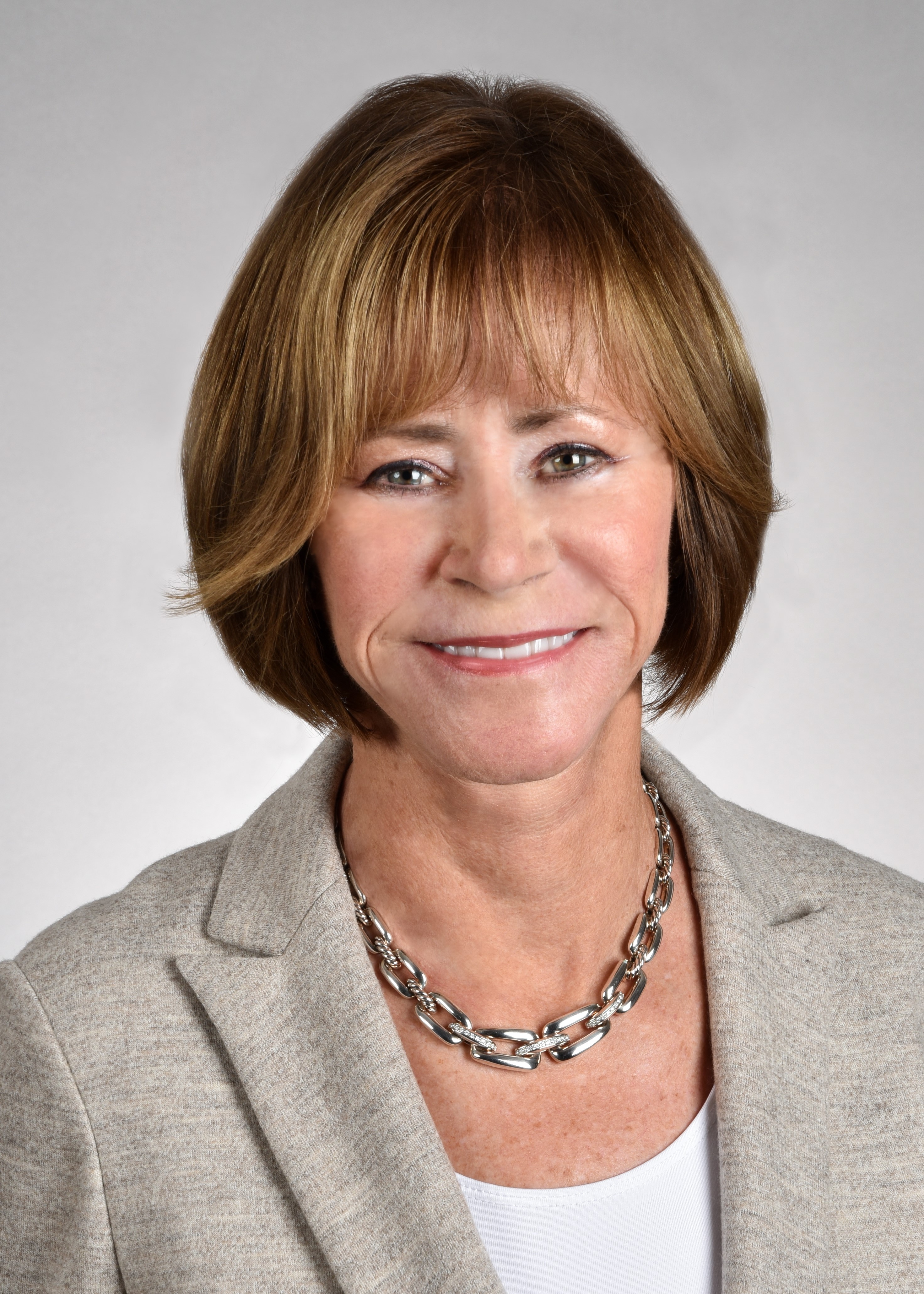 Pamela M. Arway Director since 2010 Age Board Committees •Compensation (Chair) •Executive •Finance and Risk Management | Ms. Arway is the former President, Japan/Asia Pacific/Australia Region, of American Express International, Inc., a global payments, network and travel company, | ||||
• •DaVita Inc. | •Carlson Inc. (May 2019 to June 2021) EDUCATION •Bachelor’s degree in languages from Memorial University of Newfoundland •Masters of Business Administration degree from Queen’s University, Kingston, Ontario, Canada | ||||

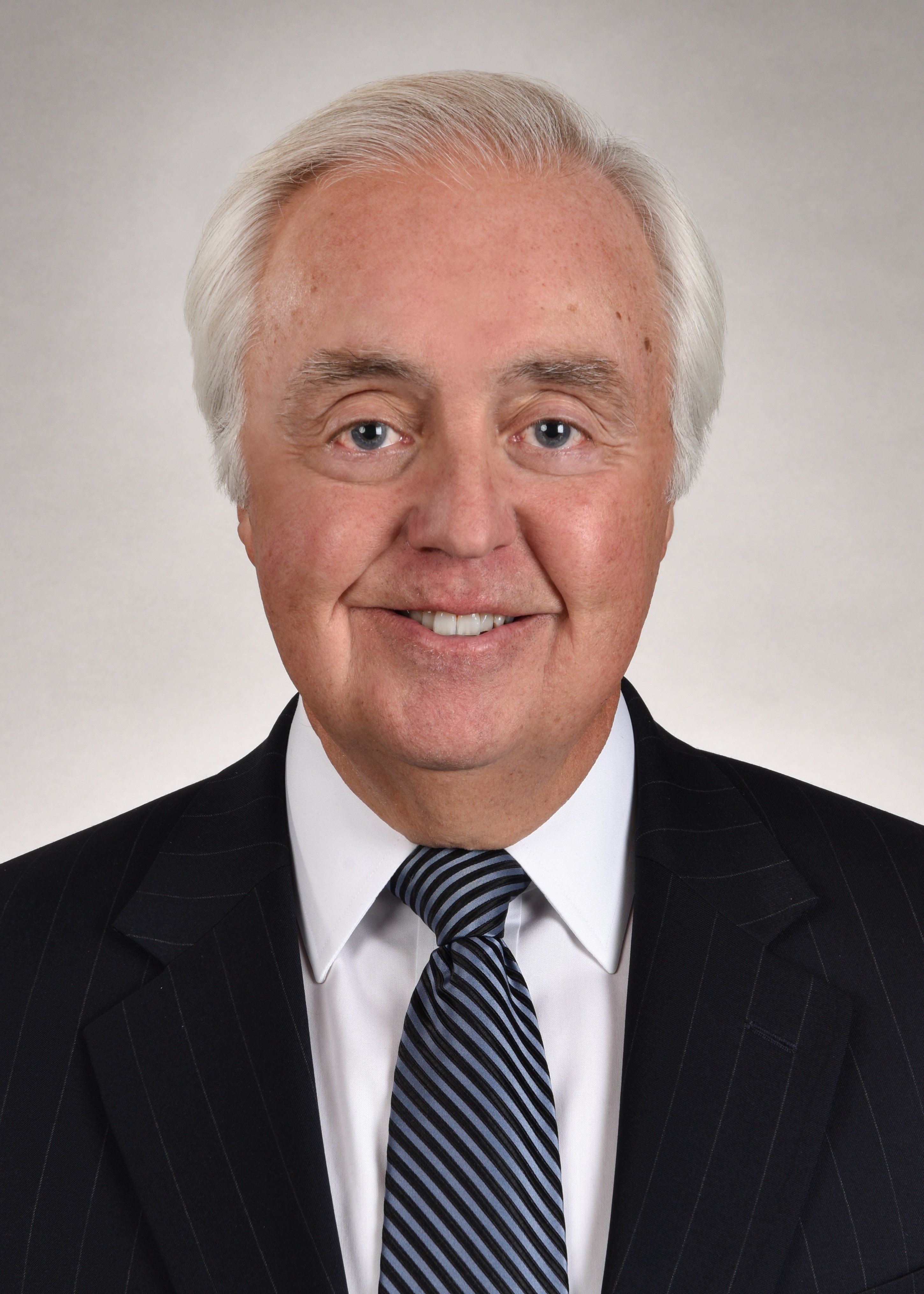 James W. Brown Director since 2017 Age Board Committees • Audit • Governance | |||||
QUALIFICATIONS, ATTRIBUTES AND SKILLS | |||||
•FS Credit Real Estate Income Trust (December 2021 to present) •FS Multi-Strategy Alternatives Fund/FS Series Trust | •FS Investment Corporation III EDUCATION •Bachelor’s degree, magna cum laude, from Villanova University •Juris Doctor degree from the University of Virginia Law School | ||||
29
 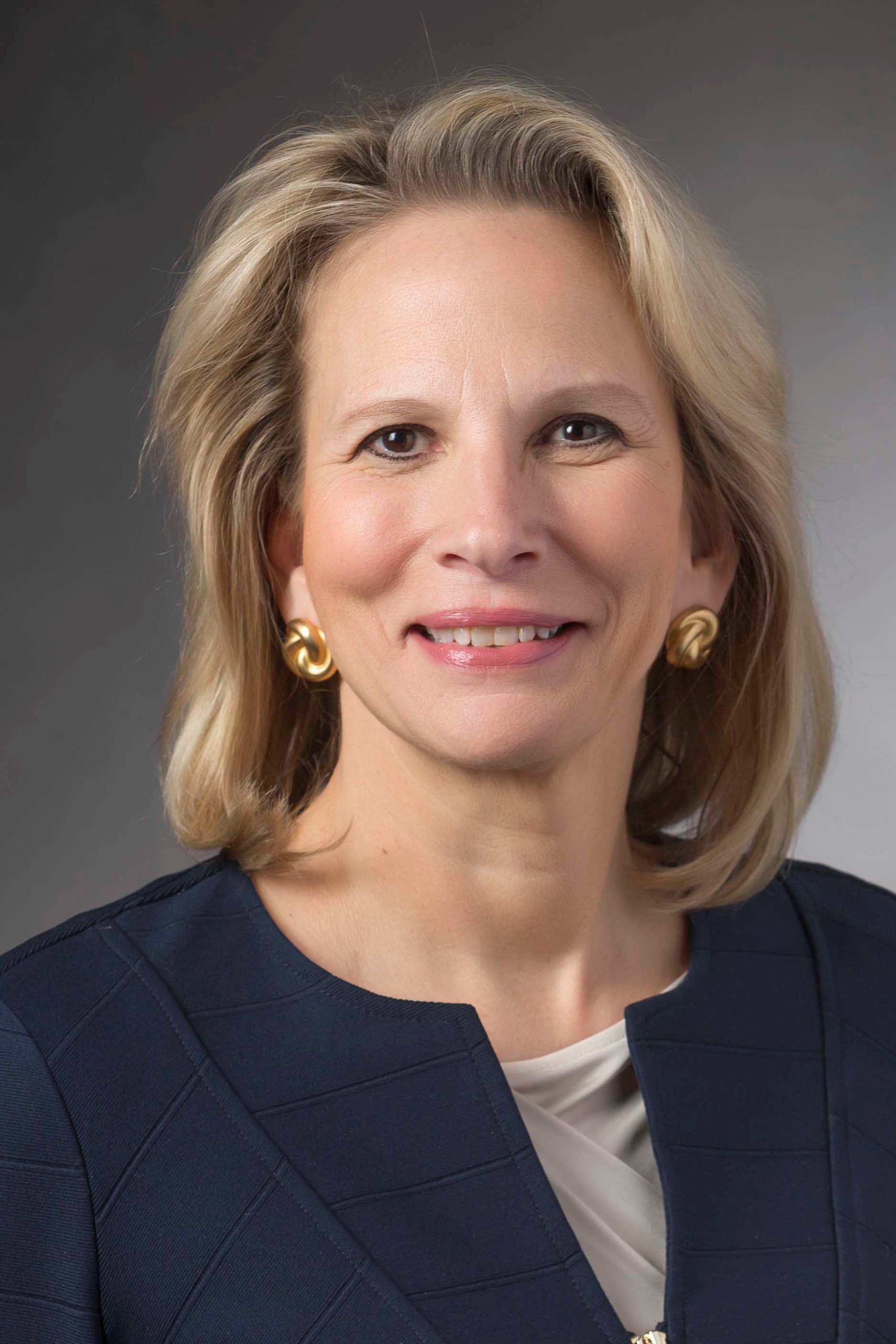 Michele G. Buck Director since 2017 Age Board Committees • Executive (Chair) | ||||
QUALIFICATIONS, ATTRIBUTES AND SKILLS As Chairman of the Board, President and Chief Executive Officer of the Company, a position she has held since October 2019, Ms. Buck is responsible for all day-to-day global operations and commercial activities of the Company. She previously served the Company in a variety of executive roles, including as President and Chief Executive Officer from March 2017 to October 2019 and as Executive Vice President and Chief Operating Officer from June 2016 to March 2017. Having served at the Company for more than | ||||
• New York Life Insurance Company (November 2013 to present) | EDUCATION • Bachelor’s degree from Shippensburg University of Pennsylvania • Masters of Business Administration degree from the University of North Carolina | |||

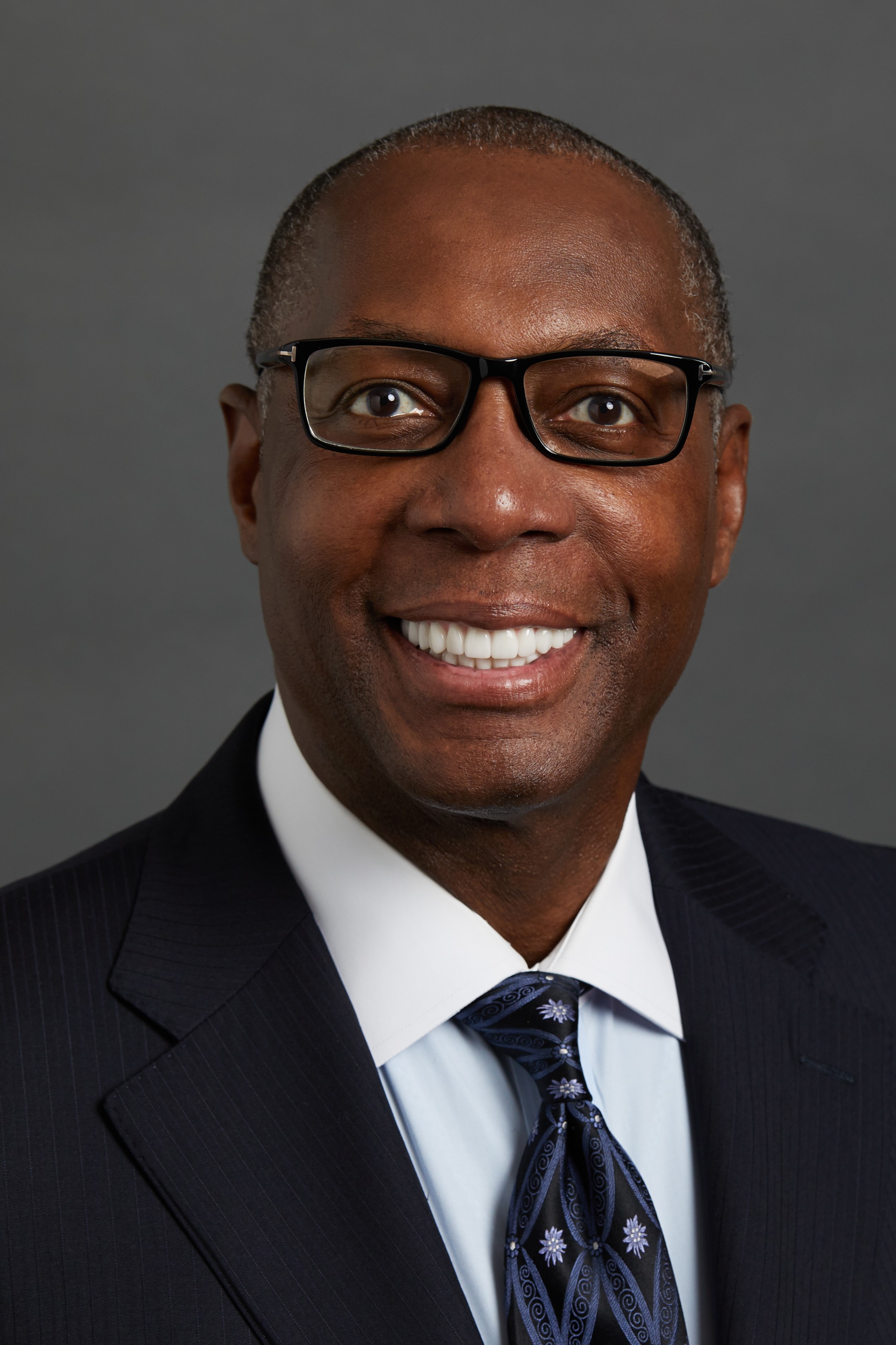 Victor L. Crawford Director Age • • Compensation | QUALIFICATIONS, ATTRIBUTES AND SKILLS Mr. Crawford is currently the Chief Executive Officer, Pharmaceutical Segment, of Cardinal Health, Inc., a global healthcare services and products company, | ||||
•Pelotonia (September 2020 to present) •Board of Trustees, National Urban League (October 2010 to present) •Dave & Buster’s Entertainment, Inc. (August 2016 to | EDUCATION •Bachelor of Science in accounting from Boston College | ||||
| One of two directors nominated for election by the holders of the Common Stock voting separately as a | |||||
30
  Director since Age Board Committees • •Governance | ||||
QUALIFICATIONS, ATTRIBUTES AND SKILLS Mr. Dutkowsky is the former Executive Chairman and Chief Executive Officer of Tech Data Corporation, a wholesale distributor of technology products, a position he held from June 2018 until his retirement in June 2020. He previously served as Chief Executive Officer of Tech Data from October 2006 to June 2018, including as Chairman of the Board from June 2017 until his appointment as Executive Chairman in June 2018. Prior to joining Tech Data, Mr. Dutkowsky served as President, Chief Executive Officer and Chairman of two software companies, Egenera, Inc. and J.D. Edwards & Co., Inc. Having | ||||
• • •US Foods, Inc. (January 2017 to present) •Tech Data Corporation (October | EDUCATION • One of two directors nominated for election by the Common Stock voting separately as a class | |||

 Mary Kay Haben Director since 2013 Age Board Committees • Governance (Chair) • Compensation • Executive | QUALIFICATIONS, ATTRIBUTES AND SKILLS Ms. Haben is the former President, North America, of Wm. Wrigley Jr. Company, a leading confectionery company, | ||||
2011. She served in several other senior management positions during her time at Wm. Wrigley Jr. Company, including as Group Vice President and Managing Director, North America. She also held a succession of leadership positions in her 27-year career at Kraft Foods, Inc., a grocery manufacturing and processing conglomerate. Throughout her career, Ms. | |||||
• Grocery Outlet Holding Corp. (November 2019 to present) • Trustee of Equity Residential (July 2011 to present) • Bob Evans Farms, Inc. (August 2012 to January 2018) | EDUCATION • Bachelor’s degree, magna cum laude, in business administration from the University of Illinois • Masters of Business Administration degree in marketing from the University of Michigan, Ross School of Business | ||||
31
 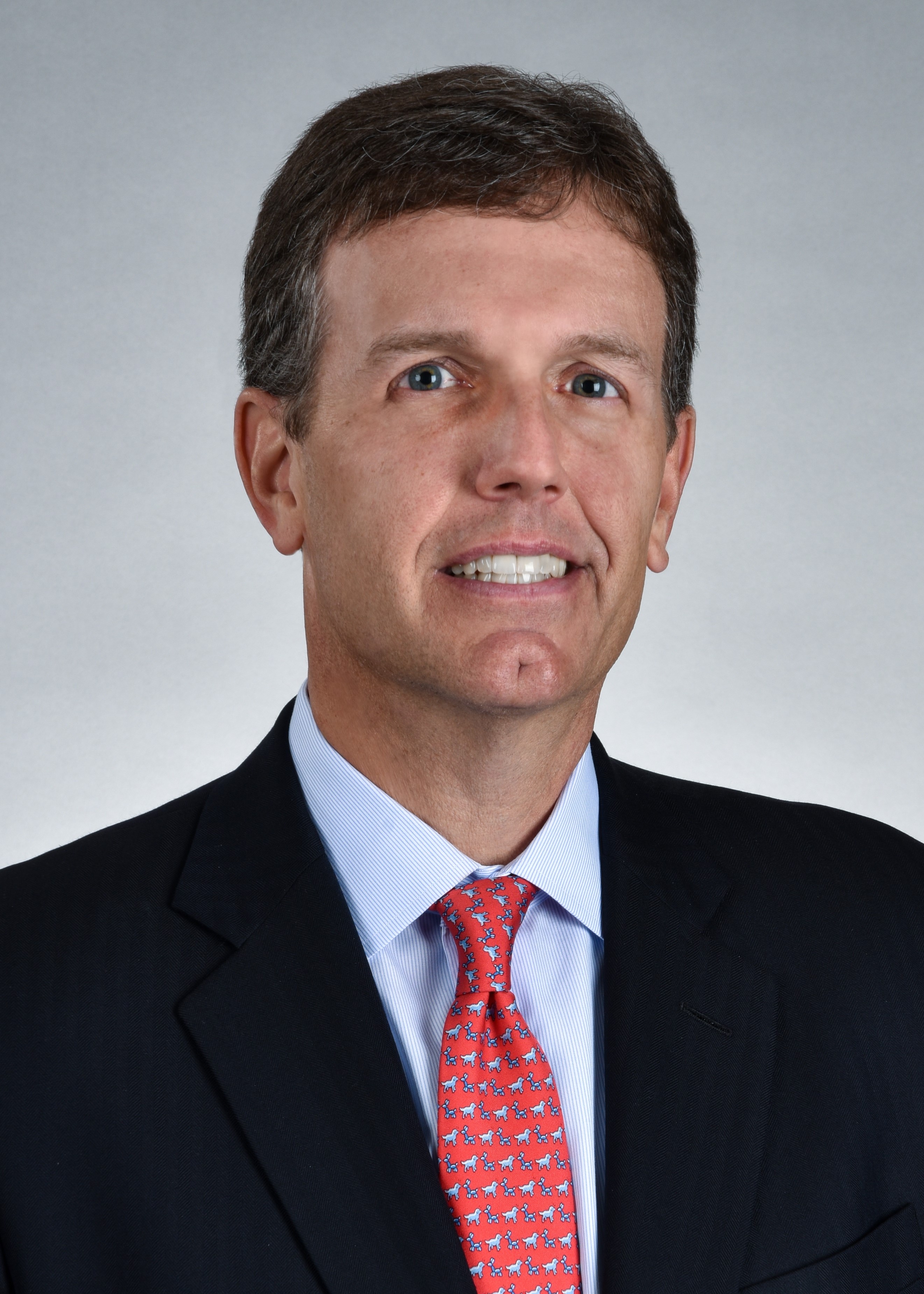 James C. Katzman Director since 2018 Age Board Committees • Finance and Risk Management • Governance | ||||
QUALIFICATIONS, ATTRIBUTES AND SKILLS | ||||
•Brinker International, Inc. (January 2018 to present) | EDUCATION •Bachelor’s degree, cum laude, from Dartmouth College •Masters of Business Administration degree from Columbia University Graduate School of Business | |||

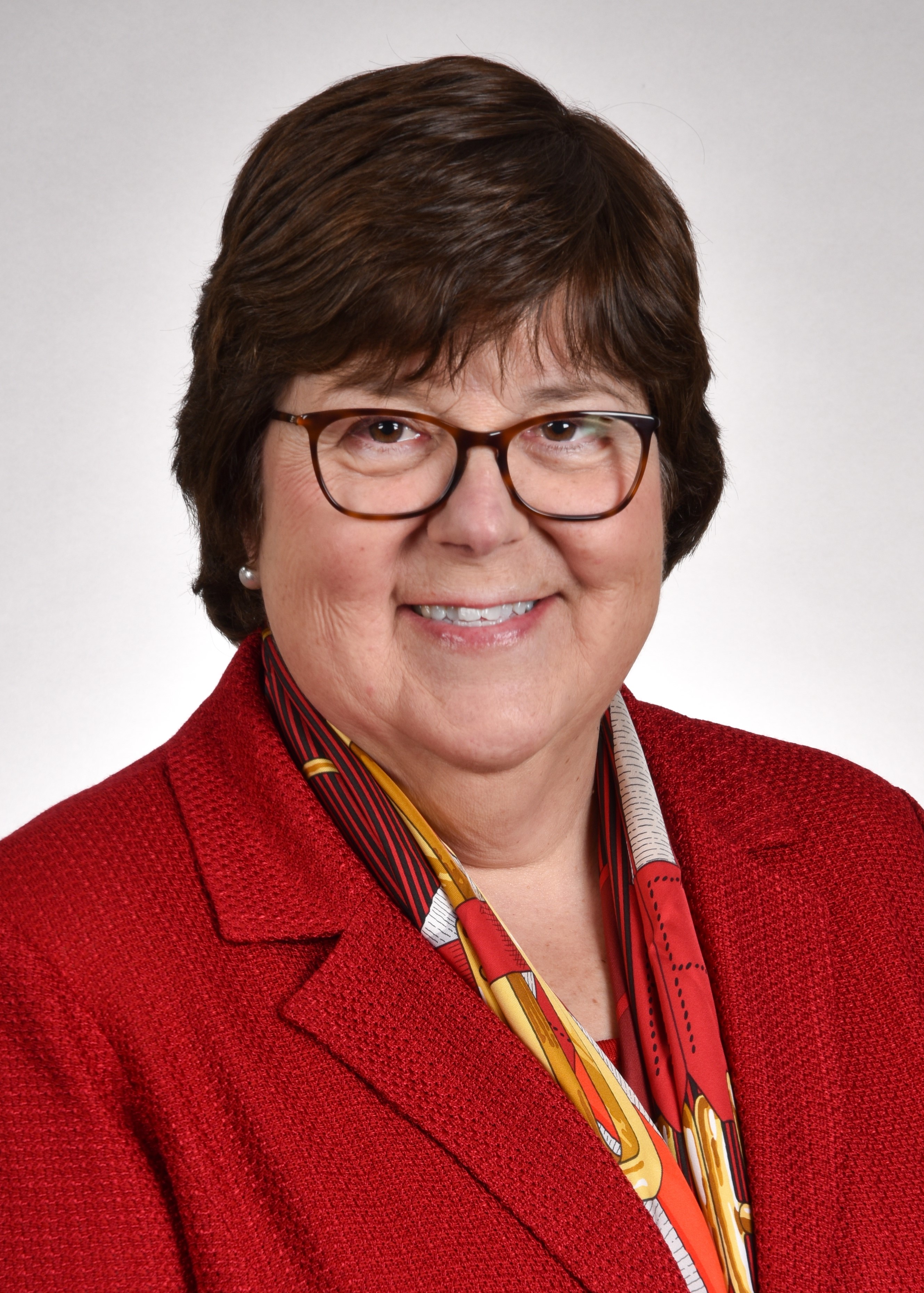 M. Diane Koken Director since 2017 Age Board Committees • Audit • Compensation | |||||
QUALIFICATIONS, ATTRIBUTES AND SKILLS | |||||
• Nationwide Mutual Funds and Nationwide Variable Insurance Trust (April 2019 to present) • Capital BlueCross (December 2011 to present) • • NORCAL Mutual (January 2009 to May 2021) | EDUCATION • Bachelor’s degree,magna cum laude, • Juris Doctor degree from Villanova University School of Law | ||||
32
  Robert M. Malcolm Director since 2011 Age Board Committees • Finance and Risk Management (Chair) • Audit • Executive | QUALIFICATIONS, ATTRIBUTES AND SKILLS Mr. Malcolm is the former President, Global Marketing, Sales & Innovation, of Diageo PLC, a leading premium drinks company, | ||||
that position, Mr. Malcolm spent 24 years at The Procter & Gamble Company in various leadership positions, including as Vice President – General Manager Beverages, Europe, Middle East and Africa, and Vice President – General Manager, Arabian Peninsula. He is a globally recognized expert in strategic marketing and is currently Executive in Residence, Center for Customer Insight and Marketing Solutions, McCombs School of Business, University of Texas. | |||||
•Boston Consulting Group (senior advisor) (December 2012 to present) | EDUCATION •Bachelor’s degree in marketing from the University of Southern California •Masters of Business Administration degree in marketing from the University of Southern California | ||||

 Anthony J. Palmer Lead Independent Director since May 2020 Director since 2011 Age Board Committees • Audit (ex-officio) • Compensation • Executive • • Governance (ex-officio) | |||||
QUALIFICATIONS, ATTRIBUTES AND SKILLS Mr. Palmer is the Founder and Chief Executive Officer of TropicSport, a natural and environmentally friendly e-commerce suncare and skincare products company, a position he has held since April 2019. Prior to founding TropicSport, Mr. Palmer held key leadership positions at Kimberly-Clark Corporation, a multinational personal care company, including serving as President, Global Brands and Innovation, from April 2012 to April 2019. Prior to Kimberly-Clark Corporation, Mr. Palmer served in various leadership positions at The Kellogg Company, a multinational food manufacturing company, and the Coca-Cola Company, a multinational beverage company. Having spent most of his | |||||
EDUCATION •Bachelor’s degree in business •Masters of Business Administration degree, with distinction, from the International Management Institute, Geneva, Switzerland | |||||
33
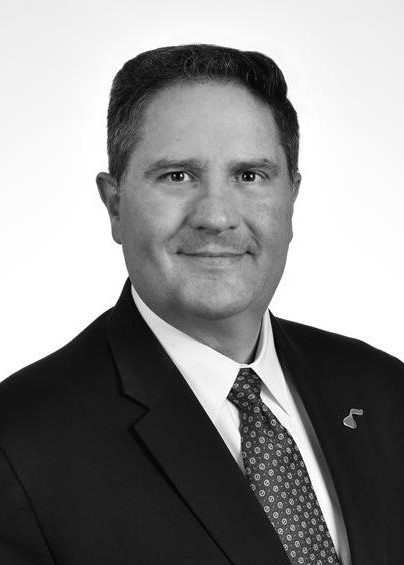 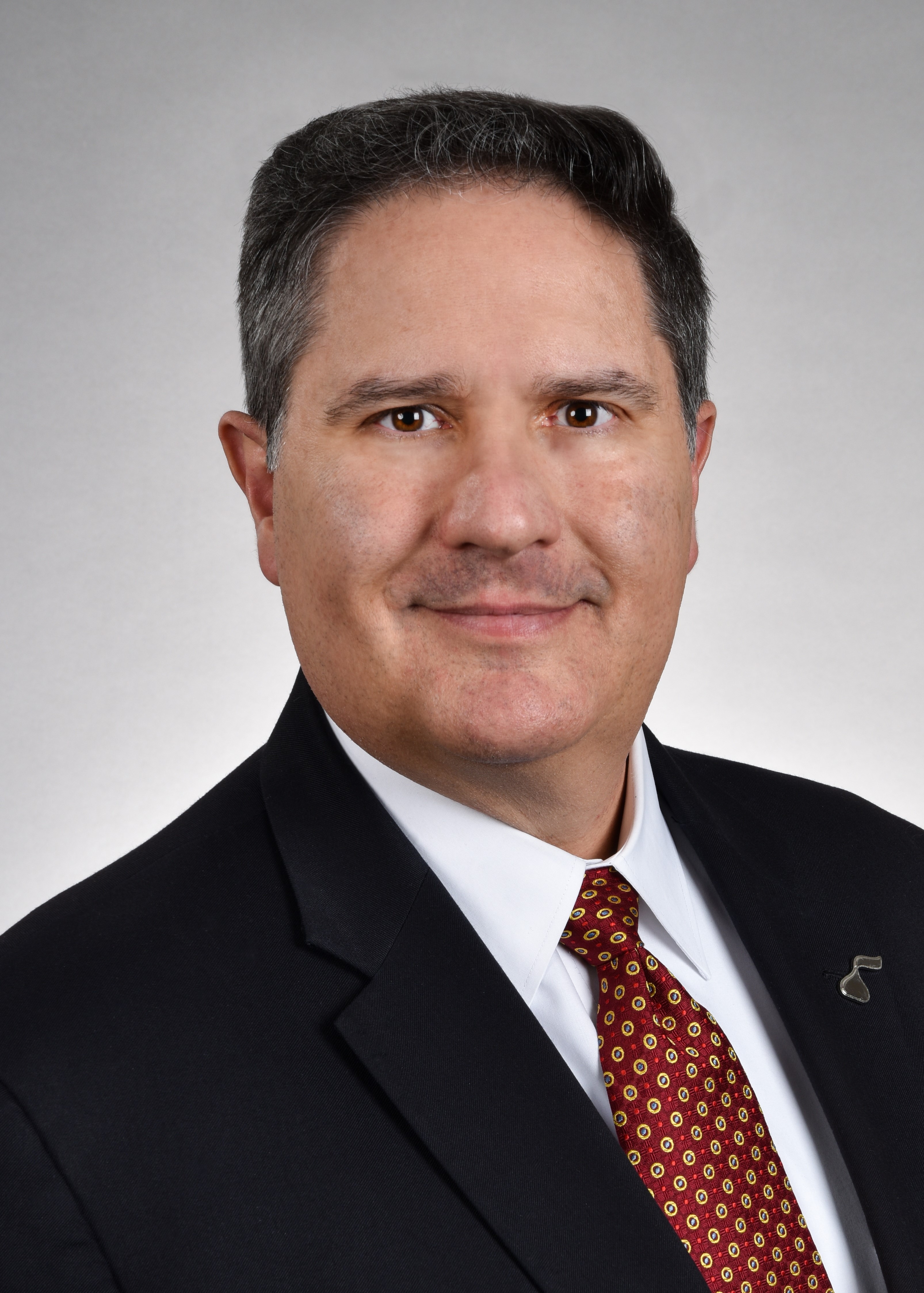 Juan R. Perez Director since 2019 Age 55 Board Committees • Finance and Risk Management • Governance | QUALIFICATIONS, ATTRIBUTES AND SKILLS Mr. Perez is the Executive Vice President and Chief Information | ||||
• | EDUCATION • Bachelor of Science in industrial and systems engineering from the University of Southern California • Masters of Science in computer and manufacturing | ||||
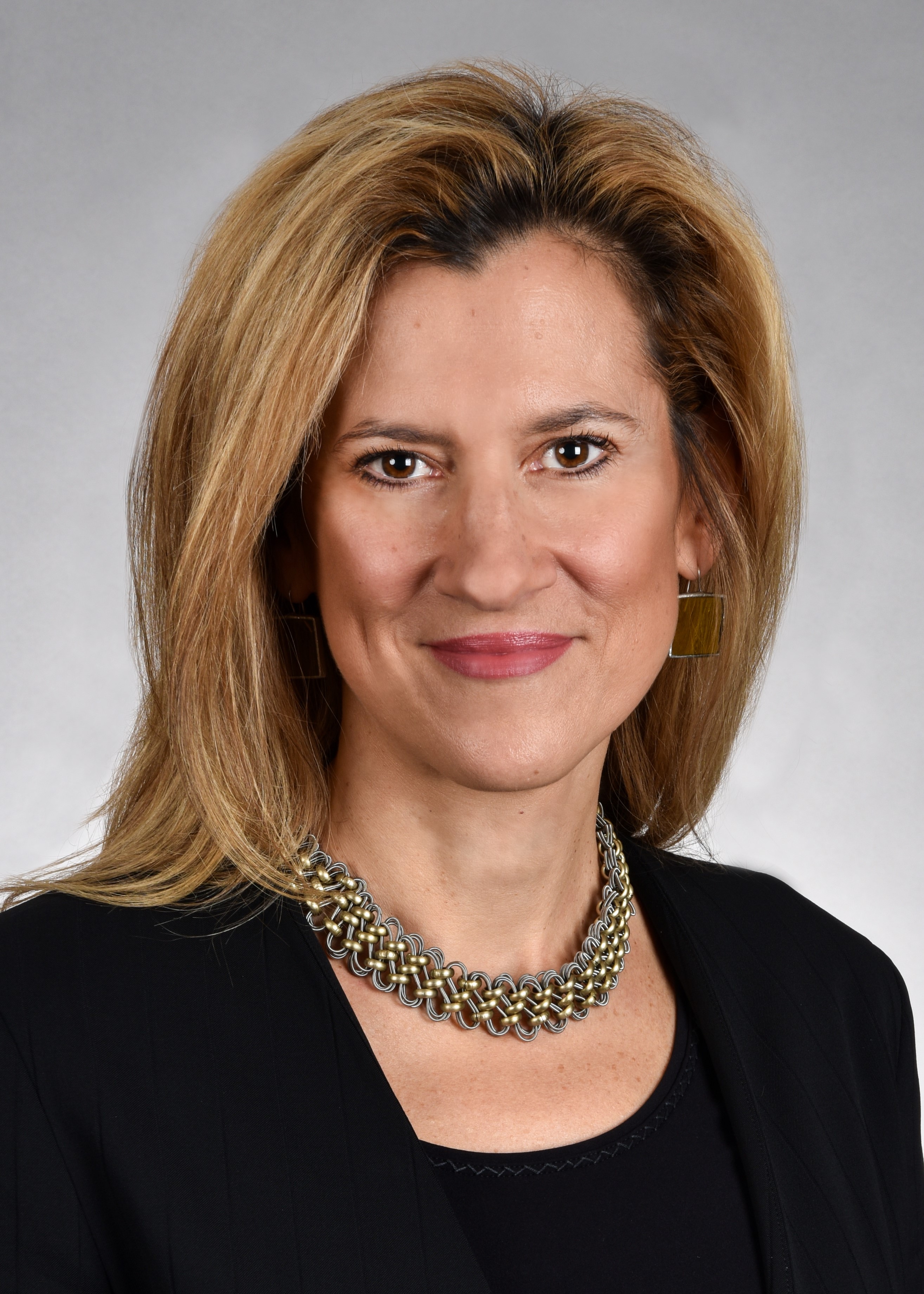 Wendy L. Schoppert Director since Age Board Committees • • Executive • Finance and Risk Management | |||||
 | QUALIFICATIONS, ATTRIBUTES AND SKILLS | ||
As Chief Financial Officer for Sleep Number Corporation, Ms. Schoppert gained extensive experience leading all finance functions, including financial planning and analysis, accounting, tax, treasury, investor relations, decision support and IT. Prior to joining Sleep Number in 2005, Ms. Schoppert led U.S. Bank’s Private Asset Management team and served as its Head of Product, Marketing and Corporate Development. She began her career in the airline industry, serving in various financial, strategic and general management leadership positions at American Airlines, Northwest Airlines and America West Airlines. Ms. Schoppert contributes to the Board through her extensive financial leadership experience, public company reporting expertise and retail experience across finance, IT, digital and marketing. | |||
• ODP Corporation (July 2020 to present) • Bremer Financial Corporation (May 2017 to present) • Big Lots, Inc. (May 2015 to present) | • Gaia, Inc. (formerly Gaiam, Inc.) (October 2013 to December 2018) EDUCATION • Bachelor of Arts in mathematics and operations research from Cornell University • Masters of Business Administration in finance and general management from Cornell University | ||
34
 | ||
NON-EMPLOYEE DIRECTOR COMPENSATION
The Hershey Company Directors’ Compensation Plan
We maintain a Directors’ Compensation Plan that is designed to:
•Attract and retain highly qualified, non-employee directors; and
•Align the interests of non-employee directors with those of our stockholders by paying a portion of non-employee compensation in units representing shares of our Common Stock.
Directors who are employees of the Company receive no additional compensation for their service on our Board. Ms. Buck is the only employee of the Company who also served as a director during 20192021 and thus received no additional compensation for her Board service.
The Board targets non-employee director compensation at the 50th percentile of compensation paid to directors at a peer group of companies we call the 20192021 Compensation Peer Group. Information about the 20192021 Compensation Peer Group is included in the section entitled “Setting Compensation” in the Compensation Discussion & Analysis. Each year, with the assistance of the Compensation Committee and the Compensation Committee’s independent compensation consultant, the Board reviews the compensation paid to directors at companies in the current peer group to determine whether any changes to non-employee director compensation are warranted.
As a result of its review in December 2018,October 2020, the Board increased the annual retainer for the Lead Independent Director from $25,000 to $30,000 and increased the annual Finance and Risk Management Committee Chair retainer from $15,000 to $20,000.
Accordingly, compensation paid to non-employee directors in 2021 was as follows:
| Form of Compensation | Payment ($) | ||||
Annual retainer for Chairman of the Board(1) (2) | 150,000 | ||||
Annual retainer for other non-employee directors | 105,000 | ||||
Annual RSU award | 160,000 | ||||
Annual retainer for Lead Independent Director(2) (3) | 30,000 | ||||
Annual retainers for chairs of Audit, Compensation and Finance and Risk Management Committees(2) | 20,000 | ||||
Annual retainer for chair of Governance Committee(2) | 15,000 | ||||
(1)Applies only when Chairman of the Board is a non-employee director.
(2)Paid in addition to $105,000 annual retainer for non-employee directors.
(3)A Lead Independent Director is appointed if the Chairman of the Board is not independent.
The Board completed its annual review of non-employee director compensation in October 2021 and determined that no changes to any of the compensation elements were warranted for 2019.2022.
Payment of Annual Retainer, Lead Independent Director Fee and Committee Chair Fees
The annual retainer (including the annual retainer for the Chairman of the Board, when applicable) and any applicable Lead Independent Director or committee chair feesretainers for all non-employee directors are paid in quarterly installments on the 15th day of March, June, September and December, or the prior business day if the 15th is not a business day. Non-employee directors may elect to receive all or a portion of the annual retainer (including the annual retainer for the Chairman of the Board, when applicable) in cash or in Common Stock. Non-employee directors may also elect to defer receipt of all or a portion of the retainer (including the annual retainer for the Chairman of the Board, when applicable), any applicable Lead Independent Director feeretainer or committee chair feesretainers until the date their membership on the Board ends. Lead Independent Director and committee chair feesretainers that are not deferred are paid only in cash.
35
Non-employee directors choosing to defer all or a portion of their retainer, any applicable Lead Independent Director feeretainer or committee chair feesretainers may invest the deferred amounts in two ways:
•In a cash account that values the performance of the investment based upon the performance of one or more third-party investment funds selected by the director from among the mutual funds or other investment options available to all employees participating in our 401(k) Plan.plan. Amounts invested in the cash account are paid only in cash.
•In a deferred common stock unit account that we value according to the performance of our Common Stock, including reinvested dividends. Amounts invested in the deferred common stock unit account are paid in shares of Common Stock.
Restricted Stock Units (“RSUs”)
RSUs are granted quarterly to non-employee directors on the first day of January, April, July and October. In 2019,2021, the number of RSUs granted in each quarter was determined by dividing $38,750$40,000 by the average closing price of a share of our Common Stock on the New York Stock Exchange (“NYSE”)NYSE on the last three trading days preceding the grant date. RSUs awarded to non-employee directors vest one year after the date of grant, or earlier upon termination of the director’s membership on the Board by reason of retirement (termination of service from the Board after the director’s 60th birthday), death or disability, for any reason after a Change in Control as defined in our Executive Benefits Protection Plan (Group 3A) (“EBPP 3A”), or under such other circumstances as the Board may determine. Vested RSUs are payable to directors in shares of Common Stock or, at the option of the director, can be deferred as common stockCommon Stock units under the Directors’ Compensation Plan until the director’s membership on the Board ends. Dividend equivalent units are credited at regular rates on the RSUs during the restriction period and, upon vesting of the RSUs, are payable in shares of Common Stock or deferred as common stockCommon Stock units together with any RSUs the director has deferred.
As of March 13, 2020,18, 2022, Messrs. Brown, Davis,Crawford, Dutkowsky, Malcolm Palmer and ShedlarzPalmer and Mmes. Arway, Haben and Koken had attained retirement age for purposes of the vesting of RSUs.
Other Compensation, Reimbursements and Programs
The Board occasionally establishes committees of limited duration for special purposes. When a special committee is established, the Board will determine whether to provide non-employee directors with additional compensation for service on such committee based on the expected duties of the committee, the anticipated number and length of any committee meetings and other factors the Board, in its discretion, may deem relevant. No such committees were established in 2019.2021.
We reimburse our directors for travel and other out-of-pocket expenses they incur when attending Board and committee meetings and for minor incidental expenses they incur when performing directors’ services. We also provide reimbursement for at least one director continuing education program each year. Directors receive travel accident insurance while traveling on the Company’s business and receive discounts on the purchase of our products to the same extent and on the same terms as our employees. Directors also are eligible to participate in the Company’s Gift Matching Program. Under the Gift Matching Program, the Company will match, upon a director’s request, contributions made by the director to one or more charitable organizations, on a dollar-for-dollar basis up to a maximum aggregate contribution of $5,000 annually.
Stock Ownership Guidelines
Pursuant to the Board’s Corporate Governance Guidelines, non-employee directors are expected to own shares of Common Stock having a value equal to at least five times the annual retainer. Each non-employee director has until January 1 of the year following his or her fifth anniversary of becoming a director to satisfy the ownership guideline. The Compensation Committee reviews the stock ownership guidelines annually to ensure they are aligned with external market comparisons.
36
The following table and explanatory footnotes provide information with respect to the compensation paid or provided to non-employee directors during 2019:2021:
Name(1) | Fees Earned or Paid in Cash(2) ($) | Stock Awards(3) ($) | All Other Compensation(4) ($) | Total ($) | ||||||||||
| Pamela M. Arway | 125,000 | 160,000 | 5,000 | 290,000 | ||||||||||
| James W. Brown | 105,000 | 160,000 | 5,000 | 270,000 | ||||||||||
| Victor L. Crawford | 105,000 | 160,000 | 5,000 | 270,000 | ||||||||||
| Charles A. Davis | 39,808 | 60,660 | 5,000 | 105,468 | ||||||||||
| Robert M. Dutkowsky | 105,000 | 160,000 | — | 265,000 | ||||||||||
| Mary Kay Haben | 120,000 | 160,000 | 5,000 | 285,000 | ||||||||||
| James C. Katzman | 105,000 | 160,000 | 5,000 | 270,000 | ||||||||||
| M. Diane Koken | 105,000 | 160,000 | 5,000 | 270,000 | ||||||||||
| Robert M. Malcolm | 125,000 | 160,000 | 5,000 | 290,000 | ||||||||||
| Anthony J. Palmer | 135,000 | 160,000 | 5,000 | 300,000 | ||||||||||
| Juan R. Perez | 105,000 | 160,000 | — | 265,000 | ||||||||||
| Wendy L. Schoppert | 117,473 | 160,000 | 3,283 | 280,756 | ||||||||||
| David L. Shedlarz | 47,390 | 60,660 | — | 108,050 | ||||||||||
____________________
(1)
___________________Messrs. Davis and Shedlarz retired from the Board on May 17, 2021.
Name(1) | Fees Earned or Paid in Cash(2) ($) | Stock Awards(3) ($) | All Other Compensation(4) ($) | Total ($) | ||||
| Pamela M. Arway | 100,000 | 155,000 | 5,000 | 260,000 | ||||
| James W. Brown | 100,000 | 155,000 | 5,000 | 260,000 | ||||
| Charles A. Davis | 223,506 | 155,000 | 5,000 | 383,506 | ||||
| Mary Kay Haben | 115,000 | 155,000 | 5,000 | 275,000 | ||||
| James C. Katzman | 100,000 | 155,000 | 5,000 | 260,000 | ||||
| M. Diane Koken | 100,000 | 155,000 | 5,000 | 260,000 | ||||
| Robert M. Malcolm | 115,000 | 155,000 | 5,000 | 275,000 | ||||
| Anthony J. Palmer | 115,000 | 155,000 | 1,500 | 271,500 | ||||
| Juan R. Perez | 61,264 | 94,959 | — | 156,223 | ||||
| Wendy L. Schoppert | 100,000 | 155,000 | 5,000 | 260,000 | ||||
| David L. Shedlarz | 120,000 | 155,000 | — | 275,000 | ||||
(2)Includes amounts earned or paid in cash or shares of Common Stock at the election of the director or deferred by the director under the Directors’ Compensation Plan. Amounts credited as earnings on amounts deferred under the Directors’ Compensation Plan are based on investment options available to all participants in our 401(k) plan or our Common Stock and, accordingly, the earnings credited during 2021 were not considered “above market” or “preferential” earnings.
The following table sets forth the portion of fees earned or paid in cash or Common Stock, and the portion deferred with respect to retainers and fees earned during 2019:
Name | Immediate Payment | Deferred and Investment Election | ||||||||||
Cash Paid ($) | Value Paid in Shares of Common Stock ($) | Number of Shares of Common Stock (#) | Value Deferred to a Cash Account ($) | Value Deferred to a Common Stock Unit Account ($) | Number of Deferred Common Stock Units (#) | |||||||
| Pamela M. Arway | 100,000 | — | — | — | — | — | ||||||
| James W. Brown | 100,000 | — | — | — | — | — | ||||||
| Charles A. Davis | 223,506 | — | — | — | — | — | ||||||
| Mary Kay Haben | 115,000 | — | — | — | — | — | ||||||
| James C. Katzman | — | — | — | — | 100,000 | 781 | ||||||
| M. Diane Koken | 100,000 | — | — | — | — | — | ||||||
| Robert M. Malcolm | 115,000 | — | — | — | — | — | ||||||
| Anthony J. Palmer | 15,000 | 100,000 | 781 | — | — | — | ||||||
| Juan R. Perez | 52,074 | 9,190 | 65 | — | — | — | ||||||
| Wendy L. Schoppert | 100,000 | — | — | — | — | — | ||||||
| David L. Shedlarz | 120,000 | — | — | — | — | — | ||||||
2021:
| Name | Immediate Payment | Deferred and Investment Election | ||||||||||||||||||
| Cash Paid ($) | Value Paid in Shares of Common Stock ($) | Number of Shares of Common Stock (#) | Value Deferred to a Cash Account ($) | Value Deferred to a Common Stock Unit Account ($) | Number of Deferred Common Stock Units (#) | |||||||||||||||
| Pamela M. Arway | 125,000 | — | — | — | — | — | ||||||||||||||
| James W. Brown | 105,000 | — | — | — | — | — | ||||||||||||||
| Victor L. Crawford | — | — | — | 105,000 | — | — | ||||||||||||||
| Charles A. Davis | 39,808 | — | — | — | — | — | ||||||||||||||
| Robert M. Dutkowsky | 105,000 | — | — | — | — | — | ||||||||||||||
| Mary Kay Haben | 120,000 | — | — | — | — | — | ||||||||||||||
| James C. Katzman | — | — | — | — | 105,000 | 636 | ||||||||||||||
| M. Diane Koken | 105,000 | — | — | — | — | — | ||||||||||||||
| Robert M. Malcolm | 125,000 | — | — | — | — | — | ||||||||||||||
| Anthony J. Palmer | — | — | — | — | 135,000 | 817 | ||||||||||||||
| Juan R. Perez | 89,250 | 15,750 | 94 | — | — | — | ||||||||||||||
| Wendy L. Schoppert | 117,473 | — | — | — | — | — | ||||||||||||||
| David L. Shedlarz | 47,390 | — | — | — | — | — | ||||||||||||||
(3)Represents the dollar amount recognized as expense during 2021 for financial statement reporting purposes with respect to RSUs awarded to the directors during 2021. RSUs awarded to directors are charged to expense in the Company’s financial statements at the grant date fair value on each quarterly grant date. The target annual grant date fair value of the RSUs for each director during 2021 was $160,000.
37
The following table provides information with respect to the number and market value of deferred common stockCommon Stock units and RSUs held as of December 31, 2019,2021, based on the $146.98$193.47 closing price of our Common Stock as reported by NYSE on December 31, 2019,2021, the last trading day of 2019.
2021. The information presented includes the accumulated value of each director’s deferred common stockCommon Stock units and RSUs. Balances shown below include dividend equivalent units credited in the form of additional common stockCommon Stock units on deferred amounts and dividend equivalent units credited in the form of additional common stockCommon Stock units on RSUs.
| Name | Number of Deferred Common Stock Units (#) | Market Value of Deferred Common Stock Units as of December 31, 2021 ($) | Number of RSUs (#) | Market Value of RSUs as of December 31, 2021 ($) | ||||||||||
| Pamela M. Arway | — | — | 993 | 192,116 | ||||||||||
| James W. Brown | 5,195 | 1,005,077 | 993 | 192,116 | ||||||||||
| Victor L. Crawford | 782 | 151,294 | 993 | 192,116 | ||||||||||
| Charles A. Davis | — | — | — | — | ||||||||||
| Robert M. Dutkowsky | — | — | 993 | 192,116 | ||||||||||
| Mary Kay Haben | 11,268 | 2,180,020 | 993 | 192,116 | ||||||||||
| James C. Katzman | 6,592 | 1,275,354 | 993 | 192,116 | ||||||||||
| M. Diane Koken | 5,195 | 1,005,077 | 993 | 192,116 | ||||||||||
| Robert M. Malcolm | — | — | 993 | 192,116 | ||||||||||
| Anthony J. Palmer | 824 | 159,419 | 993 | 192,116 | ||||||||||
| Juan R. Perez | — | — | 993 | 192,116 | ||||||||||
| Wendy L. Schoppert | 4,290 | 829,986 | 993 | 192,116 | ||||||||||
| David L. Shedlarz | — | — | — | — | ||||||||||
(4)Represents the Company match for contributions made by the director to one or more charitable organizations during 2021 under the Gift Matching Program.
38
Name | Number of Deferred Common Stock Units (#) | Market Value of Deferred Common Stock Units as of December 31, 2019 ($) | Number of RSUs (#) | Market Value of RSUs as of December 31, 2019 ($) | ||||
| Pamela M. Arway | — | — | 1,261 | 185,342 | ||||
| James W. Brown | 2,561 | 376,416 | 1,261 | 185,342 | ||||
| Charles A. Davis | — | — | 1,261 | 185,342 | ||||
| Mary Kay Haben | 8,381 | 1,231,839 | 1,261 | 185,342 | ||||
| James C. Katzman | 2,561 | 376,416 | 1,261 | 185,342 | ||||
| M. Diane Koken | 2,561 | 376,416 | 1,261 | 185,342 | ||||
| Robert M. Malcolm | — | — | 1,261 | 185,342 | ||||
| Anthony J. Palmer | — | — | 1,261 | 185,342 | ||||
| Juan R. Perez | — | — | 698 | 102,592 | ||||
| Wendy L. Schoppert | 1,694 | 248,984 | 1,261 | 185,342 | ||||
| David L. Shedlarz | — | — | 1,261 | 185,342 | ||||
SHARE OWNERSHIP OF DIRECTORS, MANAGEMENT
AND CERTAIN BENEFICIAL OWNERS
The following table sets forth information with respect to the beneficial ownership of our outstanding voting securities and exercisable stock options by:
•Stockholders who we believe owned more than 5% of our outstanding Common Stock or Class B Common Stock, as of March 13, 2020;18, 2022; and
•Our directors, director nominees, NEOs and all directors and executive officers as a group, as of March 13, 2020.18, 2022.
Holder | Common Stock(1) | Exercisable Stock Options | Percent of Common Stock(2) | Class B Common Stock | Percent of Class B Common Stock(3) | Holder | Common Stock(1) | Exercisable Stock Options | Percent of Common Stock(2) | Class B Common Stock | Percent of Class B Common Stock(3) | ||||||||||||||||
Hershey Trust Company, as trustee for the Milton Hershey School Trust(4) 100 Mansion Road Hershey, PA 17033 Milton Hershey School(4) Founders Hall Hershey, PA 17033 | 47,170 | — | ** | 60,612,012 | 99.9 | ||||||||||||||||||||||
Hershey Trust Company(5) | 76,430 | — | ** | — | — | ||||||||||||||||||||||
BlackRock, Inc.(6) 55 East 52nd Street New York, NY 10055 | 16,294,676 | — | 11.0 | — | — | ||||||||||||||||||||||
Vanguard Group, Inc.(7) 100 Vanguard Blvd. Malvern, PA 19355 | 12,633,520 | — | 8.5 | — | — | ||||||||||||||||||||||
State Street Corporation(8) One Lincoln Street Boston, MA 02111 | 7,757,967 | — | 5.2 | — | — | ||||||||||||||||||||||
Hershey Trust Company(4) | Hershey Trust Company(4) | 48,230 | — | ** | — | — | |||||||||||||||||||||
Hershey Trust Company, as trustee for the Milton Hershey School Trust(5) 100 Mansion Road, Hershey, PA 17033 Milton Hershey School(5) Founders Hall, Hershey, PA 17033 | Hershey Trust Company, as trustee for the Milton Hershey School Trust(5) 100 Mansion Road, Hershey, PA 17033 Milton Hershey School(5) Founders Hall, Hershey, PA 17033 | 47,170 | — | ** | 59,612,012 | 99.9 | |||||||||||||||||||||
Vanguard Group, Inc.(6) 100 Vanguard Blvd, Malvern, PA 19355 | Vanguard Group, Inc.(6) 100 Vanguard Blvd, Malvern, PA 19355 | 13,841,275 | — | 9.5 | — | — | |||||||||||||||||||||
BlackRock, Inc.(7) 55 East 52nd Street, New York, NY 10055 | BlackRock, Inc.(7) 55 East 52nd Street, New York, NY 10055 | 13,318,795 | — | 9.1 | — | — | |||||||||||||||||||||
State Street Corporation(8) One Lincoln Street, Boston, MA 02111 | State Street Corporation(8) One Lincoln Street, Boston, MA 02111 | 7,363,655 | — | 5.0 | — | — | |||||||||||||||||||||
Pamela M. Arway* | 15,172 | — | ** | — | — | Pamela M. Arway* | 15,080 | — | ** | — | — | ||||||||||||||||
| Damien Atkins | 1,473 | 3,056 | ** | — | — | ||||||||||||||||||||||
James W. Brown* | — | — | ** | — | — | James W. Brown* | — | — | ** | — | — | ||||||||||||||||
Michele G. Buck* | 65,246 | 228,283 | ** | — | — | Michele G. Buck* | 97,778 | 281,530 | ** | — | — | ||||||||||||||||
Victor L. Crawford* | — | — | ** | — | — | Victor L. Crawford* | — | — | ** | — | — | ||||||||||||||||
Charles A. Davis* | 23,522 | — | ** | — | — | ||||||||||||||||||||||
Robert M. Dutkowsky* | Robert M. Dutkowsky* | 926 | — | ** | — | — | |||||||||||||||||||||
Mary Kay Haben* | — | — | ** | — | — | Mary Kay Haben* | — | — | ** | — | — | ||||||||||||||||
James C. Katzman* | — | — | ** | — | — | James C. Katzman* | — | — | ** | — | — | ||||||||||||||||
M. Diane Koken* | 600 | — | ** | — | — | M. Diane Koken* | 600 | — | ** | — | — | ||||||||||||||||
| Patricia A. Little | — | — | ** | — | — | ||||||||||||||||||||||
Robert M. Malcolm* | 11,480 | — | ** | — | — | Robert M. Malcolm* | 13,744 | — | ** | — | — | ||||||||||||||||
| Terence L. O’Day | 26,714 | 138,873 | ** | — | — | ||||||||||||||||||||||
Anthony J. Palmer* | 10,754 | — | ** | — | — | Anthony J. Palmer* | 13,170 | — | ** | — | — | ||||||||||||||||
Juan R. Perez* | 91 | — | ** | — | — | Juan R. Perez* | 2,711 | — | ** | — | — | ||||||||||||||||
| Charles R. Raup | Charles R. Raup | 12,380 | — | ** | — | — | |||||||||||||||||||||
| Jason R. Reiman | Jason R. Reiman | 8,443 | 6,250 | ** | — | — | |||||||||||||||||||||
| Kristen J. Riggs | Kristen J. Riggs | 6,264 | 608 | ** | — | — | |||||||||||||||||||||
Wendy L. Schoppert* | — | — | ** | — | — | Wendy L. Schoppert* | — | — | ** | — | — | ||||||||||||||||
David L. Shedlarz* | 13,807 | — | ** | — | — | ||||||||||||||||||||||
| Steven E. Voskuil | 1,000 | — | ** | — | — | Steven E. Voskuil | 20,351 | — | ** | — | — | ||||||||||||||||
| Mary Beth West | 21,265 | 30,619 | ** | — | — | ||||||||||||||||||||||
| All directors and executive officers as a group (22 persons) | 204,394 | 415,565 | ** | — | — | ||||||||||||||||||||||
| All directors and executive officers as a group (19 persons) | All directors and executive officers as a group (19 persons) | 205,268 | 294,750 | ** | — | — | |||||||||||||||||||||
____________________
| * | Director/Director nominee | |||||||||||||
| ** | Less than 1% | |||||||||||||
39
(1)Amounts listed also include the following RSUs that will vest and be paid to the following holders within 60 days of March 13, 2020:18, 2022:
Name | RSUs (#) | ||||
| Pamela M. Arway | |||||
| Michele G. Buck | |||||
| Robert M. Malcolm | |||||
| Kristen J. Riggs | 946 | ||||
| Steven E. Voskuil | 1,260 | ||||
For all directors and executive officers as a group, the amount listed also includes 1,515 RSUs that will vest and be paid within 60 days of March 18, 2022 to executive officers who are not a NEO.
Amounts listed also include shares for which certain of the directors share voting and/or investment power with one or more other persons as follows: Ms. Arway, 14,825 shares owned jointly with her spouse; Ms. Koken, 600 shares held at Glenmede Trust Company; Mr. Malcolm, 11,13313,489 shares owned jointly with his spouse;spouse and Mr. Palmer, 10,40713,170 shares owned jointly with his spouse.
(2)Based upon 145,928,920 shares of Common Stock outstanding on March 18, 2022.
(3)Based upon 59,613,777 shares of Class B Common Stock outstanding on March 18, 2022.
(4)Please see the section entitled “Information Regarding Our Controlling Stockholder” for more information about shares of Common Stock held by Hershey Trust Company as investments.
(5)Hershey Trust Company, as trustee for the Milton Hershey School Trust, has the right at any time to convert its Class B Common Stock into Common Stock on a share-for-share basis. If on March 18, 2022, Hershey Trust Company, as trustee for the Milton Hershey School Trust, converted all of its Class B Common Stock into Common Stock, Hershey Trust Company, as trustee for the Milton Hershey School Trust, would own beneficially 59,659,182 shares of our Common Stock (47,170 Common Stock shares plus 59,612,012 converted Class B Common Stock shares), or 29.0% of the 205,540,932 shares of Common Stock outstanding following the conversion (calculated as 145,928,920 Common Stock shares outstanding prior to the conversion plus 59,612,012 converted Class B Common Stock shares). For more information about the Milton Hershey School Trust, Hershey Trust Company, Milton Hershey School and the ownership and voting of these securities, please see the section entitled “Information Regarding Our Controlling Stockholder.”
(6)Information regarding Vanguard Group, Inc. and its beneficial holdings was obtained from a Schedule 13G/A filed with the SEC on February 10, 2022. The filing indicated that, as of December 31, 2021, Vanguard Group, Inc. had sole voting power over no shares, shared voting power over 244,857 shares, sole investment power over 13,238,323 shares and shared investment power over 602,952 shares. The filing indicated that Vanguard Group, Inc. is an investment advisor in accordance with Rule 13d-1(b)(1)(ii)(E).
(7)Information regarding BlackRock, Inc. and its beneficial holdings was obtained from a Schedule 13G/A filed with the SEC on February 1, 2022. The filing indicated that, as of December 31, 2021, BlackRock, Inc. had sole voting power over 11,627,209 shares, shared voting power over no shares, sole investment power over 13,318,795 shares and shared investment power over no shares. The filing indicated that BlackRock, Inc. is a parent holding company or control person in accordance with Rule 13d-1(b)(1)(ii)(G).
(8)Information regarding State Street Corporation and its beneficial holdings was obtained from a Schedule 13G filed with the SEC on February 11, 2022. The filing indicated that, as of December 31, 2021, State Street Corporation had sole voting and investment power over no shares, shared voting power over 6,005,771 shares and shared investment power over 7,315,013 shares. The filing indicated that State Street Corporation is a parent holding company or control person in accordance with Rule 13d-1(b)(1)(ii)(G).
Ownership of Other Company Securities
Certain directors and NEOs hold Company securities not reflected in the beneficial ownership table above because they will not convert, or cannot be converted, to shares of Common Stock within 60 days of our March 13, 2020 Record Date. These securities include:
•Certain unvested RSUs or deferred common stockCommon Stock units held by our directors and NEOs; and
•Certain unvested stock options held by our NEOs.
40
The table below shows these holdings as of March 13, 2020.our Record Date. You can find additional information about RSUs and deferred common stockCommon Stock units held by directors in the section entitled “Non-Employee Director Compensation.” You can find additional information about stock options, RSUs and deferred common stockCommon Stock units held by the NEOs in the section entitled “Executive Compensation.“Compensation Discussion & Analysis.”
___________________
Holder | Shares Underlying RSUs and Common Stock Units Not Beneficially Owned | Shares Underlying Stock Options Not Beneficially Owned | ||
Pamela M. Arway* | 814 | — | ||
| Damien Atkins | 5,336 | 9,169 | ||
James W. Brown* | 4,094 | — | ||
Michele G. Buck* | 109,182 | 64,743 | ||
| Victor L. Crawford* | — | — | ||
Charles A. Davis* | 814 | — | ||
Mary Kay Haben* | 9,913 | — | ||
James C. Katzman* | 4,267 | — | ||
M. Diane Koken* | 4,094 | — | ||
| Patricia A. Little | — | — | ||
Robert M. Malcolm* | 814 | — | ||
| Terence L. O’Day | 6,137 | 14,577 | ||
Anthony J. Palmer* | 814 | — | ||
Juan R. Perez* | 970 | — | ||
Wendy L. Schoppert* | 3,227 | — | ||
David L. Shedlarz* | 814 | — | ||
| Steven E. Voskuil | 17,157 | — | ||
| Mary Beth West | 17,460 | — | ||
| Holder | Shares Underlying RSUs and Common Stock Units Not Beneficially Owned | Shares Underlying Stock Options Not Beneficially Owned | ||||||
Pamela M. Arway* | 681 | — | ||||||
James W. Brown* | 6,424 | — | ||||||
Michele G. Buck* | 104,990 | — | ||||||
| Victor L. Crawford* | 1,992 | — | ||||||
Robert M. Dutkowsky* | 681 | — | ||||||
Mary Kay Haben* | 12,523 | — | ||||||
James C. Katzman* | 7,962 | — | ||||||
M. Diane Koken* | 6,424 | — | ||||||
Robert M. Malcolm* | 681 | — | ||||||
Anthony J. Palmer* | 2,207 | — | ||||||
Juan R. Perez* | 681 | — | ||||||
| Charles R. Raup | 6,461 | — | ||||||
| Jason R. Reiman | 9,264 | — | ||||||
| Kristen J. Riggs | 5,919 | — | ||||||
Wendy L. Schoppert* | 5,515 | — | ||||||
| Steven E. Voskuil | 8,603 | — | ||||||
____________________
| * | Director | ||||
Information Regarding Our Controlling Stockholder
In 1909, Milton S. and Catherine S. Hershey established a trust having as its sole beneficiary Milton Hershey School, a non-profit school for the full-time care and education of disadvantaged children located in Hershey, Pennsylvania. Hershey Trust Company, a state-chartered trust company, is trustee of the Milton Hershey School Trust.
In its capacity as trustee for the Milton Hershey School Trust, Hershey Trust Company is our controlling stockholder. In this capacity, it will have the right to cast .032% of all of the votes entitled to be cast on matters requiring the vote of the Common Stock voting separately and 80.4%80.3% of all of the votes entitled to be cast on matters requiring the vote of the Common Stock and Class B Common Stock voting together. The board of directors of Hershey Trust Company, with the approval of the board of managers (governing body) of Milton Hershey School (which authorizes the investment policy for the Milton Hershey School Trust), decides how funds held by Hershey Trust Company, as trustee for the Milton Hershey School Trust, will be invested. The board of directors of Hershey Trust Company generally decidesinvested and how its shares of The Hershey Company held by Hershey Trust Company, as trustee for the Milton Hershey School Trust, will be voted.
As of the Record Date, Hershey Trust Company also held 76,43048,230 shares of our Common Stock as investments. The board of directors or management of Hershey Trust Company decides how these shares will be voted.
In all, Hershey Trust Company, as trustee for the Milton Hershey School Trust and as direct owner of investment shares, will be entitled to vote 123,60095,400 shares of our Common Stock and 60,612,01259,612,012 shares of our Class B Common Stock at the Annual Meeting. Stated in terms of voting power, Hershey Trust Company will have the right to cast .084%.065% of all of the votes entitled to be cast on matters requiring the vote of the Common Stock voting separately and 80.4%80.3% of all of the votes entitled to be cast on matters requiring the vote of the Common Stock and Class B Common Stock voting together at the Annual Meeting.
41
Our certificate of incorporation contains the following important provisions regarding our Class B Common Stock:
•All holders of Class B Common Stock, including Hershey Trust Company, as trustee for Milton Hershey School Trust, may convert any of their Class B Common Stock shares into shares of our Common Stock at any time on a share-for-share basis.
•All shares of Class B Common Stock will automatically be converted to shares of Common Stock on a share-for-share basis if Hershey Trust Company, as trustee for Milton Hershey School Trust, or any successor trustee, or Milton Hershey School, as appropriate, ceases to hold more than 50% of the total Class B Common Stock shares outstanding and at least 15% of the total Common Stock and Class B Common Stock shares outstanding.
•We must obtain the approval of Hershey Trust Company, as trustee for Milton Hershey School Trust, or any successor trustee, or Milton Hershey School, as appropriate, before we issue any Common Stock or take any other action that would deprive Hershey Trust Company, as trustee for Milton Hershey School Trust, or any successor trustee, or Milton Hershey School, as appropriate, of the ability to cast a majority of the votes on any matter where the Class B Common Stock is entitled to vote, either separately as a class or together with any other class.
42
AUDIT COMMITTEE REPORT
To Our Stockholders:
The Audit Committee is currently comprised ofcomprises five directors, each of whom is considered independent under the NYSE Rules and the rules and regulations of the SEC. The Board has determined that each member of the Audit Committee is financially literate and that each of Ms. Schoppert and Mr. ShedlarzCrawford qualifies as an “audit committee financial expert,” as that term is defined under the rules promulgated by the SEC.
Our role as the Audit Committee is to assist the Board in its oversight of:
•The integrity of the Company’s financial statements;
•The Company’s compliance with legal and regulatory requirements;
•The independent auditors’ qualifications and independence; and
•The performance of the independent auditors and the Company’s internal audit function.
The Audit Committee operates under a written charter that was lastis reviewed by the Audit Committee on December 11, 2019.annually.
Our duties as an Audit Committee include overseeing the Company’s management, internal auditors and independent auditors in their performance of the following functions, for which they are responsible:
Management
•Preparing the Company’s financial statements;
•Establishing effective financial reporting systems and internal controls and procedures; and
•Reporting on the effectiveness of the Company’s internal control over financial reporting.
Internal Audit Department
•Independently assessing management’s system of internal controls and procedures; and
•Reporting on the effectiveness of that system.
Independent Auditors
•Auditing the Company’s financial statements;
•Expressing an opinion about the financial statements’ conformity with U.S. generally accepted accounting principles; and
•Annually auditing the effectiveness of the Company’s internal control over financial reporting.
We meet periodically with management, the internal auditors and independent auditors, independently and collectively, to discuss the quality of the Company’s financial reporting process and the adequacy and effectiveness of the Company’s internal controls. Prior to the Company filing its Annual Report on Form 10-K for the year ended December 31, 20192021 with the SEC, we also:
•Reviewed and discussed the audited financial statements with management and the independent auditors;
•Discussed with the independent auditors the matters required to be discussed by applicable requirements of the Public Company Accounting Oversight Board;Board and the SEC;
•Received the written disclosures and the letter from the independent auditors in accordance with applicable requirements of the Public Company Accounting Oversight Board regarding the independent auditors’ communications with the Audit Committee concerning independence; and
•Discussed with the independent auditors their independence from the Company.
We are not employees of the Company and are not performing the functions of auditors or accountants. We are not responsible as an Audit Committee or individually to conduct “field work” or other types of auditing or accounting reviews or procedures or to set auditor independence standards. In carrying out our duties as Audit Committee members, we have relied on the information provided to us by management and the independent auditors. Consequently, we do not assure that the audit of the Company’s financial statements has been carried out in accordance with generally accepted auditing standards, that the financial statements are presented in accordance with U.S. generally accepted accounting principles or that the Company’s auditors are in fact “independent.”
43
Based on the reports and discussions described in this report, and subject to the limitations on our role and responsibilities as an Audit Committee referred to above and in our charter, we recommended to the Board that the audited financial statements be included in the Company’s Annual Report on Form 10-K for the year ended December 31, 2019,2021, filed with the SEC on February 20, 2020.18, 2022.
Submitted by the Audit Committee:
James W. Brown
Victor L. Crawford
M. Diane Koken
Robert M. Malcolm
44
INFORMATION ABOUT OUR INDEPENDENT AUDITORS
The following table sets forth the amount of audit fees, audit-related fees, tax fees and all other fees billed or expected to be billed by Ernst & Young LLP, our independent auditors for the fiscal years ended December 31, 20192021 and December 31, 2018:2020:
| Nature of Fees | 2021 ($) | 2020 ($) | ||||||
| Audit Fees | 5,901,362 | 4,967,785 | ||||||
Audit-Related Fees(1) | 174,668 | 4,502 | ||||||
Tax Fees(2) | 123,162 | 246,336 | ||||||
All Other Fees(3) | — | — | ||||||
Total Fees | 6,199,192 | 5,218,623 | ||||||
Nature of Fees | 2019 ($) | 2018 ($) | ||
| Audit Fees | 4,505,851 | 5,224,136 | ||
Audit-Related Fees(1) | 288,646 | 1,186,311 | ||
Tax Fees(2) | 399,462 | 593,707 | ||
All Other Fees(3) | — | 2,000 | ||
Total Fees | 5,193,959 | 7,006,154 | ||
(2)Fees pertaining primarily to tax consultation and tax compliance services.
(3)Fees for other permissible services that do not meet the above category descriptions, including subscription programs.
The Audit Committee pre-approves all audit, audit-related and non-audit services performed by the independent auditors. The Audit Committee is authorized by its charter to delegate to one or more of its members the authority to pre-approve any audit, audit-related or non-audit services, provided that the approval is presented to the Audit Committee at its next scheduled meeting.
The Audit Committee pre-approved all services provided by Ernst & Young LLP in 2019.2021.
45
PROPOSAL NO. 2 – RATIFICATION OF APPOINTMENT
OF INDEPENDENT AUDITORS
ü | The Board of Directors unanimously recommends that stockholders vote Ernst & Young LLP as the Company’s independent auditors for | ||||
The Audit Committee has appointed Ernst & Young LLP as the Company’s independent auditors for 2020.2022. Although not required to do so, the Board, upon the Audit Committee’s recommendation, has determined to submit the Audit Committee’s appointment of Ernst & Young LLP as our independent auditors to stockholders for ratification as a matter of good corporate governance.
The Audit Committee’s appointment of Ernst & Young LLP as the Company’s independent auditors for 20202022 will be considered ratified if at least a majority of the votes of the Common Stock and Class B Common Stock (voting together without regard toas a class) represented at the Annual Meeting are voted for the proposal. If stockholders do not ratify the appointment of Ernst & Young LLP as the Company’s independent auditors for 2020,2022, the Audit Committee will reconsider its appointment.
Representatives of Ernst & Young LLP will attend the Annual Meeting, will have the opportunity to make a statement, if they so desire, and will be available to respond to questions.
COMPENSATION DISCUSSION & ANALYSIS
This section discusses and analyzes the decisions we made concerning the compensation of our named executive officers (“NEOs”) for 2019.2021. It also describes the process for determining executive compensation and the factors considered in determining the amount of compensation awarded to our NEOs. Our NEOs for 20192021 are:
Name | Title | ||||
Michele G. Buck | Chairman of the Board, President and Chief Executive Officer (“CEO”) | ||||
Steven E. Voskuil | Senior Vice President, Chief Financial Officer (“CFO”) | ||||
Charles R. Raup | President, U.S. | ||||
| Jason R. Reiman | Senior Vice President, | ||||
Executive Summary
Strategic Plan
The Hershey Company (the “Company”), headquartered in Hershey, Pa., is a global confectionery leader known for making more moments of goodness through its chocolate, sweets, mints, gum and other great-tasting snacks. We have approximately 16,14018,990 employees around the world who work every day to deliver delicious, quality products. We have more than 80100 brands that drive approximately $8.0$8.9 billion in annual revenues.
Our vision is to be an innovativea snacking powerhouse. We are currently the number two snacking manufacturer in the United States. We aspire to be a leader in meeting consumers’ evolving snacking needs while strengthening the capabilities that drive our growth. We are focused on threefour strategic imperatives to ensure the Company’s success now and in the future:
•Drive core confection business and broaden participation in snacking;
•Deliver profitable international growth; and
•Expand competitive advantage through differentiated capabilities.capabilities; and
•Responsibly manage our operations to ensure the long-term sustainability of our business, our planet and our people.
Our strategic plan, and the financial metrics we establish to help achieve and measure success against thatour plan, serve as the foundation of our executive compensation program. In January 2019,February 2021, we announced the following Company financial expectations:
See the section entitled “Annual Incentives” for more information regarding our 20192021 annual incentive targets and related results.
47
In 2021, we delivered a record year of production and double-digit sales and earnings growth, with a strong finish and momentum heading into 2022. We delivered onexceeded the high end of our 20192021 net sales and adjusted earnings per share-diluted commitments, resulting in top quartileguidance. Over the last three years, we also delivered peer-leading shareholder returns againstversus our 2019 Financial Peer Group. Our 2019 Financial Peer Group is described in more detail in the section entitled “Long-Term Incentives.”
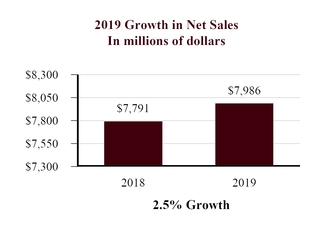
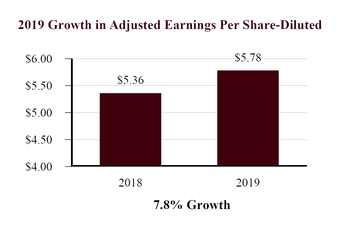
2021 Growth Net Sales in millions of dollars | 2021 Growth Adjusted Earnings per Share-Diluted(1) | ||||

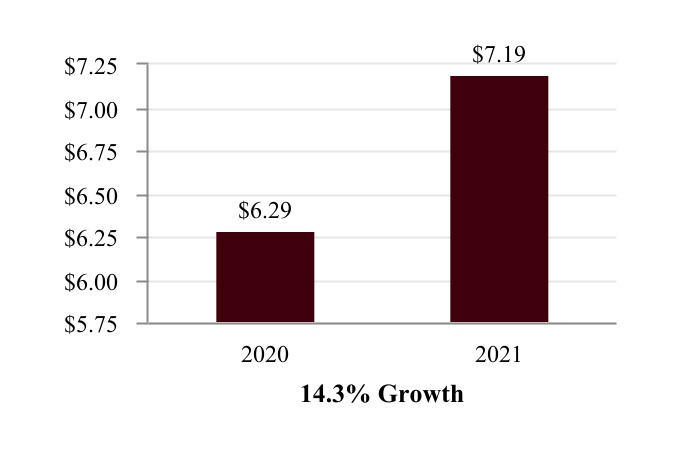
(1) While we report our financial results in accordance with U.S. generally accepted accounting principles (“GAAP”), we also use non-GAAP financial measures in order to provide additional information to investors to facilitate the comparison of past and present performance. Some of the financial targets under our short- and long-term incentive programs are also derived from non-GAAP financial measures, such as adjusted earnings per share-diluted. For more information regarding how we define adjusted earnings per share-diluted and a reconciliation to earnings per share-diluted, the most directly comparable GAAP measure, please see Appendix A.
48
Executive Compensation Philosophy
Our executive compensation philosophy is to provide compelling, dynamic, market-based total compensation tied to performance and aligned with our stockholders’ interests. Our goal is to ensure the Company has the talent it needs to maintain sustained long-term performance for our stockholders, employees and communities. The guiding principles that help us achieve this goal are compensation programs which:that do the following:
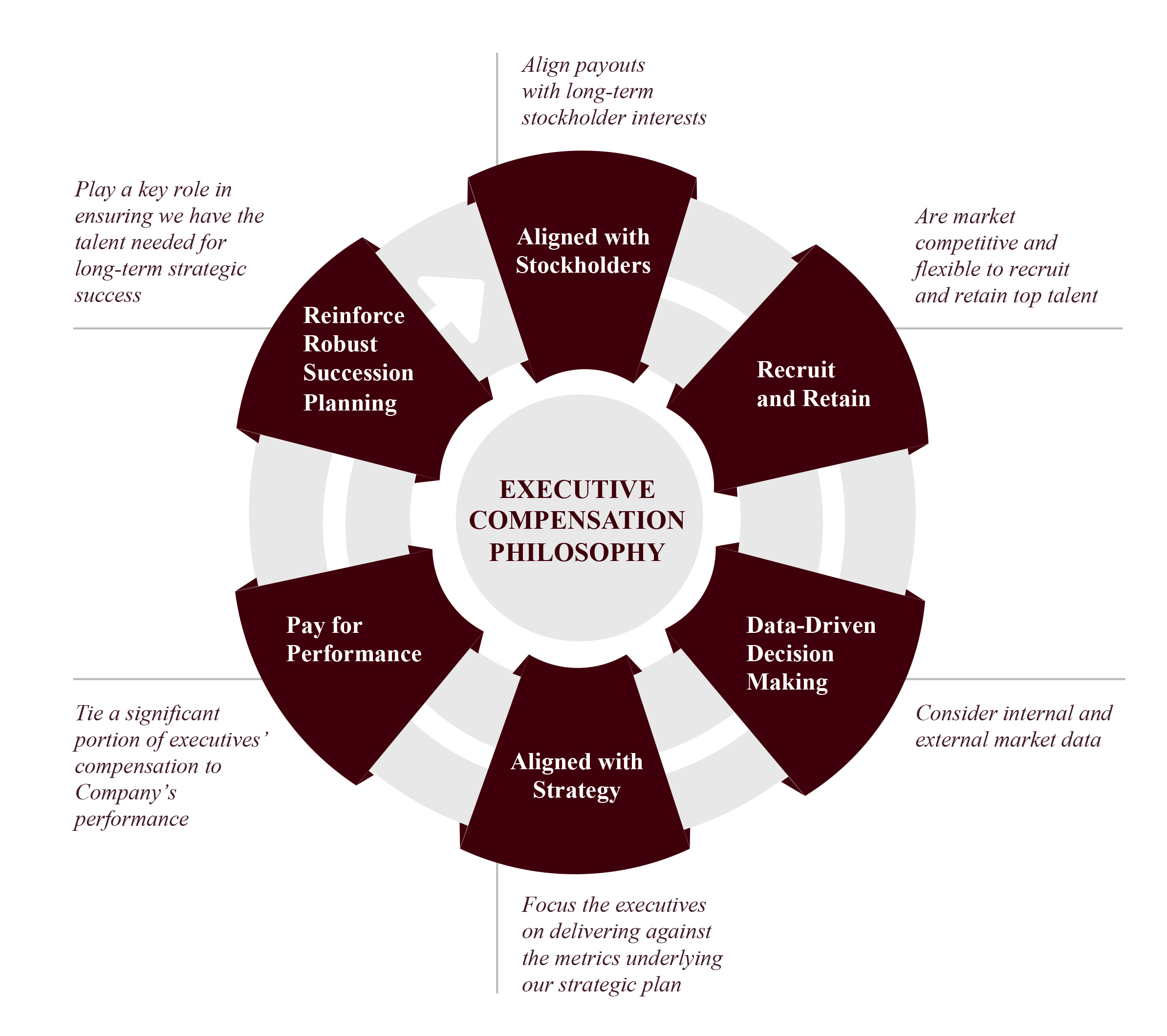
Hershey Has Strong Pay-for-Performance Alignment
The Compensation and Executive OrganizationHuman Capital Committee (the “Compensation Committee”) of our Board of Directors (the “Board”) has oversight responsibility for our executive compensation framework and for aligning our executives’ pay with the Company’s performance. We believe we have strong pay-for-performance alignment because a significant portion of each NEO’s target total direct compensation is tied to the financial performance of the Company, as well as stockholder returns. Performance goals are set with the intention to deliver peer-leading performance.
In 2019,2021, approximately 87% of our CEO’s and 73%74% of our other NEOs’ target total direct compensation excluding Ms. Little’s, was at-risk, including a substantial portion tied to stockholder value. Specifically, 34% of our Performance Stock Units (“PSUs”) were tied to Total Shareholder Return (“TSR”). Combined with the other financial and strategic metrics that determine our NEOs’ compensation, we have aligned our executive compensation program with the long-term interests of our stockholders.
Our Stockholders Strongly Approve of Our Pay Practices
Last year, our stockholders overwhelmingly approved our “say-on-pay” resolution, with more than 92%89% of the votes cast by the holders of Common Stock and more than 99%98% of the combined votes cast by the holders of the Common Stock and Class B Common Stock voting in favor. Our Compensation Committee believes the results of last year’s “say-on-pay” vote affirmed our stockholders’ support of our Company’s executive compensation program. Consequentially,Consequently, our approach to executive compensation in 20192021 was substantially the same as the approach stockholders approved in 2018.2020. At the 2017 Annual Meeting of Stockholders, our stockholders voted to continue having an annual “say-on-pay” vote as described in Proposal No. 3 –Advise– Advise on Named Executive Officer Compensation. We plan to ask stockholders to express a preference for the frequency of the “say-on-pay” vote at our 2023 Annual Meeting of Stockholders.
49
We believe our compensation and governance policies and practices are significant drivers of our stockholder support. These policies and practices include:
| WHAT WE DO | Pay for performance: A substantial percentage of each NEO’s target total direct compensation is at-risk. | |||||||
Performance measures support strategic objectives: The performance measures we use in our compensation programs reflect strategic and operating objectives, creating long-term value for our stockholders. | ||||||||
Appropriate risk-taking: We set performance goals that consider our publicly-announced financial expectations, which we believe will encourage appropriate risk taking. Our incentive programs are appropriately capped so as not to encourage excessive risk taking. | ||||||||
“Double-trigger” benefits in the event of a change in control: In the event of a change in control, the payment of severance benefits and the acceleration of vesting of long-term incentive awards that are replaced with qualifying awards will not occur unless there is also a qualifying termination of employment upon or within two years following the change in control. | ||||||||
Clawbacks and other covenants: We require our NEOs to enter into an Employee Confidentiality and Restrictive Covenant Agreement (“ECRCA”) as a condition of receipt of long-term incentive awards. Failure to comply with the ECRCA may subject the employee to cancellation of awards and a requirement to repay amounts received from awards. Under the Equity and Incentive Compensation Plan (“EICP”), when an individual’s actions result in the filing of financial documents not in compliance with financial reporting requirements, the Company has the right to recoup or require repayment of an award earned or accrued during the 12-month period following the first public issuance or filing with the Securities and Exchange Commission (“SEC”) of the non-compliant document. Beginning in 2021, the Company updated the clawback language within our One Hershey Incentive Program (“OHIP”) and long-term incentive award agreements to authorize the Compensation Committee to seek repayment in the event of intentional misconduct by a grantee that causes the Company material financial or reputational harm. | ||||||||
Significant stock ownership guidelines: Our NEOs and other executives are required to accumulate and hold stock equal to a multiple of base salary. If an executive has not met his or her ownership requirement in a timely manner, the executive is required to retain a portion of shares received under long-term incentive awards until the requirement is met. | ||||||||
| WHAT WE DON’T DO | ||||||||
Tax gross-ups: We generally do not provide tax gross-ups, except for relocation | ||||||||
Hedging Company stock: Our NEOs, directors, employees and other insiders are prohibited from entering into hedging transactions related to our stock, including forward sale purchase contracts, equity swaps, collars or exchange funds. | ||||||||
Pledging Company stock: Our NEOs, directors, employees and other insiders are prohibited from entering into pledging transactions related to our stock. | ||||||||
Re-pricings or exchanges of underwater stock options: Our stockholder-approved EICP prohibits re-pricing or exchange of underwater stock options without stockholder approval. | ||||||||
50
Changes to Our Annual and Long-Term Incentive Programs
| 2018 Annual Incentive Program Design | 2019 Annual Incentive Program Design | ||||
| Metric | Weighting | Metric | Weighting | ||
| Net Sales | 45% | Net Sales | 50% | ||
| Adjusted Earnings per Share-Diluted | 40% | Adjusted Earnings per Share-Diluted | 25% | ||
| Operating Cash Flow | 15% | EBIT Margin % | 25% | ||
| Performance Focus | Weighting | Performance Focus | Weighting | ||
| Company Financial Performance | 65% | Company Financial Performance | 75% | ||
| Individual Performance | 35% | Individual Performance | 25% | ||
| 2018 Long-Term Incentive Program Design | 2019 Long-Term Incentive Program Design | ||||
| Award Type | Weighting | Award Type | Weighting | ||
| PSUs | 50% | PSUs | 65% | ||
| Restricted Stock Units (“RSUs”) | 25% | RSUs | 35% | ||
| Stock Options | 25% | Stock Options | — | ||
| PSU Metrics | Weighting | PSU Metrics | Weighting | ||
| Relative TSR | 34% | Relative TSR | 34% | ||
Adjusted Earnings per Share-Diluted (3-Year Compound Annual Growth Rate (“CAGR”)) | 33% | Adjusted Earnings per Share-Diluted (3-year CAGR) | 33% | ||
| Net Sales (3-year CAGR) | 33% | Free Cash Flow (3-year cumulative) | 33% | ||
Payouts under the 20192021 OHIP reflect our above-targetmaximum performance in net sales and adjusted earnings per share-diluted and below-targetshare-diluted. We also delivered above target performance in EBITEarnings Before Interest and Tax (“EBIT”) Margin %. As a result, 75%100% of the 20192021 OHIP award for each NEO was based on the Company performance score of 146.18%196.88%.The remainder of the 2019 OHIP award for each NEO was determined by individual performance as described in more detail in the section entitled “Annual Incentives.”
Metric | ||||||||
Net Sales(1) | Company performance score of | |||||||
Adjusted Earnings per Share-Diluted(2) | ||||||||
EBIT Margin %(3) | ||||||||
(1)For purposes of determining the Company performance score, net sales is measured on a constant currency basis, which is a non-GAAP performance measure, and is then further adjusted to reflect the impact of divestitures and acquisitions as compared to target. To calculate net sales on a constant currency basis, net sales for the current fiscal year period for entities reporting in currencies other than the U.S. dollar are translated into U.S. dollars at the average rates during the comparable period of the prior fiscal year. For more information on our use of non-GAAP performance measures, please see Appendix A.
(3)EBIT Margin % is a non-GAAP performance measure, which is defined as adjusted operating profit divided by net sales. Adjusted operating profit is defined as reported operating profit, excluding certain items impacting comparability, which for 2021 included business realignment activities, acquisition-related costs and benefits, long-lived and intangible asset impairment charges, an adjustment to a reserve associated with a prior-year facility closure, and gains and losses associated with mark-to-market commodity derivatives.
51
2019-2021 PSU Cycle - Performance Metrics and Results
Metric | ||||||||
Total Shareholder Return(1) | ||||||||
Three-year | ||||||||
Three-year Cumulative Free Cash Flow(2)(4) | $4,310M was above target | |||||||
(1)For our 2019-2021 PSU awards, Total Shareholder Return was measured based on the average closing price of the Common Stock in the month of December 2018 as compared to the average closing price of the Common Stock in the month of December 2021.
(2)Results for our ONE Brands, LLC (“ONE”), Lily’s Sweets, LLC (Lily’s), Dot’s Pretzels, LLC (“Dot’s”) and Pretzels Inc. (“Pretzels”) businesses were excluded from the following metrics, as applicable, as these acquisitions were made subsequent to the approval of the 2019-2021 PSU cycle metrics:
• Three-year CAGR in Adjusted Earnings
